How To Know When Unexpected Pediatric Dental Crowns Are Needed

As a parent, you want the best for your child’s dental health. When a pediatric dentist recommends a dental crown, you may have concerns or questions about why it is even necessary when their baby teeth will ultimately fall out. Understanding why crowns are used in pediatric dentistry can help you make informed decisions about your child’s oral care.
What Is a Pediatric Dental Crown?
A pediatric dental crown is a tooth-shaped “cap” that covers and protects a damaged or decayed tooth. Unlike crowns for adults, which are often made of porcelain or ceramic for cosmetic reasons, pediatric crowns are typically made of stainless steel, zirconia or composite materials. They effectively restore the strength, function and appearance of a child’s tooth while preventing further decay or damage.
Why Would a Child Need a Dental Crown?
Pediatric dental crowns are not just for aesthetics; they play a crucial role in maintaining optimal oral health. Some common reasons why a child might need a dental crown include:
1. Severe Tooth Decay
Tooth decay, or cavities, is one of the leading reasons children require crowns. Baby teeth have thinner enamel than adult teeth, making them more susceptible to cavities. When decay becomes too extensive for a simple filling to restore the tooth, a crown is used to preserve the structure and prevent further damage.
2. Large Cavities or Weakened Teeth
If a cavity is too large, a regular filling may not provide enough support for the tooth. In such cases, a crown provides a durable and long-lasting solution that prevents the tooth from breaking or needing extraction.
3. Fractured or Broken Teeth
Children are active and accidents randomly happen. A fall, sports injury or just biting down on something hard can lead to a fractured or broken tooth. In cases where the damage is extensive, a crown can restore the tooth’s shape, function and strength.
4. After a Pulpotomy (Baby Root Canal)
When tooth decay reaches the pulp (the inner part of the tooth that contains nerves and blood vessels), a pulpotomy—a procedure similar to a root canal—may be necessary to remove the infected pulp. After this treatment, a crown is placed to protect and reinforce the tooth.
5. Hypoplastic or Hypomineralized Teeth
Some children have developmental conditions that cause their enamel to be weak, thin or improperly formed. These teeth are more prone to cavities, breakage and sensitivity. A crown provides extra protection and helps maintain the tooth until it naturally falls out.
6. Maintaining Space for Permanent Teeth
Baby teeth act as space holders for their permanent counterparts. Losing them too soon due to decay or damage can lead to alignment problems, requiring orthodontic intervention later. Crowns help maintain the integrity of baby teeth until they are naturally ready to fall out.
Types of Pediatric Dental Crowns
Dentists use different materials depending on the tooth’s location, the child’s needs and aesthetic concerns:
- Stainless Steel Crowns (SSCs) – Durable, cost-effective and commonly used for molars.
- Zirconia Crowns – Tooth-colored, strong and aesthetically pleasing but also a bit more costly.
- Resin or Composite Crowns – Less durable than zirconia but do blend well with natural teeth.
Is the Procedure Painful?
The process of placing a pediatric dental crown is straightforward and typically performed under local anesthesia. If your child has dental anxiety, sedation options may be available. The procedure essentially involves removing decay, shaping the tooth and fitting the crown securely in place.
Caring for Your Child’s Dental Crown
Proper oral hygiene is essential to maintaining the crown and preventing further issues from arising. Encourage your child to:
- Brush twice a day with fluoride toothpaste.
- Floss daily to remove lingering stray food particles and harmful dental plaque.
- Avoid sticky, hard or chewy foods that can dislodge the crown.
- Visit the dentist regularly for check-ups and cleanings.
Safeguard Your Child’s Smile
A dental crown may seem like a big step for your child, but it is often the best way to preserve their oral health. Protecting baby teeth until they naturally fall out helps ensure proper speech development, chewing function and space for permanent teeth that will eventually come in. When a pediatric dentist recommends a crown, it is a proactive measure to safeguard a child’s smile for the future.
Call To Learn More or Schedule a Visit
If you have concerns or questions, please feel free to discuss them with our pediatric dentist. In our experience, a well-informed parent can help create a positive dental experience for their child and instill lifelong healthy oral habits for a healthier, more appealing smile!
Healthy Smiles Breakthrough: Uplifting Ways To Promote Kids’ Oral Hygiene
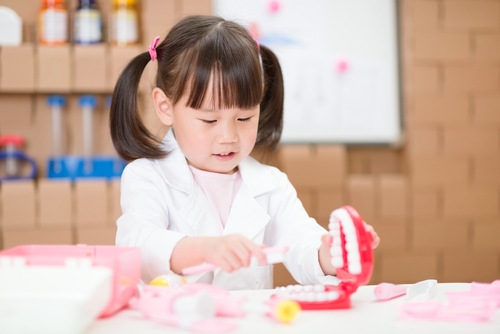
February is National Children’s Dental Health Month, a time dedicated to raising awareness about the importance of early oral care. Establishing good oral hygiene early in life paves the way for a lifetime of strong, healthy teeth and confident smiles. But sometimes—getting kids excited about brushing and flossing is not always easy. That is why we are sharing fun, creative ways to make oral hygiene enjoyable while reinforcing those essential healthy habits.
Why Early Dental Care Matters
Good oral hygiene in childhood is essential for preventing cavities, gum disease and other serious dental issues. Baby teeth may be temporary, but they play a crucial role in speech development, proper chewing and guiding adult teeth into place. The American Academy of Pediatric Dentistry advises parents to schedule their child’s first dental visit by their first birthday or as soon as the first tooth emerges Regular checkups help catch problems early and create a positive dental experience for kids.
By taking the time to teach your child proper brushing, flossing and healthy eating habits, you can help ensure strong teeth and gums for life. The best way to do this? Make it fun!
Engaging in Activities to Promote Oral Health
Celebrate National Children’s Dental Health Month by incorporating fun activities into your child’s daily routine. Here are some exciting ways to turn oral hygiene into a playful learning experience:
1. DIY Toothbrush Timer Craft
Brushing for two minutes can feel like forever for kids. Create a fun, colorful sand timer or use a stopwatch to encourage them to consistently brush for the right amount of time. You can also play their favorite song while they brush—it is a great way to make the time fly!
2. Read Dental-Themed Books
Storytime is a great opportunity to introduce positive messages about oral health. Try books like:
- The Tooth Book by Dr. Seuss
- Brush, Brush, Brush! by Alicia Padron
- The Berenstain Bears Visit the Dentist by Stan & Jan Berenstain
Reading about teeth and the dentist helps ease anxiety and makes the topic relatable and fun!
3. Make a “Plaque Attack” Science Experiment
Teach kids how plaque and cavities form with a simple science experiment. Coat a hard-boiled egg with dark soda or juice overnight, then brush it the next morning with toothpaste to see how brushing removes stains—just like on teeth!
4. Play Pretend Dentist
Role-playing a dental visit with stuffed animals or dolls and dental “tools” can make real checkups less intimidating. Let your child be the “dentist” while you or a sibling act as the patient. They can practice counting teeth, “cleaning” them and learning about what happens at the dentist.
5. Create a Healthy vs. Unhealthy Foods Chart
Cut out pictures of different foods from magazines and create a smiley tooth (healthy foods) vs. sad tooth (cavity-causing foods) chart. This visual helps kids understand which snacks help or harm their tiny chompers.
6. Reward Good Oral Hygiene
A sticker chart or small prizes for consistent brushing and flossing can be great motivators. Offer extra bedtime stories, a fun outing or a new toothbrush featuring their favorite character as a reward for good habits.
Encourage Regular Dental Visits
A child’s “dental home” is just as important as daily brushing and flossing. Regular checkups help prevent problems before they start and ensure your child feels comfortable at the dentist. Many pediatric dental offices offer a kid-friendly environment with prizes, games and interactive experiences to make visits fun and stress-free.
Make Oral Health a Family Affair
It is no secret that children mimic their parents, so let them see you prioritizing dental care! Brushing and flossing together makes the routine Feel more like an enjoyable family experience rather than a tedious task.
Start Smiling Today!
This National Children’s Dental Health Month, commit to helping your child build a healthy, happy smile—one fun activity at a time. By combining education with excitement, you can ensure that good oral habits stick for life.
Does your child need a checkup? Schedule a pediatric dental appointment today and celebrate your child’s growing smile!
Timely Tips To Make Your Child’s First Dental Visit Stress-Free And Fun

Your child’s first dental visit is an important milestone that sets the foundation for their lifelong oral health. Whether you have scheduled their first appointment for the new year or are considering doing so, understanding what to expect can help make the experience smooth and enjoyable for both you and your child.
Why the First Dental Visit Matters
The American Academy of Pediatric Dentistry recommends that children see a dentist by their first birthday or within six months of their first tooth erupting. These early dental visits help identify potential issues, establish healthy habits and familiarize your child with the dental environment, setting the foundation for familiarity and ease with lifelong dental health care. This proactive approach can prevent dental problems and reduce anxiety about future visits.
Preparing for the Visit
Preparation is key to ensuring a positive experience for your child. We have some time-tested tips to help:
- Choose a Pediatric Dentist: Our pediatric dentist specializes in treating children. Our offices are designed with child-friendly features like colorful decor, toys and kid-sized equipment to make your child feel at home.
- Talk About the Visit: Use simple, positive language to explain what will happen when you bring your child in. For example, you might say, “The dentist will count your teeth and help keep them shiny and healthy.”
- Read Books or Watch Videos: Many children’s books and videos feature characters going to the dentist. These can help your child understand what to expect in a fun and relatable way.
- Schedule Wisely: Choose a time when your child is well-rested and not hungry, as this can help them feel more comfortable, cooperative and at ease.
What Happens During the Visit
The first visit is usually short and focused on introducing your child to the dental office. Here is what typically happens:
- Warm Welcome: Our caring dental team will greet your child warmly and explain the steps in an age-appropriate way to make them feel comfortable.
- Oral Examination: Our dentist will gently examine your child’s teeth, gums and jaw to check for signs of decay, alignment issues or other concerns. For very young children, this may involve sitting on your lap during the exam.
- Cleaning (if needed): If your child is ready, our hygienist may perform a gentle cleaning to remove plaque and apply fluoride to strengthen their teeth.
- Education for Parents: Our dental team will discuss appropriate oral hygiene practices, such as proper brushing and flossing techniques, and offer guidance on teething, pacifier use and nutrition.
Building a Foundation for Oral Health
After the visit, continue the positive momentum by incorporating our dentist’s recommendations into your child’s daily routine. This may include brushing twice a day with fluoride toothpaste, flossing regularly and maintaining a balanced diet to support healthy teeth. Establishing good habits early not only helps prevent cavities but also fosters a lifelong commitment to oral hygiene. We have seen how positive experiences at the dentist build a child’s self-confidence and reduce anxiety about future appointments, creating a solid foundation for their overall, continually developing dental health.
When to Schedule the Next Appointment
Our pediatric dental team recommends visits every six months. Regular checkups ensure your child’s teeth and gums stay healthy and allow our dentist to monitor their development. We invite you to start the new year off on a healthy track by prioritizing your child’s oral health. Their first dental visit is a step toward a lifetime of healthy, happy smiles, making it one of the best investments you can make for their future health and self-confidence!
How To Give Your Child The Best Gift Of A Healthy Smile This Holiday Season

The holidays are a time for joy, family and cherished traditions. But amidst all the celebrations, it is easy to let healthy habits slide, especially when it comes to your child’s dental care. This year, give your child the gift of a healthy smile by making oral hygiene a priority, both at home and on the go. With a little preparation and creativity, you can keep your child’s smile shining bright all season long.
Start a Holiday Dental Routine Tradition
The holidays are a perfect time to make oral hygiene fun and festive. Start a family tradition of brushing and flossing together in the evening while listening to holiday music. Let your child choose a special toothbrush with their favorite holiday character or bright colors. You can even pick a toothpaste with a mild flavor that feels like a treat.
To encourage consistency, consider creating a “Tooth Fairy Advent Calendar.” Each day, reward your child with a small surprise or sticker for maintaining their dental routine. By turning oral hygiene into an exciting daily event, you will help your child develop healthy habits that last long beyond the holiday season.
Smile-Friendly Stocking Stuffers
When filling your child’s stocking, include items that promote good oral health. Festive toothbrushes, floss picks in kid-friendly shapes and toothpaste with fun flavors make excellent additions. For an extra festive touch, consider a book about dental health or a personalized tooth fairy box to keep them engaged with their smile.
You can also include tooth-friendly snacks like sugar-free gum, dried fruits with no added sugar, or holiday-themed trail mix. These alternatives are healthier for teeth and still add a bit of holiday magic.
Dental Health on the Go
Many families travel during the holidays, which can disrupt regular routines. With a little planning, you can ensure your child’s oral health stays on track, no matter where you go.
1-Start by packing a travel-friendly dental kit for your child. Include a compact toothbrush, travel-sized toothpaste, floss and a small cup for rinsing. To make it exciting, let your child decorate the kit or choose their own supplies. If you are flying, remember to check airline restrictions for liquid items.
2-While on the road, maintain regular brushing and flossing times, even if schedules are unpredictable. Use reminders like setting an alarm on your phone or linking dental care to other holiday activities, such as brushing right before opening gifts.
3-If your trip is long, encourage your child to rinse their mouth with water after meals or snacks to reduce the risk of cavities. Keep sugar-free gum or dental wipes on hand as a convenient way to clean teeth when brushing is not an option.
Keep an Eye on Holiday Treats
Unsurprisingly, the holidays often bring an abundance of sugary treats, which can increase the risk of cavities. Encourage your child to enjoy sweets in moderation and to drink water afterward to wash away any sugary residue. When possible, offer healthier options like fresh fruit, nuts or cheese, which help neutralize acid in the mouth.
A Healthy Smile for the New Year
By making dental care a part of your holiday traditions and travel plans, you are giving your child a gift that truly lasts—a healthy, beautiful smile. With these tips, you can help your child celebrate the season without compromising their oral health. From our dental family to yours, we wish you a happy holiday season and a bright start to the new year!
7 Valuable Ways To Protect Your Child’s Growing Smile

As November rolls in, we have a few important dates to highlight for your child’s health: National Brush Day on November 1 and of course, the beginning of cold and flu season. Both are excellent reminders of the importance of maintaining consistent oral health routines, especially for kids. Teaching children to brush properly and keep a clean mouth not only helps prevent cavities but also supports their immune system during this season of sniffles and sneezes.
Why Celebrate National Brush Day?
National Brush Day, celebrated right after Halloween, was designed to help children and parents reset after October’s candy rush. With sugar consumption peaking around Halloween, this day is a great reminder to reinforce positive brushing habits. While tooth decay remains one of the most common chronic diseases in children, it is largely preventable with consistent oral hygiene habits.
Teaching kids about brushing does not have to be a chore—it can be a fun family activity! Here are a few ways to make brushing engaging and effective:
- 1-Set a Brushing Routine: Dental experts recommend brushing for two minutes twice a day. Create a fun routine by using a timer, playing your child’s favorite song, or even finding a two-minute brushing video to keep them engaged.
- 2-Make It Interactive: Allow your child to pick out a toothbrush featuring their favorite character, or let them choose a fun toothpaste flavor. These small choices can make them more excited about brushing.
- 3-Use Reward Charts: For younger children, a simple chart where they earn a sticker after each brushing session can be motivating. Set a reward for filling the chart, like a fun family outing or a new book. By reinforcing these habits on National Brush Day, you are helping your child form healthy routines that can last a lifetime.
Oral Health Tips for Cold and Flu Season
With the colder months come the inevitable wave of coughs, colds and the flu. While it may not be the first thing you think about, oral health plays a role in your child’s overall wellness. Here is how you can keep their mouths and bodies healthy during this busy season:
- 1-Replace Toothbrushes After Illness: Germs can linger on toothbrushes, so after your child recovers from a cold or flu, it is wise to replace their toothbrush (or toothbrush head). This helps prevent reinfection and keeps their brushing routine fresh.
- 2-Encourage Hydration: Many medications for cold symptoms can cause dry mouth, which reduces saliva flow. Saliva is important for washing away food particles and bacteria, so encourage your child to drink water frequently throughout the day. Tuck a water bottle in their backpack on school days to make this habit easier.
- 3-Disinfect Bathroom Surfaces: Cold and flu germs can survive on surfaces for a while. Regularly disinfect bathroom surfaces, especially areas where toothbrushes are stored. Keeping brushes separate is also helpful to avoid the spread of germs among family members.
- 4-Avoid Sharing Oral Hygiene Tools: Remind kids not to share cups, toothbrushes or any oral hygiene tools with family members, as this can spread germs quickly.
The Connection Between Oral and Immune Health
Good oral hygiene is not just about avoiding cavities. A clean mouth helps reduce harmful bacteria that can travel through the bloodstream and impact other parts of the body. During cold and flu season, when the immune system is often working overtime, a healthy mouth can reduce the risk of infections and inflammation.
By celebrating National Brush Day and being proactive about oral hygiene during cold and flu season, you are helping your child build habits that protect both their smile and their health. And remember, regular dental checkups are an essential part of this process. They help catch any issues early and keep your child’s teeth in tip-top shape all year round.
Teamwork for Optimal Oral Health
This November, why not team up to make oral health a priority? If you have any questions or want to schedule an appointment for your child, please give our pediatric dental team a call today. We are here to support your child’s dental health every step of the way!
How To Curb Your Child’s Sweet Tooth From Halloween to New Year’s

As the holiday season approaches, many parents brace themselves for the inevitable influx of sugary treats. From Halloween candy to Thanksgiving pies and Christmas cookies, the temptation to indulge is constant. While the holidays are a time for joy and celebration, it is also important to protect your child’s dental health during this season of tempting sweets. With a few smart strategies, you can help your kids enjoy the festivities without putting their teeth at risk.
Healthy Halloween Treats and Moderation
The Halloween season kicks off a string of holidays where sugary treats take center stage, with candy playing a major role in the festivities. However, there are ways to manage the amount of sugar your child consumes while still letting them enjoy the spooky fun.
- Limit Candy Intake: After trick-or-treating, sort through the candy and allow your child to choose a small portion to enjoy. Set limits on how much candy they can have each day, and store the rest out of sight to prevent overindulgence.
- Healthy Swaps: Offer healthier alternatives, such as dark chocolate, fruit-based snacks or homemade treats made with less sugar. You can also hand out non-candy items like small toys, stickers or glow sticks to other trick-or-treaters to promote a balanced Halloween.
- Post-Candy Brushing: Make sure your child brushes their teeth after indulging in sugary treats. Sugar can linger on tooth enamel and feed cavity-causing bacteria, so brushing within 30 minutes after eating candy is essential to prevent tooth decay.
Thanksgiving: Mindful Eating and Smart Dessert Choices
Thanksgiving is known for its hearty meals and delicious desserts, many of which are loaded with sugar. But there are ways to enjoy the feast while still protecting your child’s teeth.
- Offer Balanced Meals: Serve a meal rich in vegetables, lean proteins and whole grains, which will help reduce the desire for sugary treats. When kids are full from a nutritious meal, they are less likely to overindulge in desserts.
- Healthier Dessert Swaps: Consider swapping traditional high-sugar desserts with healthier alternatives. For example, try pumpkin pie made with less sugar or fruit-based desserts like baked apples or berry crumble. These treats are delicious while being less damaging to your child’s chompers.
- Stay Hydrated: Encourage your child to drink water throughout their meal. Water helps rinse away food particles and sugars from teeth, reducing their risk of cavities.
Christmas: Non-Food-Centered Activities and Holiday Fun
Christmas often brings a cornucopia of cookies, candies and other sugary indulgences. To keep sugar consumption in check, focus on creating holiday traditions that do not revolve around food.
- Non-Food Activities: Engage your kids in holiday-themed crafts, games or outdoor activities like building a snowman, driving to see the festive Christmas lights or visiting an ice skating rink. This shifts the focus from sweets to active experiences.
- Homemade Treats: If baking is a part of your holiday traditions, get creative by making healthier versions of your favorite Christmas cookies. Use natural sweeteners like honey or maple syrup and reduce the sugar content in recipes. Involving your children in the preparation and baking process can also be a festive, bonding activity.
- Visit the Dentist: Schedule a dental check-up before or after the holidays to ensure your child’s teeth are healthy and to catch any developing issues early.
New Year, Better Habits
As the New Year approaches, it is a perfect time to reflect on the past year and set healthy resolutions for the year ahead. Celebrate with a special family activity, like a New Year’s brunch featuring tasty nutritious foods, to kick off the year on a healthy note and reinforce the habits that promote fun and dental wellness!
How To Make Your Child’s Gums And Teeth Healthy And Strong
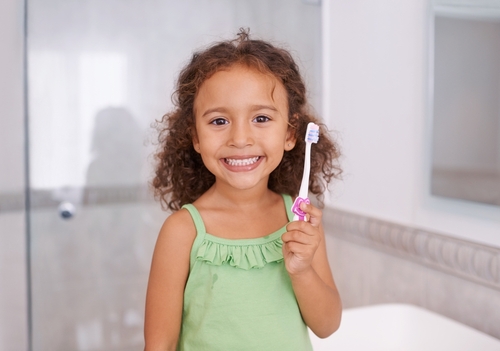
September is National Gum Care Month, a perfect time to focus on the often-overlooked aspect of pediatric dental health—your child’s gums. Healthy gums are the foundation for strong teeth and overall oral health. Teaching kids proper gum care early on can set them up for a lifetime of healthy smiles. Today we are exploring how to teach your child good gum care habits, guide you in choosing the right toothpaste and toothbrush for them, and explain the crucial role fluoride plays in their dental health.
1. Teaching Kids Proper Gum Care
Healthy gums are key to preventing gum disease, which can lead to more severe dental problems if not addressed. Here are some ways to help your child better care for their gums:
- Start Early: As soon as your child’s first tooth appears, begin cleaning their gums with a soft, damp cloth. This helps remove bacteria and gets your child used to oral care from an early age.
- Brush Properly: Once more teeth come in, switch to a soft-bristled toothbrush. Show your child how to brush gently along the gum line, where plaque tends to accumulate. Emphasize brushing for two minutes, twice a day.
- Floss Daily: Flossing is essential for removing food particles and plaque between teeth and under the gums. Start flossing your child’s teeth when two of them touch, and teach them to do it themselves as they grow older.
- Balanced Diet: Encourage a diet rich in fruits, vegetables and whole grains, which promote gum health. Limit sugary snacks and drinks that can contribute to gum disease.
- Regular Dental Checkups: Schedule regular visits to the dentist for cleanings and exams. Our pediatric dental team can spot early signs of gum issues and provide guidance on maintaining healthy gums.
2. Choosing the Right Toothpaste and Toothbrush
The right tools can make a big difference in your child’s oral care routine. Here is what to look for:
- Age-Appropriate Toothpaste: For children under three, use a smear of fluoride toothpaste (about the size of a grain of rice). For children aged three to six, a pea-sized amount is sufficient. Ensure the toothpaste has the ADA (American Dental Association) seal of approval.
- Soft-Bristled Toothbrush: Choose a toothbrush with soft bristles to protect your child’s gums and enamel. The brush should fit comfortably in their mouth and have a handle that is easy for small hands to grip.
- Fun Designs: A toothbrush with your child’s favorite cartoon character or in a fun color can make brushing more enjoyable and encourage them to brush regularly.
- Electric Toothbrushes: For older children, an electric toothbrush can be more effective at cleaning teeth and gums. Look for one with a timer to help ensure they brush for the full two minutes.
3. The Importance of Fluoride for Growing Teeth
Fluoride is a natural mineral that plays a critical role in maintaining strong, healthy teeth, especially in children. Here is why fluoride is so important:
- Strengthens Enamel: Fluoride helps to harden tooth enamel, making it more resistant to decay and cavities. This is especially crucial as children’s teeth are still developing.
- Prevents Tooth Decay: Regular exposure to fluoride can help repair early signs of tooth decay, even before it becomes visible. It is like giving your child’s teeth an extra layer of protection.
- Best Sources of Fluoride: Fluoride is commonly found in toothpaste and certain types of water. Many communities add fluoride to their tap water, so drinking tap water can be an easy way to ensure your child gets enough of this mineral. Fluoride treatments are also available at our dental office, providing an additional safeguard against cavities.
Pediatric Dental Care
National Gum Care Month is a great opportunity to focus on your child’s oral health. By teaching proper gum care, choosing the right oral care products and ensuring they get enough fluoride, you can help your child build a strong foundation for a lifetime of healthy smiles. We invite you to contact our pediatric dental team if you have questions about your child’s dental health or to schedule a visit!
Six Essential Dental Tips For A Successful School Year

As summer winds down and the school year fast approaches, parents and children alike are preparing for the transition back to school. Among the many preparations, ensuring your child’s dental health should be a top priority to help them get off to a great start. A healthy smile boosts their self-confidence while supporting overall well-being including academic performance. Review our comprehensive back-to-school dental checklist to help you ensure your child is ready for the new year!
1-Schedule a Dental Check-Up
Start by scheduling a dental check-up before the school year begins in earnest. Regular dental visits are crucial for maintaining oral health and catching potential issues early on. During the appointment, our pediatric dental team will perform a thorough examination, clean your child’s teeth and address any concerns. This is also an excellent time to ensure your child is up-to-date with preventative fluoride treatments and dental sealants.
2-Stock Up on Dental Supplies
Make sure your child has all the necessary dental supplies for the new school year. This includes a new toothbrush, fluoride toothpaste, dental floss and mouthwash as recommended by our dentist. A toothbrush with your child’s favorite character or color can make brushing more fun.
3-Educate on Dental Hygiene
Reinforce the importance of consistent dental hygiene habits. Teach your child to brush their teeth twice a day for at least two minutes each session and floss daily. Demonstrate the proper brushing and flossing techniques to ensure they are cleaning their teeth effectively. Encourage them to rinse their mouth with water after meals and snacks to reduce the risk of cavities.
4-Packing Tooth-Friendly Lunches: What to Include and Avoid
One of the simplest ways to prioritize your child’s dental health is through their diet. Packing tooth-friendly lunches helps protect their teeth from decay and keeps their smile bright. Here is our guide on what to include and avoid in your child’s lunchbox.
- Include: Crunchy Fruits and Vegetables
Fruits and vegetables like apples, carrots and celery are excellent choices for a tooth-friendly lunch. Their natural crunchiness helps stimulate saliva production, which washes away food particles and bacteria. They also contain essential vitamins and minerals that support healthy teeth and gums. - Include: Dairy Products
Dairy products such as cheese, yogurt and milk are rich in calcium and phosphates, which strengthen tooth enamel. Cheese, in particular, helps balance the pH levels in the mouth and reduces the risk of tooth decay. Opt for low-sugar choices to maximize the dental benefits. - Avoid: Sugary Snacks and Drinks
Sugary snacks and drinks are the primary culprits behind tooth decay. Avoid packing items like candy, cookies, soda and juice boxes. Instead, opt for water, unsweetened beverages, and snacks like nuts, seeds and whole-grain crackers. If your child does consume sugary foods, encourage them to rinse their mouth with water afterward.
5-Establishing a School-Year Dental Routine for Kids
Maintaining a consistent dental routine is essential for your child’s oral health, especially during the school year when schedules can become hectic. Here are some tips for establishing and adhering to their dental routine.
- Morning Routine
Incorporate brushing and flossing into your child’s morning routine. Encourage them to brush their teeth after breakfast to remove any food particles and start the day with a fresh mouth. Use a timer or a fun song to ensure they brush for the recommended two minutes. - Evening Routine
Make brushing and flossing a part of your child’s bedtime routine. Brushing before bed is crucial as it removes plaque and bacteria accumulating throughout the day. Flossing at night helps clean between the teeth where a toothbrush cannot reach.
6-Make Dental Care Fun
Turn dental care into a fun activity by providing colorful toothbrushes, flavored toothpaste and dental-themed storybooks or videos. Create a reward system to motivate your child, such as a sticker chart where they earn a sticker each time they brush and floss.
We Are Here For Your Child’s Dental Health
These essential back-to-school tips can keep your child’s smile healthier throughout the year. They help your child avoid missing school for preventative dental issues while boosting their overall health and well-being. And remember, we are always here to help your child’s smile thrive!
Awesome Pioneering Hydration Hacks To Protect Your Child’s Smile

Summer is here, bringing with it endless days of sunshine, outdoor activities and the occasional ice cream treat. While it’s essential to protect your child’s skin from the sun, it’s equally important to focus on hydration, especially when it comes to maintaining a healthy smile. Staying hydrated not only keeps your child energized but also plays a crucial role in their oral health. Let’s dive into the benefits of water, fun hydration tips, the risks of sugary drinks and a refreshing recipe for homemade flavored water.
The Benefits of Water
Water is a powerhouse when it comes to oral health. It helps wash away food particles and bacteria that can lead to tooth decay and bad breath. Drinking water after meals or snacks can neutralize the acids produced by bacteria in the mouth, reducing the risk of cavities. Moreover, water is fluoride’s best friend. Many communities have fluoridated water, which helps strengthen tooth enamel and prevent decay. Encouraging your child to drink water throughout the day ensures that their mouth stays clean and healthy, promoting a brighter, stronger smile.
Fun Hydration Tips
Getting kids to drink enough water can be a challenge, but with a bit of creativity, it can become a fun and engaging activity. Here are some smile-winning tips to make hydration a more exciting venture for your child:
- Festive Water Bottles: Splurge on colorful, themed water bottles your child will love. Let them choose their favorite characters or designs, making it a special accessory they will look forward to carrying around.
- Hydration Challenges: Set up daily or weekly challenges where your child earns stickers or small rewards for drinking a certain amount of water. Create a hydration chart and celebrate their achievements to keep them motivated.
- Flavor Infusions: Add slices of fruits like strawberries, oranges or cucumbers to their water for a burst of flavor without the added sugars of sports drinks. This not only makes the water more appealing but also provides a refreshing treat on hot summer days.
- Hydration Reminders: Use fun apps or timers that remind your child to take a sip of water regularly. Turn it into a game where they have to “beat the timer” by drinking a certain amount before it goes off.
Avoiding Sugary Drinks
Beverages like sodas, sports drinks, and even some fruit juices can be harmful to your child’s teeth. These common drinks are high in sugar and acids that erode tooth enamel, leading to cavities and other dental problems. Instead of highly sweetened drinks, opt for healthier alternatives such as flavored water or diluted fruit juices. Here are a few reasons why you should avoid popular sweetened beverages:
- Tooth Decay: Sugary drinks provide food for harmful bacteria in the mouth, leading to the production of acids that attack vital tooth enamel.
- Empty Calories: These sweetened beverages often contain empty calories that contribute to weight gain and other health issues without providing any nutritional benefits.
- Dehydration: Some sugary drinks, especially caffeinated soda, actually contribute to dehydration, making it harder for your child to stay well hydrated.
Homemade Flavored Water Recipe
Here’s a simple and fun recipe for homemade flavored water that kids will love:
Ingredients:
- 1 pitcher of water
- 1 cup of sliced strawberries
- 1 cup of sliced cucumbers
- 1 cup of fresh mint leaves
- Ice cubes
Instructions:
- Fill the pitcher with water.
- Add the washed and sliced strawberries, cucumbers and fresh mint leaves.
- Stir well and let sit in the refrigerator for at least an hour to allow the flavors to infuse.
- Serve the flavored water over ice cubes for a refreshing and hydrating drink.
This delicious and healthy flavored water is a perfect way to keep your child hydrated while avoiding the pitfalls of many sugary drinks. Bonus, it’s easy to make and can be customized with your child’s favorite fruits and herbs.
Creating Healthy, Beautiful Smiles
As you can see, keeping your child hydrated is essential for their overall health and especially for maintaining a strong, healthy smile in the years to come. By encouraging proper water consumption, making hydration fun and steering clear of unhealthy sugary drinks, you can ensure that your child enjoys a summer full of bright smiles and happy memories!
Cavity Prevention In Baby Teeth: Sure Fire Strategies For Success

Baby teeth, also known as primary teeth, play a crucial role in a child’s overall dental health and development. These tiny teeth not only help children chew and speak properly, they hold space for the permanent teeth that will eventually replace them. Maintaining the health of baby teeth is essential for ensuring a smooth transition to a healthy adult smile. Preventing cavities in these teeth is a vital part of this process.
The Importance of Baby Teeth
Healthy baby teeth are foundational for a child’s overall health. They assist in the development of clear speech and effective chewing, which are crucial for proper nutrition. Primary teeth hold the space for permanent teeth, guiding them into their correct positions. Neglecting the health of baby teeth can lead to pain, infections and issues with permanent teeth, such as misalignment and decay.
Fluoride Treatments
Fluoride is a mineral that helps strengthen tooth enamel, making it more resistant to decay. For young children, professional fluoride treatments can be a valuable tool in cavity prevention. Regular fluoride treatments can significantly reduce the risk of cavities and are especially beneficial for children at high risk of dental decay. Parents should start brushing their child’s teeth with a rice-sized amount of fluoride toothpaste as soon as the first tooth appears and gradually increase to a pea-sized amount by age three.
Dental Sealants
Dental sealants are exceptionally effective preventive measures against cavities. Sealants are thin, protective coatings applied to the chewing surfaces of the back teeth (molars), where cavities are most likely to develop. These coatings create a barrier that prevents food and bacteria from getting trapped in the grooves and pits of the teeth. Many dentists recommend sealants for children as soon as their permanent molars come in, but primary molars can also benefit from this protection, especially if a child is prone to cavities.
Proper Brushing and Flossing Techniques
Parents should begin cleaning their baby’s mouth even before the first tooth appears by gently wiping the gums with a clean, damp cloth. Once teeth emerge, brushing twice daily with a small, soft-bristled toothbrush and fluoride toothpaste becomes essential. Children should learn to brush all surfaces of their teeth, including the fronts, backs and chewing surfaces, using gentle, circular motions. Supervision and assistance from parents are necessary until children develop the dexterity to brush effectively on their own, usually around age six to eight.
Flossing between teeth also needs to be introduced as soon as two teeth touch. Flossing helps clear out food particles and harmful plaque from between the teeth and under the gumline, areas that a toothbrush simply cannot reach. Using floss picks can make the process easier for young children and help establish this vital, lifelong habit.
Regular Dental Visits
The American Academy of Pediatric Dentistry recommends that children visit a dentist by their first birthday and continue with regular check-ups every six months. These visits allow dentists to monitor the development of the teeth, provide professional cleanings, and apply preventive treatments like fluoride and sealants.
Balanced Diet and Limiting Sugary Foods
Encouraging a balanced diet rich in fruits, vegetables, whole grains and dairy products can help maintain strong teeth. Limiting sugary snacks and drinks, which contribute to cavity formation, is also crucial. Offering water instead of sugary beverages and promoting healthy snack options can make a big difference.
Preventing cavities in baby teeth requires a combination of professional care, good oral hygiene practices and a healthy diet. By implementing these strategies, parents help ensure their children’s teeth remain healthy and strong, laying the foundation for a lifetime of optimal dental health!
How To Turn Pediatric Dental Visits Into Happy Adventures

Ah, the dental visit dilemma – a tale as old as time in the realm of parenting. Just the whisper of those two words can turn a child’s sunny disposition into a tempest of trepidation. But fear not, dear adventurers, for we are about to embark on a quest to turn those dreaded appointments into exhilarating escapades. Join us as we unravel the secrets to managing dental anxiety in our little heroes and transform dental visits into enchanting adventures they’ll look forward to.
1. Set Sail Early:
Begin the quest early, even before the first tooth emerges from the depths of your little one’s gums. Introduce them to the mystical world of dentistry to familiarize them with the sights and sounds of this magical realm.
2. Choose Your Guide Wisely:
Seek out a pediatric dentist, a dental sage with specialized knowledge in caring for young adventurers. These wise wizards possess not only the skills to mend teeth but also the enthralling ability to soothe the tiniest anxious souls.
3. Enact Epic Tales:
Craft fantastical stories of dental heroism and bravery, where toothbrushes become magic wands and floss transforms into golden threads of courage. Let your young adventurer play dentist to their stuffed companions, fostering a sense of empowerment and excitement at the prospect.
4. Shower Them with Praise:
Bestow upon your young adventurer high words of praise and admiration for their bravery. Shower them with treasures of affirmation, be it colorful stickers or small tokens of valor, to celebrate their dental triumphs.
5. Paint Pictures of Possibility:
Dissolve the shadows of fear with strokes of optimism and hope. Paint vivid portraits of the importance of ongoing dental care, casting the dentist as a benevolent guardian of smiles along with his dedicated team wielding protective tooth magic.
6. Equip Them with Comfort Charms:
Arm your young champion with their trusty talismans – a familiar beloved toy or cozy blanket to ward off the chill of uncertainty. These trusted relics of familiarity will serve as beacons of comfort in the face of the unknown.
7. Unleash the Power of Distraction:
Unleash a flurry of distractions – a tome of enchanting tales, a magical melody, or a handheld device of wonders – to captivate your adventurer’s attention and whisk them away to far-off lands of imagination.
8. Harness the Breath of Dragons:
Teach your brave soul the ancient art of dragon breathing – deep, rhythmic breaths to calm the storm within. Encourage them to summon the breath of dragons to quell their fears and restore tranquility.
9. Illuminate the Path:
Illuminate the path ahead with the radiant light of your own courage. Show your young apprentice that bravery knows no bounds, inspiring them to follow in your noble footsteps.
10. Revel in the Afterglow:
Celebrate the triumph of your young knight with a feast fit for royalty or an adventure of their choosing. Let the echoes of their victory ring through the halls, reinforcing their courage and fortitude so they can look forward with anticipation for their next visit.
We Are Here To Help
So, dear parental adventurers, fear not the oral health journey ahead, for with a sprinkle of magic and a dash of courage, together we shall turn pediatric dental visits into wondrous odysseys filled with laughter, smiles and endless possibilities. We are truly honored to help your little one establish an invincible dental foundation for a lifetime of healthy, happy smiles!
The Ultimate Parent’s Guide To Fearless Sports Protection

April is not just a time for blooming flowers and trees welcoming the warmth of spring; it is also National Facial Protection Month. This month serves as a crucial reminder for parents and guardians about the significance of safeguarding children’s smiles during sports and recreational activities. Engaging in sports is a fantastic way for children to develop physically and socially, yet it also poses risks to their dental health. Facial and dental injuries are among the most common types of injuries young athletes may face. Thankfully, such injuries can be significantly reduced or even prevented with the right protective gear.
Understanding the Risks
Sports and recreational activities contribute to approximately 36% of dental injuries incurred by children. These injuries can range from chipped or broken teeth to more severe concerns like jaw fractures and cuts to the soft tissues of the mouth. The impact of these injuries goes beyond just the immediate physical harm, affecting the child’s appearance, self-esteem and sometimes leading to long-term dental issues.
Types of Protective Gear
Protecting your child’s smile while they stay active in sports involves equipping them with the appropriate protective gear. The main types of protective equipment include:
- Mouth Guards: These shields are essential for nearly all sports, especially contact sports including football, basketball, soccer and martial arts. Mouth guards cushion blows that might otherwise cause broken teeth, injuries to the lips and face, and even help protect against jaw fractures.
- Helmets: Helmets are vital for sports like baseball, football, hockey, cycling and skateboarding. They provide protection not just to the head but also to the face. Some helmets come with face shields, which are particularly beneficial in sports where flying objects are a concern.
- Face Shields: Sports such as hockey and lacrosse often require face shields, which protect the face from direct hits. They can be used in conjunction with helmets for added protection.
Selecting the Right Protective Equipment
Choosing the right protective gear is paramount to ensure its effectiveness. Here are some tips for selecting the appropriate equipment:
- Fit is Key: Ensure that any protective gear fits your child properly. Ill-fitting equipment can be uncomfortable and may not offer full protection. It is worth consulting with a professional to get the right fit.
- Quality Matters: Opt for high-quality equipment that meets the safety standards set by sports organizations. This can mean the difference between a minor incident and a serious injury.
- Mouth Guard Types: There are three main types of mouth guards: stock, boil-and-bite and custom-fitted. Custom-fitted mouth guards, made by a dentist, offer the best protection and comfort but are also more expensive. Boil-and-bite mouth guards are a more affordable alternative and offer a reasonable fit after being softened in hot water and then formed into the shape of your child’s mouth.
The Impact of Prevention
Preventative measures, such as wearing the right protective gear, can significantly reduce the risk of your child incurring dental injuries during sports activities. Educating children on the importance of facial protection and making it a non-negotiable part of their sports attire is crucial. Encourage your child to always wear their protective gear during both practice and games. As we observe National Facial Protection Month, let us commit to making facial protection a priority for our young athletes. Not only will this help keep their smiles safe, but it will also allow them to enjoy the sports they love with peace of mind.
From First Teeth to Healthy, Beautiful Childhood Smiles

It is never too early to help your child learn good dental habits. Instilling robust dental hygiene practices from a young age is crucial for their ongoing development. Early habits form the cornerstone of a lifetime of good dental health. Educating children on the correct techniques for brushing and flossing, the importance of regular dental check-ups, and the benefits of fluoride in preventing tooth decay is essential for their smile’s development.
However, dental health doesn’t stop at the bathroom sink. It extends to the kitchen table. A balanced diet, low in sugars and high in nutrients, plays a significant role in maintaining healthy teeth and gums. By integrating these practices into their daily routines, children can avoid many common dental problems that might otherwise arise.
Understanding and Preventing Childhood Dental Issues
Cavities, tooth decay and early tooth loss constitute some of the most prevalent dental issues among children today. These conditions not only cause discomfort and pain but can also lead to more serious health complications if left unaddressed. Parents need to be vigilant, looking out for signs of dental problems and seeking prompt treatment.
Prevention is key, with regular dental check-ups allowing for early detection and treatment of potential issues. Additionally, innovative preventive measures such as dental sealants offer an extra layer of protection against cavities, especially in those back molars where brushing might not reach all the nooks and crannies. Furthermore, the use of protective gear during sports can greatly reduce the risk of dental injuries, safeguarding children’s smiles as they engage in physical activities without succumbing to dental trauma.
Understanding the Link Between Your Child’s Dental Health and Overall Health
The significance of dental health transcends beyond just teeth and gums; it is intricately linked to your child’s overall health and daily quality of life. Chronically poor oral hygiene can lead to gum disease, which has been associated with other serious health concerns, including heart disease and diabetes. Moreover, dental problems can negatively impact your child’s nutrition, speech development and self-esteem. Ensuring good dental health is not just about preventing cavities but also about supporting your child’s holistic development and overall well-being.
How National Children’s Dental Health Month Makes a Positive Difference
National Children’s Dental Health Month is an opportune time to recommit to the dental health of our children. By focusing on these key areas—establishing good dental habits developed early, preventing common dental issues and understanding the broader health implications of oral hygiene—we can make a lasting impact on their young lives and help them grow up with healthier smiles.
Schedule Your Child’s Next Dental Check-Up and Exam
This month is a great time to focus on teaching, inspiring and motivating your child by prioritizing their dental health. Together, we can build a foundation of healthy habits that will benefit your child for the rest of their life, proving that a little effort today can lead to a lifetime of healthier, more confident smiles later. If you would like to take National Children’s Dental Health Month as an opportunity to schedule a check-up and exam for your child, we are happy to help, and invite you to give us a call today! Your child deserves quality dental care!
Healthy Teeth: Pediatric Dental Advice For A Sweet Valentine’s Celebration

Valentine’s Day is a delightful occasion filled with love, joy, and, unfortunately, sugary treats that can wreak havoc on your child’s dental health. As parents, it’s essential to strike a healthy balance between indulging in memory-making festivities and safeguarding your little one’s precious smile. With a few simple strategies and mindful choices, you can ensure that Valentine’s Day remains sweet without sacrificing your child’s oral well-being.
1-Swap Sugary Treats for Healthier Alternatives:
Instead of loading up on hard candies, gummy or sticky sweets, that are notorious for causing cavities, consider opting for healthier alternatives. Fresh fruit skewers, yogurt-covered strawberries, or homemade fruit popsicles are not only delicious but also much gentler on your child’s chompers. These options provide a refreshing burst of flavor without the harmful sugars that often lead to tooth decay.
2-Moderation is Key:
While it’s tempting to indulge in an abundance of sugary confections on Valentine’s Day, moderation is crucial when it comes to protecting your child’s dental health and budding smile. Encourage your little one to enjoy their favorite treats in moderation, and emphasize the importance of savoring each bite slowly. By limiting the frequency and quantity of sugary snacks, you can reduce the risk of cavities while still allowing your child to indulge in the festive holiday spirit.
3-Embrace Non-Edible Treats:
Who says Valentine’s Day treats have to be edible? Get creative and explore non-edible gift options that are just as fun and exciting for your child to enjoy. Consider gifting them with colorful stickers, temporary tattoos, small toys, or craft supplies that will spark their imagination and keep them entertained without compromising their dental health. Why not surprise them with oral hygiene supplies; a cool new toothbrush, fruit-flavored toothpaste, and even fun flossers made for kids!
4-Encourage Proper Oral Hygiene:
Remind your child about the importance of maintaining a consistent oral hygiene routine, especially during Valentine’s Day fun. Encourage them to brush their teeth thoroughly after enjoying sweet treats, making sure to reach all surfaces for a thorough cleaning. Moreover, remember to include flossing in their oral care routine. Consistent flossing plays a crucial role in eliminating food debris and plaque between their tiny teeth, warding off the onset of decay and gum disease.
5-Lead by Example:
Children often mimic the behaviors of their parents, so lead by example and demonstrate good oral hygiene habits yourself. Show your child the importance of brushing and flossing regularly, and make it a fun and interactive activity that you can do together as a family. By prioritizing your own dental health, you set a positive example that will inspire your child to want to do the same. After all, kids often love copying the actions of those they look up to!
6-Schedule a Post-Valentine’s Day Dental Checkup:
After the Valentine’s Day festivities have come to an end, schedule a post-holiday dental checkup for your child. A cleaning and examination can help detect the signs of developing tooth decay early on and address any concerns before they escalate. Plus, it’s a great opportunity to reinforce the importance of oral health with your child and celebrate their cavity-free smile!
Call Today!
As you can see, Valentine’s Day doesn’t have to spell disaster for your child’s dental health. With a mindful approach, healthier alternatives and a focus on moderation and proper oral hygiene, you can ensure that your little one enjoys a cavity-free holiday filled with love and “sweet” treats while protecting their precious smile. If you would like to schedule your child’s visit with our team, we invite you to give us a call today!
Healthy Smiles for the New Year: Setting Dental Goals for Kids in 2024
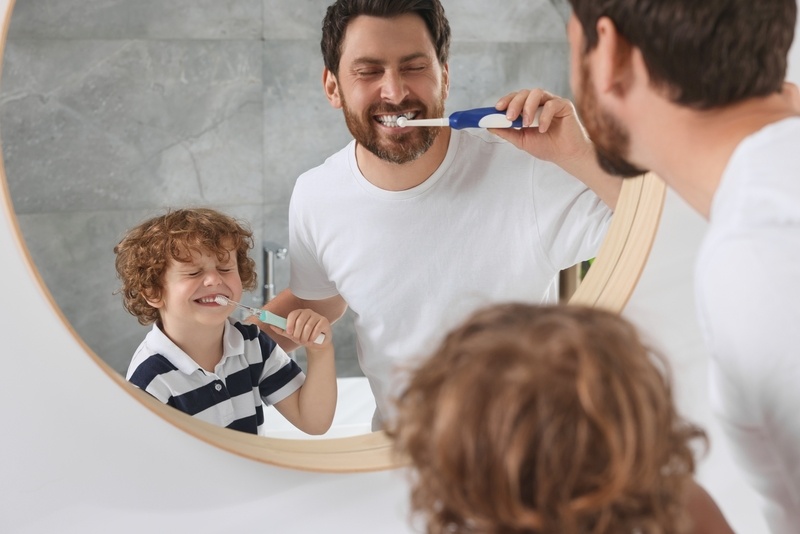
As we welcome the arrival of the New Year, now is an ideal time for parents to focus on their children’s oral health by establishing realistic dental objectives in the months ahead. A thriving smile not only enhances your child’s overall mental and physical well-being but also forms the basis for a lifetime of positive oral hygiene habits. The following are some ideas to help you foster and maintain your child’s healthiest smile in 2024.
Begin the Process Early in Childhood
The journey to a healthy smile begins in infancy. As a parent, you’ll want to gently clean your baby’s gums with a soft cloth or toothbrush designed for infants. As soon as their first tooth emerges, usually around six months, it’s time to introduce a small amount of toothpaste and a soft-bristled toothbrush into your child’s daily routine. Starting early establishes a daily practice that helps your child become accustomed to the idea of oral care, similar to their bath time routine.
Age-Appropriate Milestones
Understanding age-appropriate dental milestones is crucial for parents. By age 3, children should have a full set of primary (baby) teeth. It’s at this stage that regular dental check-ups become essential for your child. These initial appointments serve the dual purpose of overseeing your child’s dental growth and providing you with information on implementing correct oral care practices.
Make Dental Care Fun
Turning dental care into a fun and engaging activity is key to fostering positive future habits. Consider letting your child choose a colorful toothbrush or toothpaste with their favorite characters. Create a playful brushing routine by playing music or singing a toothbrushing song. Reinforce the importance of brushing and flossing by turning it into a family activity, promoting a sense of unity in maintaining healthy smiles together.
Establish a Consistent Routine
Consistency is the cornerstone of good oral hygiene habits. Solidify the habit of brushing your child’s teeth twice daily for at least two minutes each time. Follow a morning and evening routine to instill the importance of regular dental care like clockwork. This consistency helps make oral hygiene a natural part of your child’s daily life that they can look forward to.
Reward Positive Behavior
Positive reinforcement goes a long way in promoting healthy habits. Consider creating a reward system for consistent oral care, such as a sticker chart or a small treat after successful brushing. Celebrate achievements, like a cavity-free dental check-up, to motivate your child to maintain their dental goals throughout the year as they grow.
Monitor Orthodontic Development
Around age 7, it’s advisable to schedule an orthodontic consultation. While not all children require early orthodontic intervention, an initial assessment can identify potential issues and allow for timely intervention if necessary. Addressing orthodontic concerns early can also contribute to a smoother and more effective treatment process overall.
Set a Positive Example
Kids acquire knowledge by watching their parents. You can set a positive example by prioritizing your own oral health for your child to model. Brush and floss together as a family, and make dental check-ups a shared experience. Demonstrating a commitment to oral care creates a supportive environment for your child to adopt and maintain healthy habits for a lifetime of healthier smiles.
Healthy Smiles Year Round
A healthy smile is a gift that lasts a lifetime, and setting dental goals for your child in 2024 is an invaluable New Year’s resolution. By starting early, incorporating fun elements into oral care, and maintaining consistency, you can set your child on the path of proper oral development while maintaining a confident, healthy smile year round!
Holiday Gift Giving for Your Child’s Best Smile

‘Tis the season to be jolly, and what better way to spread cheer than by giving the gift of a healthy smile to the children in your life? This holiday season, consider choosing presents that not only bring joy but also promote better oral health. From fun toys to educational books and engaging activities, there are plenty of dental-friendly gift options for kids of all ages.
Festive Gifts To Make Dental Care Fun
1. Toothbrush Timers
Transforming the often mundane task of brushing into an exciting game, toothbrush timers make for an excellent gift for kids. These timers encourage children to brush their teeth for the recommended two minutes by making it a fun challenge. Look for timers with colorful designs and playful characters to make the experience even more enjoyable.
2. Musical Toothbrushes
Combine oral care with entertainment by gifting a musical toothbrush. These brushes play catchy tunes or popular songs for the duration of brushing, turning the routine into a mini dance party. Kids will be more inclined to brush for the recommended time as they bop along to their favorite tunes.
3. Children’s Dental Books
Educational gifts are always a hit, and dental-themed children’s books are a fantastic way to teach kids about the importance of oral health. Look for books with engaging stories and vibrant illustrations that capture your child’s imagination while imparting valuable lessons about proper dental care and hygiene.
4. Healthy Snack Gift Baskets
Promote good eating habits and oral health simultaneously with a gift basket full of delicious and tooth-friendly snacks. Include items like crunchy fruits and vegetables, cheese and nuts, which not only satisfy their taste buds but also contribute to dental well-being by stimulating saliva production while cleaning teeth.
5. Water Flossers for Kids
Make flossing a breeze for kids by introducing them to water flossers designed specifically for their age group. These devices use a gentle stream of water to clean between teeth, making it a more enjoyable alternative to traditional flossing. Opt for models with bright colorful designs to capture their attention.
6. Chewable Toothbrushes
For younger children who are still developing their motor skills, chewable toothbrushes can be a playful introduction to oral care. These toothbrushes, designed for teething toddlers, serve a dual purpose by soothing sore gums and cleaning emerging teeth.
7. Character-themed Dental Kits
Enhance the excitement of oral care with character-themed dental kits featuring beloved cartoon or movie characters. These kits typically include a toothbrush, toothpaste and floss, all adorned with your child’s favorite characters. Personalizing oral care items makes their routine feel more like an adventure than a chore.
8. Sugar-free Chewing Gum
Include a pack of sugar-free chewing gum in your gift selection. Chewing gum promotes saliva production, which helps neutralize acids and prevent tooth decay. Choose flavors your child loves to make it a tasty and healthy treat.
9. Surprise Your Teen
Surprise your teenager with dental gifts that blend oral care and style. Consider a sleek electric toothbrush with customizable settings for a tech-savvy touch. Brighten their smile with whitening strips or a trendy water flosser. These thoughtful gifts promote optimal dental health with a touch of holiday cheer.
Happy, Healthy Holidays
This holiday season, consider the gift of a healthy smile for the children in your life. By choosing dental-friendly presents that encourage good oral habits, you not only contribute to their overall well-being but also make oral care a positive and enjoyable part of their daily routine. From our dental family to yours, we wish you and your loved ones happy holidays and happy brushing!
National Brush Day: A Parent’s Guide to Children’s Dental Care
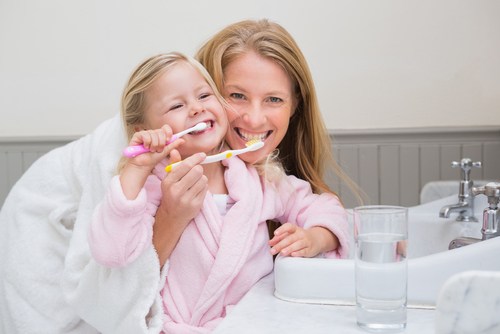
National Brush Day, celebrated on November 1st, is the perfect occasion to highlight the importance of maintaining your child’s oral health as they grow. As a parent, it’s essential to instill good dental habits early on, and choosing the right tools and techniques can make a significant difference in your child’s developing smile. Today we will discuss various types of toothbrushes suitable for children, effective toothbrushing techniques, and just how much clean teeth and gums play a pivotal role in protecting their oral health over the years.
Choosing the Right Toothbrush
When it comes to selecting the best toothbrush for your child, you have some cool options:
- Manual Toothbrush: These traditional toothbrushes are available in a wide variety of colors and designs, making it easy to find one that your child will love. Look for soft-bristled brushes with smaller heads to ensure they fit comfortably in your child’s mouth and won’t cause any discomfort as they navigate cleaning their teeth and gums.
- Electric Toothbrush: Electric toothbrushes are an excellent choice for kids who may not have the dexterity to brush effectively with a manual toothbrush. Many electric toothbrushes designed for children come with fun features like timers and music to make brushing an enjoyable experience, which encourages them to want to brush.
- Character-Themed Toothbrush: Toothbrushes featuring your child’s favorite characters or superheroes can make brushing a fun and exciting activity for them to look forward to. These are often available in both manual and electric options.
- Silicone Toothbrush: Silicone brushes are gentle on the gums and ideal for younger children who are just starting to brush their teeth. They effectively clean between teeth while removing plaque from along the gumline. They are also great for teething babies as they can be used as a gum massager.
Effective Toothbrushing Techniques
Selecting the right toothbrush is just the first step in your child’s daily oral hygiene care. Teaching your child how to brush their teeth effectively is equally important:
- Proper Brushing Time: Encourage your child to brush for at least two minutes each toothbrushing session. To enhance their experience, consider employing a timer or selecting a lively song to engage them fully.
- Brushing Twice a Day: Ensure your child brushes in the morning and before bedtime to remove stray food particles and plaque buildup.
- Soft Brushing: Teach your child to use gentle, circular motions as they clean. Aggressive brushing can damage tooth enamel and irritate the gums.
- Use a Pea-Sized Amount of Toothpaste: For children under three, you can use a smidge of toothpaste (the size of a rice grain). For those aged three to six, a pea-sized amount of fluoride toothpaste can be used. Make sure they do not swallow any toothpaste.
- Don’t Forget the Tongue: Remind your child to gently brush their tongue to remove lingering bacteria and keep their breath fresh.
The Importance of Clean Teeth and Gums
Clean teeth and gums are essential for a child’s overall oral health and well-being. By instilling good dental habits and ensuring regular brushing, you help your child in several ways:
- Preventing Tooth Decay: Regular brushing helps remove stray food particles and plaque buildup, reducing your child’s risk of cavities.
- Healthy Gums: Proper oral care minimizes your child’s risk of gum disease, which can lead to more severe dental issues later if left untreated.
- Fresh Breath: Good dental hygiene ensures your child’s breath remains fresh and free from unpleasant odors.
- Confidence: A bright and healthy smile can boost your child’s growing self-esteem and confidence.
Protect Your Child’s Oral Health
This National Brush Day (and every day), make it a priority to help your child’s smile thrive. Choose the right toothbrush for their unique needs, teach them effective toothbrushing techniques and emphasize the importance of having clean teeth and gums. These early habits will set the stage for a lifetime of good oral health and a bright, confident smile. We welcome you to give our pediatric dental team a call if your child needs an appointment for their first dental visit or to get their teeth checked and cleaned. Their smile will thank you!
How To Manage Your Child’s Halloween Treats From a Pediatric Dental Perspective

Next to Christmas, Halloween is arguably the most popular holiday for children, filled to the brim with creepy costumes, spooky fun, and, of course, candy and chocolatey treats. While the joy of trick-or-treating is undeniable, it’s essential for parents to be mindful of their children’s dental health during this treat-filled season. We are excited to share some valuable tips on managing Halloween candy consumption while helping your child enjoy this time without sacrificing their dental health along the way.
1. Candy Choices Matter:
- Not all candies are created equal when it comes to your child’s smile. Some are actually less harmful to teeth than others.
- Our pediatric dental team recommends removing sticky, chewy candies (like caramels and taffy) from your child’s haul, as they cling to teeth and actively promote tooth decay.
- Opt for candies that dissolve quickly, like sugar-free gum or dark chocolate, which are less likely to stick to teeth and cause cavities.
2. Portion Control is Key:
- Moderation is key to managing your child’s Halloween candy consumption. Help them enjoy their treats in moderation, preferably after a meal.
- Consider setting limits on the number of candies they can have each day, ensuring they don’t overindulge.
- After Halloween night, store excess candy out of reach, allowing your child to have a few pieces a day as a special treat.
3. Establish a Post-Halloween Dental Routine:
- After indulging in Halloween candy, it’s crucial to establish a healthy dental routine.
- Encourage your child to brush their teeth thoroughly after consuming candy, ideally within 30 minutes to reduce the risk of cavities.
- Supervise younger children to ensure they brush effectively and use fluoride toothpaste to help protect tooth enamel.
- Flossing is essential to remove candy debris from between teeth and rinsing well afterward, getting rid of any lingering sugary residue.
4. Use Halloween as an Educational Opportunity:
- Halloween can be a great time to teach your child about the importance of oral hygiene. Share how sugar can lead to tooth decay and cavities, and the role of brushing and flossing in preventing dental issues.
- Explain how sugar can lead to cavities, discussing the concept of “treats in moderation” to help them make responsible choices. Explain to your child that they can savor their favorite candies and treats but in limited quantities. This helps protect their oral hygiene while developing valuable life skills in making balanced choices when it comes to indulgence and self-control.
5. Choose Candy Alternatives:
- Consider organizing a “candy trade-in” where they can exchange some of their candies for non-sugary rewards.
- Offer candy alternatives like nuts, pretzels, sugar-free gum, party favors, trading cards, stickers, pencils, cool erasers, toys, temporary tattoos, false teeth, small bottles of bubbles and small games; the possibilities are endless!
6. Schedule a Post-Halloween Dental Checkup:
- Arrange for a dental checkup for your child shortly after Halloween to catch any early signs of cavities or other developing dental issues.
- Our pediatric dentist can provide professional advice and treatments, such as fluoride treatments or dental sealants, to protect your child’s teeth from tooth decay and cavities.
Hauntingly Happy Trick Or Treating
Halloween is a time for fun and indulgence; you can take proactive steps to manage your child’s candy consumption and protect their dental health. We hope these tips ensure your child enjoys the spooky celebrations while maintaining a beautiful, cavity-free smile. We invite you to schedule a post-Halloween dental checkup to keep your child’s oral health in tip top shape. From our dental family to yours, we wish you and yours a safe and happy Halloween!
Cherish Every Tiny Tooth: Your How To Guide to Happy Baby Smiles

September is a time to celebrate healthy smiles, and that includes the tiniest members of our families. As parents, it’s natural to want the best for your children, and this includes their oral health. Taking care of your baby’s gums and emerging chompers is an essential part of their overall health and well-being. In this blog, we’ll delve into the world of infant oral care, offering you practical tips on how to nurture your baby’s smiles from the very beginning.
The Significance of the First Dental Visit
Like many parents, you may wonder when you should start thinking about your child’s oral health. It may surprise you to discover that it’s recommended that the journey begins even before those first baby teeth make their debut. As soon as your baby’s first tooth comes through, (or by their first birthday), it’s time for that first visit to our pediatric dentist.
Why Start So Early?
Firstly, it helps your baby become familiar with the dental environment, reducing potential fear and anxiety that might be associated with dental visits down the road. A positive early experience can help foster positive experiences later. It also gives our dentist a chance to check for any early signs of dental issues and provide guidance on proper oral care techniques for your baby. Keep in mind that these first visits are less about treatment and more about establishing a positive relationship with your developing child’s oral health care.
Safe Teething Practices
Teething is often a challenging time for babies, parents and caregivers. Those tiny teeth pushing through the gums can lead to discomfort, irritability, and even sleepless nights for your little one (and you). Thankfully, there are safe and effective ways to ease your baby’s teething discomfort.
One popular method is to use teething toys. These specially designed toys can be chilled in the refrigerator (not frozen in the freezer) to provide soothing relief when your baby chomps on them. You can also use a clean, damp washcloth (cooled in the fridge) to gently massage your baby’s gums for soothing relief. Just be sure to supervise your little one to prevent choking hazards.
Note: It’s important to avoid using teething gels that contain numbing agents unless recommended by your child’s pediatrician or our pediatric dentist. Additionally, never tie teething rings or any other objects around your baby’s neck, as it can be dangerous.
Nurturing a Positive Relationship with Baby’s Oral Hygiene
The habits we establish in childhood often stick with us throughout life, and this holds true for oral hygiene as well. As a parent, you have a pivotal role in teaching your child good dental habits from the very beginning.
Start by cleaning your baby’s gums even before their first tooth arrives. You can use a soft, damp cloth or just a clean finger. Once the first tooth emerges, switch to a soft-bristle toothbrush made especially for infants. You can use a tiny bit of fluoride toothpaste, about the size of a grain of rice, to gently clean their teeth.
As your child grows, make brushing their teeth a fun and positive experience. Sing songs, use colorful toothbrushes, and let them choose their toothpaste flavor. It’s all about making oral hygiene a part of their daily routine so that they can enjoy it and feel good about themselves.
Coupled with a balanced diet rich in fruits, vegetables, grains and meats help fortify their developing smiles. Remember that what your child consumes can have a significant long term impact on their dental health.
Start Now!
Caring for your baby’s oral health is an integral part of their development. Starting early with positive dental visits, safe teething practices, and a positive approach to oral hygiene sets the stage for a lifetime of healthy smiles and self-confidence.
As September rolls around, let’s celebrate not only the healthy smiles of our little ones but also the commitment we make as parents to keep those smiles bright and happy for years to come. Remember, healthy baby teeth lead to healthier adult teeth later!
Smiles in the Classroom: The Connection Between Oral Health and Academic Success

As parents, educators, and healthcare professionals, we all strive to provide the best environment for children to flourish academically. The link between oral health and academic performance in children is profound. Dental problems, including toothaches, cavities, and gum issues, can impact your child’s ability to focus and learn effectively. In fact, consistent pediatric dental care promotes a healthier smile and improved school performance for your child!
The Impact of Dental Problems on Academic Performance
- Toothaches: A toothache is not just a painful inconvenience but a major distraction for your child in the classroom. Constant pain causes difficulty concentrating on lessons and participating in class activities, affecting their overall engagement and comprehension. Moreover, sleep disturbances caused by toothaches often lead to daytime fatigue, making it harder for your child to stay alert and attentive during long school hours.
- Cavities: Untreated cavities can cause chronic discomfort and sensitivity, making it difficult for your child to eat, speak or even smile comfortably. Proper nutrition is vital for their growth and cognitive development, and cavities can disrupt normal eating patterns, potentially affecting energy levels and overall health. Cavities can result in embarrassment or self-consciousness for reduced self-esteem and social interactions in the school environment.
- Gum Issues: Gingivitis and other gum problems can create soreness and bleeding, leading to discomfort while eating or brushing. Children with gum issues may avoid brushing their teeth, exacerbating the problem and increasing the risk of dental decay. Besides the physical discomfort, children may feel embarrassed about their gum issues, lowering their confidence in social settings and classroom interactions.
The Role of Pediatric Dentistry in Promoting a Healthy Smile
- Early Prevention and Intervention: Our pediatric dental team plays a crucial role in early detection and prevention of children’s dental issues. Regular dental checkups allow our team to detect and address potential problems before they worsen. By promoting good oral hygiene habits and preventive measures, like fluoride treatments and dental sealants, our dentist can help your child maintain healthy teeth and gums, reducing the risk of dental problems affecting academic performance.
- Oral Health Education: Our dentists not only treat dental issues but also educate children (and parents) about the importance of good oral health. We teach proper brushing and flossing techniques, encourage a balanced diet and emphasize the importance of regular dental checkups.
- Building Confidence: A healthy smile can significantly impact your child’s self-esteem and confidence. Our pediatric dentist addresses physical dental problems and works to improve the appearance of your child’s smile. Cosmetic procedures, like teeth alignment and whitening, can help children feel more comfortable and confident, positively influencing their interactions with peers and teachers.
Book Your Child’s Next Appointment
By focusing on preventive measures, oral health education, and early intervention, our pediatric dental team plays a vital role in promoting your child’s healthy smile development and improved academic performance. As school gets ready to begin, now is the time to book your child’s next dental visit with our pediatric dental team. Remember, your child’s healthy smile paves the way for a brighter future in the classroom and beyond!
Fun and Healthy Summer Treats for Kids

Summer is here, and kids eagerly await their favorite season of outdoor play and endless fun. As a parent, you want to ensure that your children enjoy refreshing snacks during the hot summer days, but you also want to keep their teeth healthy and cavity-free. Don’t worry! We’ve got you covered with tooth-friendly snack ideas that are both delicious and nutritious. Here are some fun and healthy summer choices to treat your children!
Tooth Friendly Treats
- Watermelon Popsicles: Nothing beats the juicy sweetness of watermelon on a scorching summer day. Make it even more exciting by turning watermelon slices into popsicles. Insert popsicle sticks into cut-up watermelon wedges and freeze them. These naturally sweet treats are packed with vitamins and hydration, perfect for keeping your little ones refreshed.
- Yogurt Parfait: Create a colorful and tooth-friendly treat by layering low-sugar yogurt, fresh berries, and granola in a clear cup or jar. The creamy yogurt provides calcium for stronger teeth, while the berries add a burst of antioxidants good for your child’s health. Topped with crunchy granola to add a satisfying texture will also keep the kids energized.
- Frozen Banana Bites: First, peel and cut ripe bananas into bite-sized pieces. Next, dip them into Greek yogurt or melted dark chocolate, and then roll them in shredded coconut or crushed nuts. Place them on a baking sheet lined with parchment paper and freeze. Your child will love these frozen banana bites, which are not only yummy but also a great source of potassium and fiber.
- Fruit Kebabs: Encourage your kids to eat a variety of summer fruits by making colorful fruit kebabs. Thread bite-sized fruit pieces onto skewers. Alternate between different types of fruit, like strawberries, pineapple chunks, grapes, and kiwi slices. This interactive snack is packed with essential vitamins and minerals while gentle on their teeth.
- Homemade Fruit Popsicles: Create popsicles using a mixture of blended fresh fruits and 100% fruit juice. Avoid adding any extra sugar. All you need to do is pour the mixture into popsicle molds or even tiny paper cups. Then insert your popsicle sticks, and freeze this sure-to-please treat until frozen. These homemade fruit popsicles are a fantastic alternative to store-bought versions, as yours are free from artificial additives and tooth-destroying high-fructose corn syrup.
- Veggie Dippers with Hummus: Keep your little one’s teeth healthy by offering a refreshing snack of veggie dippers with hummus. Slice crunchy vegetables like cucumbers, carrots and bell peppers into sticks. You can serve them with a side of homemade hummus using simple ingredients like crushed canned chickpeas, lemon juice, tahini, garlic cloves, olive oil, cumin, salt and water.
- Smoothie Bowls: Blend a mix of frozen fruits, spinach or kale, and a splash of milk or yogurt to create a thick smoothie. Pour the smoothie into bowls and let your kids get creative with their toppings! They can add sliced bananas, berries, chia seeds, or granola to the mix. Smoothie bowls are also a fun and healthy way to incorporate fruits and greens into your kids’ diets.
Enjoy the Smiles
Remember, it’s important to limit sugary snacks and drinks, as they contribute to tooth decay. Instead, these tooth-friendly summer treats will not only satisfy your kids’ cravings but also help maintain their oral health. So, let the summer adventures begin with these delightful and nutritious snacks to keep their teeth, taste buds, and smiles happy!
Tools To Help Your Child Overcome Dental Anxiety While Creating Healthy Smiles
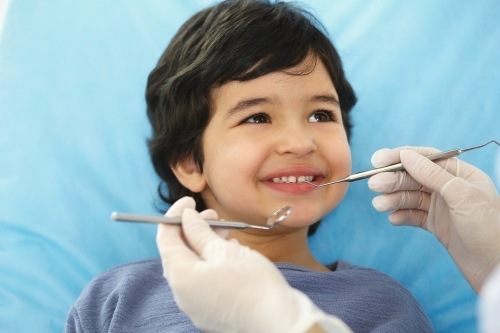
Visiting the dentist can be a daunting experience for many children, often leading to dental anxiety. It’s essential for parents to understand how to help their child navigate their fears to make dental visits a more positive and stress-free experience. In this blog, we will explore helpful strategies and resources that can help you alleviate dental anxiety in your child, so they can actually look forward to their next dental checkup!
Communication is Key
It is a good idea to talk to your child about what to expect during their dental visit, emphasizing the importance of their healthy smile and addressing any concerns or fears they may have. Using simple and age-appropriate language can help alleviate your child’s anxiety and build trust between them and our dental team.
Why Choose Our Pediatric Dental Team
Our pediatric dentist specializes in treating children, which can make all the difference in helping them effectively manage their dental anxiety. Our entire pediatric dental team is experienced in working with kids in a child-friendly environment that helps create a positive dental experience for your child.
Practice Dental Care at Home
Demonstrate proper brushing techniques as needed and make sure your child brushes their teeth regularly. Consider using child-friendly oral hygiene products, such as toothbrushes with their favorite cartoon characters or flavored toothpaste to make dental care more enjoyable for them (and you)!
Relaxation Techniques
Deep breathing exercises, counting exercises, or visualizations can help calm their nerves before and during their dental appointment. Engage in these techniques as a family to make them more accessible and create a sense of support in their environment.
Distraction and Entertainment
During dental visits, providing distractions can divert your child’s attention from anxiety-inducing situations. Bring along their favorite toy, book, or handheld gaming device to keep them occupied.
Positive Reinforcement
Positive reinforcement techniques, such as praise and rewards, can motivate children to face their fears and manage dental anxiety. Celebrate their bravery and cooperation after each dental visit, whether it’s through verbal encouragement, small treats, or a special activity they enjoy.
Utilize Online Resources
Various online resources can assist parents in managing dental anxiety. Websites, videos, and interactive apps provide information on dental procedures, tips for reducing anxiety, and virtual dental tours. These resources can help familiarize children with the dental environment and alleviate their concerns before they come in for their checkups.
Creating a Lifetime of Healthy Smiles
By implementing the following, your child can receive the tools they need to have positive dental experiences throughout their lifetime:
- Open communication
- Choosing a pediatric dentist
- Practicing dental care at home
- Learning relaxation techniques
- Positive reinforcement
- Tap into online resources
Even though dental anxiety in children can be challenging for both parents and dentists to handle, it is worth the effort. By implementing effective techniques and utilizing available resources, you can help your children overcome their fears and help establish a positive attitude toward receiving dental care. Working together, we can ensure that dental visits become stress-free experiences that promote good oral health and overall well-being for your child, building a solid foundation for a lifetime of healthier, happier smiles!
How To Help Your Child Overcome Their Thumb Sucking Habit
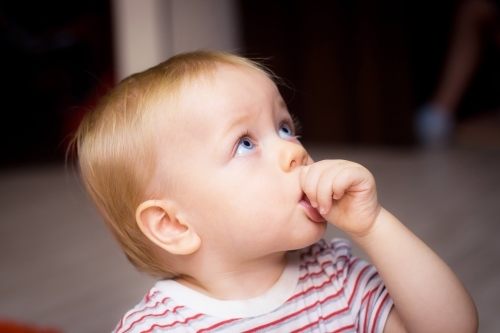
As a parent, you want the best for your child, and that includes their dental health. Unfortunately, thumb sucking is an all too common habit among children, and it can have negative effects on their teeth and jaw development if it continues for too long. Here are some tips to help your child overcome their unhealthy thumb sucking habit!
Why Thumb Sucking?
First, it’s important to understand why children suck their thumbs. Many children do it for comfort and to self-soothe, especially when they’re feeling anxious or tired. While it is a natural behavior that typically starts in infancy, most children outgrow it by the age of 4. However, some children do continue to suck their thumbs well into childhood, which can cause problems with their dental health as their mouth and jaw are developing.
The problem is, if thumb sucking goes on for too long, the pressure of the thumb pushing against the teeth and roof of the mouth can cause their teeth to shift or become misaligned. Once that happens, it can lead to problems with speech, chewing and even breathing properly. As thumb sucking affects the development of their jaw this causes an overbite or underbite to develop. In some cases, prolonged thumb sucking can even lead to the need for orthodontic treatment later.
Overcoming Thumb Sucking
So, what can you do to help your child overcome their unhealthy thumb sucking habit? Here are some helpful tips to try:
1. Talk to your child: Explain to your little one why it’s important to stop sucking their thumb and how it can affect their dental health. Encourage them to think of other ways to soothe and comfort themselves, such as hugging their favorite stuffed animal or listening to calming music.
2. Offer positive reinforcement: Praising your child when they’re not sucking their thumb helps serves as a gentle reminder. You can also offer them rewards for their progress. Young children are delighted buy small and simple things, like a sticker chart or a small treat to celebrate the win.
3. Find a suitable substitute: If your child is sucking their thumb for comfort reasons, you can offer them a comparable substitute, such as a soft blanket or cute stuffed animal. This strategy can help them transition away from thumb sucking as they find comfort in these other offerings.
4. Use a thumb guard: Thumb guards are devices that fit over your child’s thumb making it difficult to suck. These guards are a gentle and effective way to break your child’s habit of thumb sucking.
5. Seek professional help: If your child is having difficulty stopping thumb sucking at a reasonable age, consider seeking help from our pediatric dentist or even an orthodontist. Both can provide additional strategies and support to help your child put their thumb sucking habit behind them.
Patience and Results
It’s important to note that breaking the habit of thumb sucking takes time and patience. As a parent, you want to be supportive, understanding and celebrate your child’s progress along the way! With the right approach, your child can overcome thumb sucking and go on to develop a healthy, beautiful smile.
Why Your Child Might Need a Dental Crown To Restore a Damaged Primary Tooth
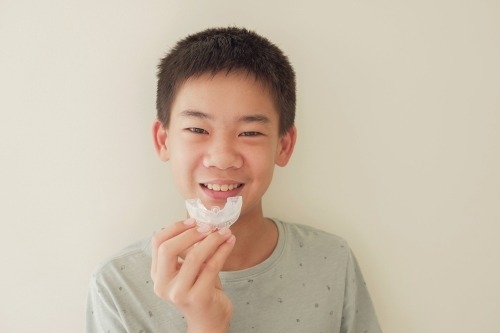
Spring is finally here, and April is National Facial Protection Month. This is a time to raise awareness about the importance of protecting the face during contact sports and high-impact recreational activities. With spring sports in full swing, it’s important to remember that accidents can and often do happen, leaving behind dental injuries. That’s why it’s crucial to take the necessary precautions to protect your child’s teeth and mouth when they are actively engaged in sports.
Mouthguard Protection
One of the most effective ways to prevent dental injuries is by wearing a mouthguard. Mouthguards are protective devices that cover the teeth and gums to prevent facial damage from impact. They’re typically used in sports like football, hockey, and lacrosse, but they can also be useful in activities such as skateboarding, skiing, and biking.
It’s especially important for children to wear mouthguards during physical activity. According to the American Dental Association, injuries to the mouth are the number one orofacial injury when engaging in sports. In fact, athletes who don’t wear mouthguards turn out to be 60 times more susceptible to incurring dental injuries than those who safeguard their smiles.
Pediatric dentistry emphasizes the importance of starting good oral health habits early in life. As a parent, it’s important to teach your child about the benefits of wearing a mouthguard and to make sure they wear one during sports and other physical activities. You can also talk to our pediatric dentist about getting a custom-fitted mouthguard that will provide the best protection for your child’s developing teeth and gums.
Types of Mouthguards
There are three main types of mouthguards:
- Stock mouthguards: These are pre-made and come in small, medium, and large sizes.
- Boil-and-bite mouthguards: These are customized by boiling them in water and then biting down on them to create a custom-tailored fit.
- Custom-fitted mouthguards: These mouthguards are crafted by a dentist, providing the most protection and comfort out of all the types of mouthguards on the market today.
While all types of mouthguards offer some level of protection, custom-fitted mouthguards are the best option for children and teens who play contact sports regularly. Custom-fitted mouthguards are made from an impression of the teeth, which ensures a snug fit that won’t slip or fall out during physical activity. They’re also more comfortable than other types of mouthguards, which means that children are more likely to wear them during sports and other activities.
Sports Safety
In addition to wearing a mouthguard, there are other ways to prevent dental injuries during physical activity. One important step is to wear a helmet if the activity involves the possibility of head injury. Helmets are essential for sports such as football, hockey, and biking, and they can also be useful in activities such as skateboarding and skiing.
It’s also important to make sure that children are properly supervised during physical activity. An adult should be present to monitor all the actions and make sure that children are following the rules and using proper safety equipment for everyone’s safety.
Call To Schedule a Visit
April is National Facial Protection Month, but protecting your child’s teeth and mouth is important all year round. By wearing a mouthguard and taking other precautions, you can help your child prevent dental injuries and ensure that their smile stays healthy and strong. Talk to our pediatric dentist today to learn more about the benefits of mouthguards and other ways to protect your child’s teeth and gums during physical activity. We are always here to help your child’s growing smile needs!
Why Your Child Might Need a Dental Crown To Restore a Damaged Primary Tooth
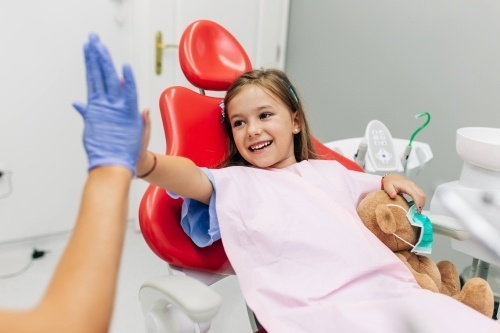
Dental crowns are an investment in keeping a tooth as long as possible. Even for children, dental crowns protect their developing smiles because their jaws are still forming. Any tooth gaps that arise when a tooth is pulled early because of decay, or even injury from an accident or contact sports, can leave your child dealing with serious dental problems later.
Primary Teeth Placeholders
Your child’s primary teeth serve as placeholders for their incoming permanent teeth, and teeth tend to shift as their jawbone grows. When teeth are shifting, they may end up causing crowding and misalignment of the teeth. If this happens, your child will likely end up needing orthodontic intervention down the road, among other potential dental treatments.
This is why our dentist often recommends having your child get a dental crown rather than pull a primary tooth prematurely. Exceptions might occur if the tooth is severely infected (with an abscess) or the cavity is too large to support a filling. The bottom line is that getting a dental crown now can save your child from dental treatment and costs later.
What Is a Crown?
A tooth has two parts; the roots that anchor the tooth in the jawbone and a crown that is set onto a tooth to keep it covered, thereby restoring its full size, shape, and strength (necessary for proper biting and chewing). The crown caps the damaged area of the tooth to preserve it and keep it safe. Your child’s dental crown will help ensure that the incoming permanent tooth behind it can come in correctly after the primary tooth is eventually pushed out.
Why Your Child Might Need a Dental Crown
The crown is essentially placed so a damaged tooth can still function, allowing your child to eat, speak and chew while also looking normal. The following are all good reasons to give your child’s smile the support of a dental crown on a primary tooth:
- The cavity is too big to support a dental filling.
- The tooth is cracked or extensively worn down.
- A root canal was done, and it now needs the crown to protect it.
- Their tooth is badly shaped or discolored.
Since a primary tooth has enamel that tends to be on the thin side, they are more vulnerable to the destructive nature of cavities, which ultimately tend to spread more easily and impact a greater area of the tooth. Getting a crown effectively rescues the tooth, encasing it so it can continue to act as a placeholder while the adult tooth comes in when it is ready.
There are a variety of dental crown materials, and choosing the right one largely depends on the following:
- Where the tooth is placed and how it functions
- How the gum tissue fits around it
- How much of the tooth shows (front and side teeth)
- The tooth’s color
Common Dental Crowns for Primary Teeth
- Stainless Steel Crowns: These “silver” crowns are strong, durable and ideal if you don’t mind how they look.
- Stainless Steel Crowns With White Facings: These are strong and look nicer on the front teeth.
- Composite or Resin Crowns: These take a little more time to place and are great for older children.
- Zirconia Crowns: These white ceramic crowns are both strong and natural-looking.
Call Today!
Your child’s primary teeth are crucial during the development of their mouth and jaw. There are times when a dental crown may be needed to save a tooth until it is ready to fall out as the permanent tooth comes in behind it. If you have questions or want to schedule your child’s dental visit, we welcome you to reach out to our dental team today!
February Is a Busy Month When It Comes to Your Child’s Dental Health
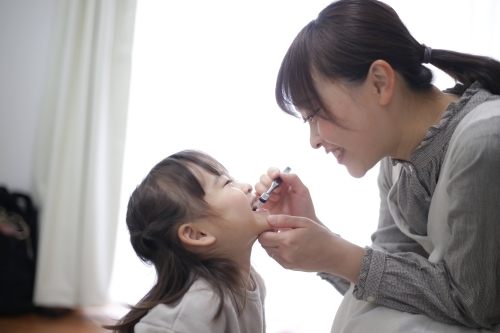
February is Children’s Dental Health month, and this year’s theme by the American Dental Association (ADA) is “Brush, Floss, Smile.” This year, they offer the following dental health tips to help support your child’s developing oral health for healthy teeth and gums:
- Brush your teeth twice a day with fluoride toothpaste.
- Floss between your teeth every day.
- Eat healthy foods and limit sugary drinks.
- See your dentist (at least) twice a year.
Our dental team can’t stress enough how important it is for children to develop good habits at an early age. We also encourage scheduling routine dental visits to help your child get the best possible start on a lifetime of healthy teeth, gums and smiles!
Toothache Day
February 9th is also Toothache Day, where we spotlight what you need to know about toothaches and why dental hygiene care is such a vital part of your child’s growing smile. Toothaches are basically the pain from one (or more) teeth in distress. Your child’s aching tooth can make eating, sleeping and even talking unbearable. And while dental pain is hard for anyone at any age, for children, it can feel even more distressing and traumatic.
What Causes Toothaches in Children?
- Tooth decay: This can lead to tooth pain that often feels dull. You might notice discoloration on a molar that looks yellowish-brown on the dental enamel. These arise when your child consumes too much sugar and starch in their diet, made worse when combined with poor oral hygiene habits.
- Dental abscess: These come from bacterial infections with pus inside the tooth’s root. You may also see a pimply growth right under the gum line. Treating the abscess quickly helps prevent bone loss.
- Cracked tooth enamel: This can happen when your child bites down on something hard like jawbreakers or gumballs, leaving them feeling tooth sensitivity or pain.
- Gum disease: Typically arising from lax oral hygiene care allowing dental plaque to flourish and harden on teeth and around the gum line. Teach your child to brush, floss, and rinse their mouth every day without skipping, and see our dentist for checkups.
- Stuck food: Whether your child likes corn, popcorn, or shredded meats, tiny bits of food sometimes become trapped between their teeth and gums. This is why flossing between their teeth before bedtime is important. As soon as these bits are removed, your child’s toothache should stop.
Preventing Toothaches
To prevent toothaches, monitor your child’s oral hygiene habits. They should be brushing for two minutes, applying an ADA-approved toothpaste and using a soft-bristled toothbrush. To ease discomfort from a toothache, have them gargle and swish saltwater in their mouth (half a teaspoon of table salt to 8 ounces of warm water) to soothe the area. You can help them apply an ice pack to the outside of the affected area for 15 minutes at a time. They may also find relief with acetaminophen (Tylenol) and ibuprofen (Advil) for their age and weight. If their toothache persists, give us a call to see if we can get them in as soon as possible.
February 28th is Tooth Fairy Day!
If your family likes to recognize the tooth fairy, February is one of two days a year when we acknowledge the tooth fairy’s role in your child’s developing smile. When it comes to tooth loss, children often feel better when they know the tooth is going to a good home (the Tooth Fairy’s), and they can collect a small reward, whether it’s money or a new toothbrush or toothpaste that has the Tooth Fairy on it tucked under their pillow during the night! You might mention that the tooth fairy prefers healthy teeth over damaged ones (although she will take any tooth). Encourage daily oral hygiene so that their eventual lost tooth will be a better prize for this industrious fairy!
Our team is excited to help you care for your child’s smile all year round. Give us a call if you have questions about your child’s smile or to schedule their next dental visit!
Boost Your Child’s Smile in the New Year With Dental Cleanings and Dental Sealants As Recommended

2023 brings with it renewed energy and motivation to take better care of our health. For your child, setting oral health goals can help their developing smile stay on track for healthy teeth and gums as they grow. Our pediatric team has some recommendations to help make your child’s oral health a priority that will serve them for years to come!
It’s important to supplement their at-home daily oral hygiene care by bringing them in for routine dental cleanings and exams. Another way to boost their dental health is by protecting their molars with dental sealants applied to them. This easy, painless treatment keeps permanent molars, which are notoriously difficult to reach and clean, strong, and protected from decay, and can last for up to 10 years! Our team will check the sealed tooth during their regular cleanings to make sure they aren’t chipped or worn down.
Smile Worthy Goals for 2023
- Limiting sugary foods and drinks. Unfortunately, sodas, juices, and sports drinks are often loaded with sugar which feeds the oral bacteria that causes tooth enamel erosion and decay. Since starchy foods also feed bacteria, it is a good idea to limit them as well. Encouraging your child to drink more milk and water will strengthen their teeth and bones while producing healthy saliva levels that combat harmful bacteria.
- Helping them brush and floss daily. You’ll want to show your child how to clean every tooth, their gums (and even their tongue) to remove harmful bacteria. This is also something we can show your child how best to do when they come in for routine checkups. Their smiles are often the first thing people notice about them, so giving them the tools they need to achieve their best smile is essential. You generally want to get them into the habit of brushing when they wake up and when they go to bed. Even better is if your child brushes after every meal, and at the very least, rinse well with water after eating. Flossing cleans the “rest” of their tooth surfaces and should begin once your child has two teeth touching each other (where bacteria can hide and attack tooth enamel).
- Getting dental sealants. Our pediatric team recommends children get sealants on their permanent molars and premolars once these pearly whites arrive. This makes a big difference to their dental health because the protective sealant layer shields the teeth from cavities that tend to show up from ages 6 to 14. We might also recommend dental sealants for baby teeth when these teeth have deep depressions and grooves that are challenging to clean. Baby teeth are actually very important to your child’s smile because they hold space for the incoming permanent teeth that will arrive later on.
Dental Sealant Steps
Applying a dental sealant for your child’s molars is simple, painless and fairly quick:
- 1. We thoroughly clean and dry the molars before their sealant is applied.
- 2. Next, we place an absorbent material around the tooth to keep it dry.
- 3. An acid solution is then placed onto the chewing surfaces of the molars to make them feel “rough” so the sealant can properly adhere to the tooth’s surface.
- 4. We then rinse and dry the tooth (or teeth).
- 5. Finally, we paint the sealant onto the tooth enamel so it can bond directly to the tooth and harden with the help of a curing light.
Keeping your child’s smile safe sets the stage for them to have strong teeth and gums that they learn how to maintain throughout their lives. By bringing them in for routine dental exams and cleanings, you are helping them maintain their oral health and develop self-confidence for a lifetime of smiles!
How To Keep Your Child’s Smile Healthy During the Busy Holiday Season
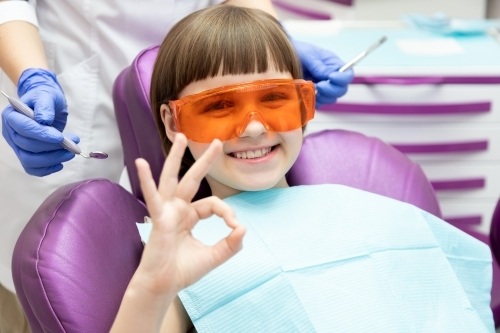
This holiday season, take some time amongst all the busyness to keep your child’s smile safe and healthy. Whether it is the tantalizing treats they love this time of year, the wintery sports they play or the gifts you give them, make sure their teeth are protected despite the hecticness of the holidays. After all, one of the best gifts you can give your child is a healthy smile and growing self-confidence!
Seasonal Safety First
Whether they love ice skating, playing ice hockey, sledding, snowboarding or skiing during the holidays or on family trips, it is important to keep your child’s teeth and mouth safe from accidental injury. Along with any other protective gear like helmets and goggles, a mouthguard can protect their smile: both teeth and soft oral tissues. You purchase a custom athletic guard or over-the-counter boil-and-bite guard online or at your local drugstore, grocery store or sporting goods store. Their smile is worth it!
Tantalizing Treats
Ideally, you could help your child enjoy the traditional goodies of the season by making sure they are sugar-free. But when that is not possible, limit their sweets and make sure they brush and floss so they do not risk tooth decay and cavities. Advent calendars are fun but try finding calendars filled with tiny toys or non-sugary treats instead of the usual sweet chocolates and candies (especially hard candy that can crack or chip teeth or sticky gumdrops). You can also count down the holidays with a nightly story or book reading instead.
Offer tooth-friendly goodies like these:
- Dark chocolate
- Sugar-free gum and sugar-free candy
- Cool stickers
If your child cannot brush their teeth after eating sweets, remind them to drink plenty of water to rinse out their mouth or chew sugar-free gum until they can come home and brush their teeth to remove sugar-feasting oral bacteria.
Tooth-Friendly Holiday Foods
-Holiday turkey is great for your child’s smile, as turkey is loaded with protein, nutrients and phosphorus (which is like calcium). It also strengthens tooth enamel. Holiday ham contains zinc that helps replenish your child’s gumline tissue.
-While hard nuts can damage teeth, soft nuts like pecans, cashews and macadamia nuts are good for them with their high levels of calcium and protein while being low in sugar.
-Cheese provides calcium to strengthen teeth while dairy protein helps prevent cavities so let your child enjoy their favorite mozzarella sticks, cheddar blocks and more.
-Colorful raw veggies such as vibrant and crunchy broccoli, bell peppers, carrots, celery, jicama and radishes nurture teeth and gums.
-Seasonal fruit is loaded with healthy vitamins and antioxidants that are good for the gums. Your child can enjoy their favorite fruits like apples, pears, grapes, kiwis, pomegranates and strawberries.
Make sure your child drinks plenty of water to keep their mouth hydrated for healthy saliva levels that prevent tooth decay and gum disease. Limit or ban sugar-filled drinks, including juices, sodas and sports drinks.
Tooth-Friendly Gifts and Stocking Stuffers
- Fun floss picks they can easily use
- Flavored toothpaste
- Fun toothbrushes for kids
- Electric toothbrush with cartoon characters or cool colors for kids and teens
- Teeth whitening kits or toothpaste for teens
- Fun traveling toothbrush case for traveling or sleepovers
- Cute toothpaste dispenser for kids
- Toys and children’s books for kids about dental health
Routine Dental Care
Even though you are busy this time of year, take the time to enjoy these precious moments with your child and encourage them to brush and floss every day as recommended. Brushing twice a day, flossing daily and using mouthwash afterward can all help keep cavities away from their growing smile. This is also the time of year to get their last dental cleaning and exam of the year if you haven’t already. We will remove any plaque build-up, polish and fortify their teeth and check for any developing problems. Your child’s healthy smile is the greatest gift you can give them!
National Brushing Day: Getting Your Child Excited About Brushing Their Teeth and Gums!
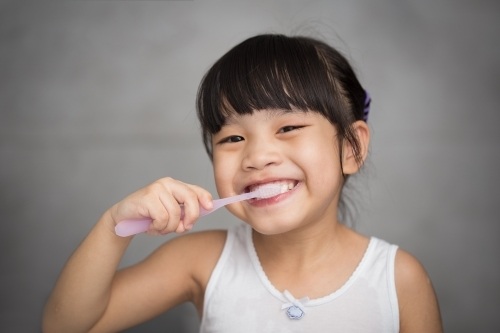
Do you know the number one contributing factor for cavities in your child’s mouth? If you said sweets, you are on the right track! Dental plaque is a buildup of oral bacteria that feast on carbohydrates, releasing acids that break down tooth enamel.
The minerals in saliva, (calcium and phosphate) along with the fluoride in toothpaste and tap water can boost enamel health by replacing minerals lost from acid attacks. Still, continuous acid attacks weaken and destroy enamel, creating tiny holes (cavities) in your child’s chompers. Left untreated, cavities can make their way into the dentin layer below tooth enamel.
Along with sugar and acids, tooth decay can arise from lax daily oral hygiene care, a lack of preventative fluoride protection and even dry mouth. Remember, saliva is the first line of defense against tooth-destroying oral bacteria so keeping your child well hydrated with water instead of juices or sports drinks is important.
Brushing for the Win
If, like most kids, your child spent a good chunk of October enjoying Halloween parties and trick or treat laden sweets, then celebrating National Brush Day on November 1st (and throughout the month) is the perfect way to help your child refocus on taking good care of their smile. You can even find ways for them to be thankful for their teeth!
November is a good time to help your child relearn proper brushing techniques while making brushing fun. Help your child feel more motivated to care for teeth and gums by practicing good daily oral hygiene as their mouth continues to develop with new and permanent teeth coming in all the time.
Limit Acidic Foods
Brushing at least twice a day helps limit harmful bacteria that would otherwise thrive on sugars and leave behind acidic waste as a by-product, setting the stage for cavities. Encourage your child to brush and floss every single day while limiting the sugar in their diet. Diligent at-home care, combined with routine dental cleanings and decreasing acidic foods and drinks all help your child’s smile thrive! These foods should be kept to a minimum:
- Citrus fruits — lemons, limes, grapefruits, tangerines and oranges
- Apples, grapes, peaches, pomegranates, blueberries and pineapples
- Fruit juices and sodas (both regular and diet)
- Tomatoes and tomato juice
- Jams and jellies
- Vinegar
- Sauerkraut
We think it’s pretty cool that National Brush Day falls on the day after Halloween, as it makes it a great time to refocus your child’s attention on their dental hygiene routine. It also gives you an opportunity to monitor their sweets intake during the rest of the upcoming holidays. Making sure they stay on top of their daily oral hygiene during these festive months can help your child start the new year with better oral health.
Celebrating National Brush Day
-Throw a family toothbrushing party: Play games that make toothbrushing fun.
-Make a brush station: This station allows your kids to brush their teeth. The winner gets a new toothbrush or an unusual-flavored toothpaste, like bacon, mango, chocolate or wasabi… depending on your child’s or teen’s taste.
-Let them choose a new toothbrush: Whether it’s a real toothbrush or a toy one for a small child, letting them pick out one that strikes their fancy can be fun (you can provide options that they can pick from so their teeth are still getting the care they need).
-Make toothbrushes out of craft items: You can use cardboard, foam, felt, yarn, glitter and glue to make cool toothbrushes to “brush” their favorite toy’s teeth!
-Introduce a toothbrushing app: Brush DJ, Brush Up, Disney Magic Timer, Tiny Dentist, Chomper Chums, Heroes of Hygiene, etc. are fun ways to help them brush their teeth. These can be downloaded onto your iPad or iPhone from the Google App Store.
As the holiday season ramps up, we invite you to make your child’s oral hygiene routine fun and memorable for them. After all, they are developing habits to last a lifetime. We invite you to have fun with your kids, by enjoying National Brush Day throughout the month if you like! Your children’s smiles are worth it!
Keep Your Child’s “Fangs” Safe During the Hauntingly Happy Month of Halloween!

It’s almost trick-or-treating season, and our pediatric team wants to help your child’s smile stay safe during this frightfully festive time. Between scary school activities, decorating your home, and visiting petrifying pumpkin patches for cider and donuts, we want your little witch or goblin to safeguard their devilishly delightful fangs from the trickery of tooth decay and cavities!
While the safest route to healthy teeth means avoiding sugary sweets, we also don’t want your child to stage a revolt, so we have some ideas to help them maintain a healthy smile all month long while making the most of their trick-or-treat bag on their Halloween night.
Trick or Treat Don’ts
Dried fruit like raisins and cranberries may seem like they’re healthy alternatives to candy, but they tend to cling to tooth crevices, dental fillings, braces, and retainers and are harder to clean. Sour candies contain tooth-damaging acids that prematurely wear down precious tooth enamel. Hard and chewy candy invites harmful oral bacteria to attack teeth at length, getting trapped between teeth and lingering longer. Some examples are:
- Caramels
- Taffy
- Hard or chewy candy
- Jellybeans
- Licorice
- Bubblegum
- Popcorn
- Nuts
Trick or Treat Do’s
- Candy bars are quick to eat and don’t stick around on tooth surfaces.
- Powder candy, like bottlecaps and smarties, dissolves fairly fast so they also don’t stay on teeth for too long.
- Sugar-free candy and sugar-free gum help boost saliva production that neutralizes bad bacteria in the mouth.
Some safer Halloween options include:
- Chocolate without caramel or nuts
- Marshmallows
- Peanut butter cups
- Soft cookies
Safe Halloween Options
- Modeling clay: These are a great way to stimulate your child’s imagination and creativity when the candy fest is over.
- Glowsticks: These come in various sizes and colors to enhance your child’s trick-or-treating experience while making them easy to spot, boosting their safety.
- Ghoulish Halloween goodies: Tuck in some vampire teeth and scary spider rings to play with instead of just gobbling goodies.
- Trixy temporary tattoos: There are plenty of ghostly, witchy or skeleton tattoo options to distract your little trickster!
- Creepy coloring books: There are tons of Halloween-themed coloring books that can take the place of sugary overconsumption. Your child might love soothing their stress, boosting hand-eye coordination, and expressing their creative side with the magic of crayons and colored pencils at home.
- Festive school supplies: Make their time in the classroom more fun with Halloween-themed pencils, pens, erasers and stickers!
- Dress up a water bottle: The best liquid for your child’s smile is water! Water promotes healthy saliva levels, improves cognitive function and helps the body stay hydrated. It also helps your child fight cavities as it clears away leftover sugars, acids, and starches from their pearly whites. You can even dress up the bottle with fanciful Halloween decor and stickers.
Happy Halloween!
We hope these hauntingly happy Halloween tips will bring a smile to your child’s face while making you feel better about their oral health during this month’s festivities. We wish you and yours a fang-tastic night and welcome you to schedule a dental visit for your child and stop in for a spell!
Learn How You Can Keep Baby Bottle Tooth Decay From Harming Your Child’s Teeth

Your baby’s teeth coming in is a sweet milestone that marks the growth of their smile. Even though these baby teeth (primary teeth) are tiny, they’re vital to your child’s developing oral structure. Baby teeth hold those spots for their permanent adult teeth to come in years later, pushing out their baby teeth for the tooth fairy to whisk away!
If your child’s teeth don’t come in, they will struggle to chew, smile, and talk properly. As you care for your child’s smile right from the start, your baby will get comfortable with this daily oral hygiene routine, setting the stage for a healthy smile throughout their lifetime.
Oral Hygiene Starts Early
Even before their first tooth comes in, you want to clean your infant’s gums. Using a soft, damp washcloth or section of gauze, clean their gums after feedings (breast or bottle), as well as before putting them down for the night. This removes bacterial plaque that damages their baby teeth when they do come in.
Once your little’s one’s first baby tooth arrives, you can start using a baby toothbrush or keep using a cloth until your baby is a bit older. Their toothbrush should have a small head with soft bristles. In the early stage, begin by using a moistened toothbrush and soften the bristles by soaking it in warm water for a couple of minutes. Once the teeth are showing you can use a rice grain-sized bit of toothpaste to protect tooth enamel.
It is recommended to bring your child to their first dental visit by their first birthday or 6 months after their first tooth makes its debut. Our pediatric dental team is happy to share proper tooth caring tips, what to do when they are teething (or thumbsucking), the best diet for healthy teeth, and talk about fluoride and dental sealants to protect their tiny chompers later.
Preventing Baby Bottle Tooth Decay
To protect your baby’s teeth when they start coming in, stick to baby formula, breast milk, water, and occasionally electrolyte liquids when your baby experiences diarrhea. Never give them sodas or other sweetened liquids, and only offer 4 ounces of 100% fruit juice a day as a treat.
Once your child has one or more teeth, sweet drinks (or pacifiers dipped into sugar or syrup) will coat the teeth and form plaque. Known as baby bottle tooth decay, this often affects their upper front teeth. This decay damages exposed teeth, and if the decay is left treated, those teeth can become infected and painful. Baby teeth afflicted with severe decay may need to be extracted. Remember, your baby’s primary teeth must remain in their place until their permanent teeth erupt and push them out. Without these “placeholder” teeth, your baby can suffer from poor nutrition, speech issues, or crooked and damaged permanent teeth.
When you settle your baby down for a nap during the day or at night, putting them to bed with a sweet drink feeds the harmful oral bacteria, secreting acids that attack tooth enamel. If you do this at night, their mouth is even more vulnerable as normal saliva flow diminishes while they sleep. A better choice is to put your baby down with plain water in their bottle or sippy cup. It allows them to fill their belly and soothe themselves without tooth-damaging sweeteners.
Call To Schedule Baby’s First Visit
If you’re noticing that your baby is fussy and drooling more than usual, this is a sign that their first tooth may be coming in. We welcome you to give our team a call with your concerns or to schedule their first visit. Setting the foundation for a healthy smile now means a healthy smile later!
Providing Healthy Summer Foods and Drinks Can Give Your Child Stronger Teeth!

If you want to help your child develop and keep their oral health strong, you’ll want to have them brush and floss but also consume healthy foods and drinks. As they grow, help them have proper jaw growth, strengthen and remineralize their chompers and stay hydrated to keep their mouth and saliva healthier. Today we’re talking about how you can set your child onto a path to great dental (and overall) health.
Smile- and Body-Friendly Foods
Lean meats, nuts, and proteins: Besides being good for their growing bodies by building tissue in the body, protein also helps to strengthen their tooth enamel. Think turkey, chicken, white fish, eggs, beans and tofu for maturing bodies. Keep snacks healthy by providing nuts which also give them the energy they need for their active bodies. Nuts that are also low in carbohydrates help avoid cavities that can arise from high-carb nuts by activating oral bacteria that create harmful acids. Healthier choices like Brazil nuts, macadamia nuts and pecans are way better for their teeth! As your child bites and chews protein in tough nuts and meats, this also helps them grow stronger jaws and lowers their odds of having bite problems.
Raw, crunchy veggies: Like nuts and meat, getting your child to regularly consume firm, crunchy foods will help their jaw development. That’s because chewing firm foods helps widen their dental arch which lessens their odds of having a bite problem called malocclusion. Tuck these raw vegetables into their lunches whenever possible – celery, carrots, broccoli, and cauliflower and keep these veggies washed and cut up in the fridge for easy access.
High water content fruits: These make super healthy snacks! Think watermelon, pears, celery, and cucumbers with the bonus benefit of scrubbing the teeth when chewing. Also, offer them high water content and crunchy fruits that promote healthy saliva production, by stocking up on apples and pears. Saliva keeps the mouth healthy by clearing away food particles, lowering oral acids and boosting overall health.
Calcium-rich cheeses and low-fat dairy: Do your kids like cheddar, Swiss or Monterey Jack cheese? Chewing these tasty cheeses promotes saliva flow while providing essential calcium for their developing bodies (700 mg daily for kids 1-3 years old, 1000 mgs daily for kids 4-8 and 1300 mgs daily for your 9 to 18 year old). Dairy products like milk, cheese, and yogurt are also high in phosphorus, which, along with calcium, remineralize teeth after being exposed to acidic foods and drinks. If your child has dairy allergies, spinach, kale, collard greens, red meat, canned salmon, sardines, winged beans, white beans, and navy beans are great alternatives!
Vitamin C: Fruits like oranges, limes, tangerines, kiwis, cantaloupe, papaya, mangoes and strawberries destroy harmful oral bacteria while veggies like red, yellow and orange peppers, tomatoes and sweet potatoes do too!
Sugarless gum: Chewing Xylitol-sweetened or sugar-free gum for 20 minutes after a meal helps keep cavities away when your child can’t brush their teeth. Xylitol lowers oral bacteria while chewing generates saliva production, that clears out lingering stray food particles around the teeth. Since younger kids like to swallow their chewing gum, wait until your child is old enough to understand that they need to drop it in the trash when they are done (around 4 years old and over).
Hydration: Help your child skip sweetened juices, sodas and sports drink that lead to tooth decay. Instead, provide them with plenty of cool, clear water. Do they like tap water? That’s even better as it is fluoridated which reduces harmful oral bacteria. Water is the best all-around rehydrator to help your child navigate the summer heat and fight cavities! Make sure they have a flask of water when they are on the go.
If you have any questions about which tooth-friendly foods and drinks your child can enjoy all year round, not just during the summer season, give our pediatric dental team a call today!
Baby’s Dental Health
Your baby depends on your consistent, daily oral hygiene care. Start their dental care early by cleaning your infant’s smile using a clean damp washcloth to wipe away harmful oral bacteria and milky residue. Do not put your baby in bed with a bottle or sippy cup with milk, formula, juice, or other sweet drinks. The only thing they should be allowed to sleep with is water, and giving your little one a bottle or sippy cup with plain water can help them fall asleep if needed.
Whether your baby is on formula or breastmilk, you want to clean their miniature chompers using a clean, moistened washcloth when they fall asleep. Keep harmful oral bacteria away by not sharing utensils, binkies, toothbrushes and toys that baby inevitably sticks in their mouth. Brush your baby’s teeth twice a day once their first tooth erupts. A tiny toothbrush head with soft bristles is ideal for babies. As your toddler develops, you can use fluoridated toothpaste when they can spit it out after cleaning (typically around age 3).
You will want to bring your baby in for their first checkup between six and twelve months. Our pediatric dentist is happy to check for any potential problems early and show you how to effectively clean your child’s teeth. Our pediatric dental team can also assess habits like thumbsucking, and we look forward to helping your baby’s smile grow into a healthy, beautiful grin!
What You Should Know About Your Baby’s Growing Smile During Pregnancy and After Birth

If you are expecting, congratulations! Motherhood is an amazing time, and you will want to take especially good care of your teeth and gums because of the new hormonal changes in your body. It is not just for your smile protection either; these hormones put you at higher risk of gum disease, which can impact your growing baby. Severe gum disease can be connected to low birth-weight babies and premature births.
Your baby’s teeth develop while you are growing your baby. It is why following a healthy diet and taking prenatal vitamins are good for both of you. Watch out for sugary snacks and know that snacking in general increases your odds of risking tooth decay. Did you know that your baby’s first teeth start forming around three months into pregnancy? A prenatal diet rich in dairy products (like cheese and yogurt) supplies essential minerals that are good for your baby’s growing teeth, gums, and bones.
Pregnancy-Related Oral Health Problems
- Periodontitis is gum disease from the hormones reacting to the harmful bacteria in your gums. It can leave you with red, swollen gums, and left untreated, it can cause the bone supporting the teeth to be lost, the teeth to loosen, and potentially require extraction.
- Increased cavity formation from behavioral changes (like higher levels of oral acidity) from morning sickness, vomiting and frequent snacking. Mothers who have untreated cavity-causing bacteria during pregnancy and post-delivery can pass these oral bacteria on to their baby, which can grow and lead to extensive dental problems later.
- Tooth enamel erosion from morning sickness (you can combat this by rinsing with a solution of one cup of water with one teaspoon of baking soda which effectively neutralizes acidity).
- Seek proper dental care during pregnancy and let your dentist know you are expecting. Dental X-rays, checkups, and cleanings are safe and help prevent periodontal disease and avoid pregnancy gingivitis. In fact, professional dental cleaning is especially vital now.
- According to The Journal of the American Dental Association, Avoiding gum disease during pregnancy helps prevent premature birth. Pregnant moms experiencing ongoing, untreated gum disease are at greater risk of premature birth (before week 37) to underweight babies. Think of dental care to prevent cavities and gum disease as part of your prenatal care since poor oral health while pregnant can result in poor health for both mom and baby.
Baby’s Dental Health
Your baby depends on your consistent, daily oral hygiene care. Start their dental care early by cleaning your infant’s smile using a clean damp washcloth to wipe away harmful oral bacteria and milky residue. Do not put your baby in bed with a bottle or sippy cup with milk, formula, juice, or other sweet drinks. The only thing they should be allowed to sleep with is water, and giving your little one a bottle or sippy cup with plain water can help them fall asleep if needed.
Whether your baby is on formula or breastmilk, you want to clean their miniature chompers using a clean, moistened washcloth when they fall asleep. Keep harmful oral bacteria away by not sharing utensils, binkies, toothbrushes and toys that baby inevitably sticks in their mouth. Brush your baby’s teeth twice a day once their first tooth erupts. A tiny toothbrush head with soft bristles is ideal for babies. As your toddler develops, you can use fluoridated toothpaste when they can spit it out after cleaning (typically around age 3).
You will want to bring your baby in for their first checkup between six and twelve months. Our pediatric dentist is happy to check for any potential problems early and show you how to effectively clean your child’s teeth. Our pediatric dental team can also assess habits like thumbsucking, and we look forward to helping your baby’s smile grow into a healthy, beautiful grin!
Keeping Your Child’s Smile Safe This Summer Is Easier Than Ever With These Protective Tips!

With the weather getting warmer and the days getting longer, your child is likely looking forward to spending more time enjoying the great outdoors. If so, sunscreen and mosquito repellant are not the only protection they may need. Their smile is vulnerable to the sports they play and the summer treats they indulge in. Here are some tips to help keep your child’s chompers healthy, strong and safe this summer.
Smile Protecting Tips
- Mouth guard protection: During the summer, wearing a protective mouth guard is the number one safety gear they need, especially when they go to sports camps or participate in group games. Mouth guards are a great investment in your child’s healthy smile. Some are inexpensive and customizable while keeping your child’s teeth guarded and their jaws from clenching. You can get mouthguards online, in a sporting goods store or customized by your dentist.
- Bikes and skateboard accidents: With the shorter nights and longer days, it’s no wonder your child wants to enjoy the outdoors as much as possible! Still, these sports are exciting but also put your child’s smile at risk from accidents. Head injuries during these activities happen all too often, so make sure they wear a well-fitting helmet while zooming around.
- High impact contact sports: Group sports increase the odds of an oral injury, especially while participating in soccer, baseball, football, or basketball. Safeguard your child’s smile with an athletic mouth guard fitted for their teeth. Not only can it keep their teeth protected, but the soft oral tissues in their gums, cheeks, and lips, too.
- Water sports: Enjoying pool time is a popular summer favorite. Along with wearing a swim vest, wearing a sports guard while swimming can help keep them from losing a tooth, which is possible whenever they jump, dive into the water, or roughhousing with their friends. Water safety is important to protect their mouth and body while enjoying pool time.
- Sports drinks: Rehydrating with sports drinks may sound like a good idea while your child is out there expending excess energy, but the sugar and acids they contain can lead to tooth decay, enamel erosion, and cavities. Make sure to keep them hydrated with a chilled water bottle. It is better for their mouth and body!
- Summer snacking: Fresh cut-up fruits in season is a great way for your child to load up on the essential vitamins and antioxidants their growing body needs. Make sure they skip sugary popsicles, ice cream, and candy (or at least limit them) and have them brush their teeth after indulging. You can also whip up healthier versions using fresh or frozen fruit and a blender.
- Daily oral hygiene: A relaxed summer routine does not mean your child should let up on their daily brushing and flossing habits. If they are snacking on sweets or chips, cleaning their teeth is more important than ever. It is crucial to get rid of the harmful acids and sugars that will damage their smile.
- Dental checkups and exams: Your child needs routine dental cleanings and checkups year-round. It is too easy to miss a scheduled summer dental appointment if you are distracted by vacations and sports activities. But your child’s teeth do not need a holiday from good dental care, so be sure to help them stay current with their visits.
Summer Activities for Healthier Smiles
Keeping your child’s smile safe this summer is easy if you follow these tips! To reinforce your child’s healthy smile habits this season, download some of these coloring and activity sheets so they can learn how to better care for their smile!
- 2022 Brushing Calendar
- Sports Safety
- National Nutrition Month
- Back to School
- Tooth Fairy
- Sugar Wars
- Defeat Monster Mouth
- Color and Count
- Puzzles
- Oral Health Made Easy
- Sesame Street
https://www.mouthhealthy.org/en/resources/activity-sheets
Keep Your Child’s Smile Healthy With Routine Dental Cleanings and Exams

As a parent, you might wonder why dental checkups are important since your young child will eventually lose their baby teeth. But tooth decay is bad for your child, even if the tooth with a cavity falls out on its own. Your child’s oral health affects their physical, mental, and emotional well-being.
Tooth decay is a bad environment for your child’s developing teeth. Primary teeth help your child’s speech develop properly and make it easier to chew their food to get the nutrients their growing body needs. Poor oral health can affect their digestive system, lead to heart disease, respiratory infection, and even dementia.
The Benefits of Early Dental Care
Bringing your child in for an early checkup helps them avoid unnecessary dental pain, which could lead to problems concentrating and potential medical problems down the road. Setting a good oral foundation for their health means teaching them the importance of caring for their teeth. Kids with healthy teeth also perform better in school and develop greater self-esteem!
It matters because tooth decay is the most shared chronic disease among children in the U.S. Even though it is also largely preventable simply by forming good oral habits and regular checkups early on. The longer you wait to bring your child in for their first dental appointment, the more potential problems may crop up, affecting their dental and general health.
According to the American Dental Association and the American Academy of Pediatrics, every child needs to see a dentist by their first birthday. Ideally, they would be seen when their first tooth makes its debut. It is considered a “well-baby visit,” so you can learn how to best care for your child’s teeth so their mouth can stay free from cavities.
How To Help Your Child Keep Their Teeth and Gums Healthy
- As soon as your baby’s first tooth arrives, begin good oral health habits. Use a clean, soft cloth to whip down their gums and teeth.
- When your child is old enough to hold a toothbrush, teach them how to clean all surfaces of their teeth. Brush for at least two minutes twice daily and use toothpaste. You will want to help them clean until they have the manual dexterity to brush their chompers themselves.
- When your child has teeth that are touching, you will want to floss between them as well as the gum line to remove trapped food particles and harmful dental plaque that can cause cavities and gingivitis.
- Teach your child to clean their teeth after consuming sweetened juices or candy and limit their intake of both.
- Encourage their water intake during the day to help neutralize the harmful acids that lead to cavities.
- Schedule regular dental visits with our pediatric dental team so that your child has the vital building blocks to good oral health!
Call To Schedule Their First Visit
Maintaining good oral hygiene care (combined with regular dental visits) helps your child prevent dental diseases like cavities and gum disease. Bringing your child in early and regularly allows us to look for any developing problems when they are easiest to treat. Should our pediatric dentist find a cavity, we can fix it and provide preventable treatments like dental sealants. Seeing the dentist at an early age teaches your youngster that their smile is important and helps them feel comfortable around oral health providers throughout their life. Call our team to schedule your child’s dental visit soon!
From Infant to Young Adult: Your Child’s Teething Stages and Erupting Adult Teeth

One of the most common questions we hear from parents is concerns about their baby’s teething timeline. As a general rule, teething begins at about 6 to 10 months old and lasts until around 25 to 33 months. Then every two to four months, a set of two new teeth come in. Toddlers will typically get all of their baby or primary teeth by age 3, with a total of 20 tiny chompers. Bear in mind that these are average numbers; your child may get their teeth earlier or later, much of that depending on your family tree.
Learn How Orthodontic Treatment Can Help Correct an Open Bite
- Stage 1 (0-6 months): Your baby already has 20 baby teeth waiting under their gums! You will start noticing drooling when their first tooth comes in.
- Stage 2 (6 months): Around this time, your baby’s lower central incisors will start emerging through the gums in the lower jaw.
- Stage 3 (10-14 months): This age is when your baby’s primary molars start breaking through the gums, causing discomfort and drooling. Before that, they will get their upper central incisors, upper lateral incisors, lower lateral incisors, and upper first molars.
- Stage 4 (16-22 months): At this stage, your baby’s canines, wedged between their incisors and molars on the top and bottom jaw, finally break through the gums. They will also get their lower first molars, upper canines, and lower canines.
- Stage 5 (25-33 months): By now, your toddler’s upper and lower second molars will emerge through the gums. These hurt the most because of their larger surface.
While teething is no fun for anyone, it is a good thing they do not all erupt all at once. The stages give them time to adjust to their new chompers as their teeth emerge in pairs.
How To Tell When Your Baby Is Teething
Although excessive drooling and fussing are the top teething indicators, there are other things you should be on the lookout for:
- Difficulty sleeping
- Red, painful or swollen gums
- Diminished appetite
- Mouth rash
- Constant biting or chewing hard items
- Coughing and warmer temperature
- Rubbing their cheek, pulling their ear
Soothing and comforting your baby through their teething times is very important. Tips to give your baby the pain relief they need include lightly massaging their gums with a clean finger can help relieve discomfort. A cold washcloth or teether (not frozen) can also help! Your baby may feel better chewing on a teething biscuit or cold vegetable. For nighttime relief, an over-the-counter pain reliever for babies can help. Baby acetaminophen or ibuprofen often have good results.
What Can You Expect For Your Child’s First Adult Teeth?
Between the age of 6 and 7, your child’s first adult upper and lower molars come in behind their early (two-year) molars. While they come through, your child can experience cheek biting, headaches, jaw pain, a low-grade fever, and swelling. Rinsing their mouth with warm saltwater and ibuprofen can help; also eating and drinking soft, chilled foods like smoothies, cooled mashed potatoes, vegetables, or applesauce.
Usually, by the age of 13, your child’s remaining teeth will emerge:
- Four central incisors
- Four lateral incisors
- Eight premolars
- Four canines
- Twelve molars
And finally, their last permanent teeth, wisdom teeth, will show anywhere from 17 to 21 years old. Since these teeth are not necessary for your child to chew, they can be safely removed. It helps their bite stay healthy, and those hardest to clean teeth don’t decay or suffer needless cavities.
Pediatric Dental Care
Making sure your child adopts strong oral hygiene habits like daily brushing and flossing and coming in for routine cleanings and exams will help their adult teeth stay healthy throughout their lives. Your child’s smile is important to our team! Whether your child is teething, has a toothache, or painful wisdom tooth, please call us for help with your child’s growing smile
This National Children’s Dental Health Month, Learn How Dental Sealants Can Protect Your Child’s Developing Smile

February heralds the annual American Dental Association’s (ADA) National Children’s Dental Health Month! Designed to raise awareness for optimal oral health in children, the NCDHM has been helping millions of families across the country. They are promoting better oral health with the theme, “Sealants Make Sense” this year.
The goal of the ADA is to help parents create healthy oral health habits while children are young. They also encourage scheduling routine dental cleanings and exams to help your child get the strong start they need to instill a lifetime of healthy teeth and gums.
Why Dental Sealants
Irene Hilton, DDS, who is currently the chair of the ADA Council on Advocacy for Access and Prevention’s advisory committee, syas about this year’s theme:
“Dental sealants on permanent molars reduce the risk of caries by 80%. … I am excited that this year’s National Children Dental Health Month theme is about dental sealants, so more families are aware of this cavity-preventing treatment.”
We couldn’t agree more with Dr. Hilton! Making sure your child receives dental sealants will support their daily oral hygiene routine keeping harmful plaque away. Unchecked plaque leads to tooth decay and gum disease, so brushing and flossing play a vital part in keeping plaque formation to a minimum. This practice, combined with regular dental checkups, can only be made more efficient by adding dental sealants to the molars in the back of the mouth. Those are precisely the teeth that are hard to reach and clean effectively.
The Power of Dental Sealants
The benefits that sealants bring to the table are they protect your teeth from bacteria, plaque and tartar. By applying this thin sealant material (on the deep grooves located on the top of the teeth where the chewing takes place), it acts as a protective coating. It can stop oral debris and food particles from becoming lodged in the grooves.
Sealants keep out decay on the molars, which protect their general health as well. Your child’s oral health is closely linked to their overall health and is also the basis for the health of their permanent teeth to come in. In fact, their primary teeth are valuable placeholders that should be protected until their adult teeth are ready to erupt.
By recognizing National Children’s Dental Health Month, we are happy to remind you to consider getting dental sealants if your child has molars. Dental sealants can last for years with proper care. Their first molars come in around six years old, while the second molars come through around 12 years old.
Caring for Sealants
- Brush twice a day for two minutes each time (play a song, so they spend the recommended time cleaning).
- Floss once a day (before bedtime is ideal).
- Provide them with an enamel boosting toothpaste and a soft-bristled toothbrush.
- Come in for a dental cleaning twice a year for a full cleaning, examination, and dental X-rays to spot problems early.
As you can see, dental sealants give your child the extra protection they need for strong, healthy teeth and a confident smile! Give our pediatric dental team a call to schedule your child’s next visit!
Help your child understand dental sealants by visiting ADA.org to download fun activity sheets:
- -Crossword Activity (PDF)
- -Coloring Sheet (PDF)
- -Calendar Activity (PDF)
- -Grid Drawing Activity (PDF)
Why Your Child Might Need a Dental Crown for a Primary Tooth

Helping your child have a healthy smile is crucial for teeth that will last their whole life. As they grow, their primary teeth are replaced by permanent ones. Since baby teeth will eventually fall out, what should you do if our dentist says your child needs a dental crown? Why would baby teeth need a crown when you could have the tooth pulled and wait for the adult tooth?
Protect Their Growing Smile
The answer is simple but important; crowning a baby tooth is an investment in your child’s oral health. While their jaw is growing, they can develop severe dental problems later on if spaces are left behind from a tooth that was pulled or lost to decay or trauma for a lengthy period of time. Their baby teeth are essential placeholders for their permanent teeth to come in. Without these baby teeth, the teeth will shift as their jawbone develops, leaving them with potential overcrowding in the mouth and misaligned teeth that will likely need to be corrected with orthodontics or other costly fixes later.
To prevent this from happening, our pediatric dentist may recommend placing a crown on that tooth rather than pulling it. While the crown is only temporary, it will still prevent your child from dealing with unnecessary dental procedures and expenses later on to correct the issues that arose from the space left behind from the missing primary tooth.
Unlike permanent adult teeth, child’s baby teeth have thinner enamel. It makes it all too easy for tooth decay to spread quickly between their teeth! A dental crown can save both the afflicted tooth and halt the spread of decay and infection to other areas in the mouth and body.
Preparing for a Crown
When replacing a missing tooth, we will need to prepare the tooth to hold a crown. Our dentist shapes the affected tooth so it can support the crown correctly. We will also need to take an impression of the tooth using dental putty or a digital scanner and then send the results to a lab to create the crown.
Meanwhile, your child will need a temporary crown to keep the shaped tooth safe. After the finished permanent crown is ready to be placed, your child will need to come in so it can be fitted. They can be made comfortable by anesthetizing the tooth and surrounding gum tissue. After treatment, your child will need to hold off on eating anything until the numbness has receded so they don’t bite their lip or cheek by accident.
The dental crown restores the tooth to its original shape and function, which helps guide the permanent teeth into position when it comes through later.
Primary Teeth Crown Materials
The material chosen for your child’s dental crown on a primary tooth can vary based on the tooth’s structure and appearance-based needs. Here are some pediatric dental crown materials:
- Pre-formed stainless steel crowns: The most common crown used for pediatric dentistry is made from metal shells.
- “Strip” or acid-etched resin crowns: A clear shell filled with tooth-colored composite (filling).
- Composite strip: A clear plastic form or mold that blends with the natural color of the teeth.
- Polycarbonate: Used on the front baby teeth, their durability varies, so it is a temporary restoration.
- Resin veneer: Combines the durability of stainless steel with the beauty of a resin facing.
- Zirconia ceramic: Highly durable and visually aesthetic.
We hope this helps you understand why a dental crown might be needed to save a child’s primary tooth until the adult tooth is ready to come through. Crowns are a vital part of their oral health and development as they facilitate the normal development of your child’s jawbone and muscles. Please call our experienced team if you have any concerns about your child’s smile!
This Holiday Season, Give Your Child the Gift of a Healthy Smile!

Our pediatric dental team loves helping parents give their children the best possible start to a lifetime of good oral health. The holiday season is a great time to boost your child’s dental health. Why not give them the gift of a healthy smile, so their developing smile prospers while they grow? It will minimize dental problems and costly treatment later. A healthy smile has the ability to boost their self-esteem, confidence and happiness.
Supporting Your Child’s Developing Smile
Wondering what you can do to support your children’s oral health? Here are some simple ways for keeping your child’s smile healthy and strong!
1. Schedule your child’s first dental appointment by the time they are one year old.
According to the American Academy of Pediatric Dentistry (AAPD), children need to have their first dental appointment by the time they turn one year old. Ideally, they should be seen within six months of the time their first tooth comes in to make sure it is coming in the way it should so their permanent teeth can come in properly later. Our team will assess their general dental health and spot any problems early. We will also review their general oral hygiene care and provide tips to set the stage for good oral health with a healthy foundation.
2. Give your child the tools they need to have healthy teeth later.
We can give you the tools you need to help your child develop healthy habits. When making brushing and flossing a daily habit early, they will better maintain that habit later. The biggest secret is consistency!
3. Making daily oral hygiene fun.
This is perhaps the greatest oral hygiene gift you can give them. Allow your child to pick out their toothbrush and toothpaste themselves so they feel like this is something they want to do. Brush and floss as a family or with a parent, making sure they clean for two minutes, twice a day. Make it a game and set your phone to a two-minute song they like. You can even help them track their daily brushing and flossing habits to earn a reward for their consistent efforts!
Preventative Dental Care
As with grown-up teeth, prevention now is easier than treatment later. With good dental care, your child can avoid risking decaying tooth enamel, cavities, and gum disease. Along with daily oral hygiene and routine dental visits, your child’s teeth may benefit from dental sealants (a thin plastic coating painted on tooth surfaces) to protect their molars which are harder to clean. Dental sealants act as a shield to ward off harmful plaque, oral acids and stray bits of food particles that can become trapped. A simple fluoride varnish can also be easily applied to protect your child’s chompers. And finally, you can support your child’s smile with some of these tooth-friendly holiday gifts!
Tooth-Friendly Holiday Gifts
- Various kinds of toothpaste that come in fun flavors, their favorite superhero or cartoon characters.
- A fun timer they can set for brushing and flossing.
- An age-appropriate flossing tool of choice like floss threaders, dental floss tape, oral irrigator, etc.
- A kid-sized dental hygiene kit packed with travel-sized toothbrushes, toothpaste, mouthwash, flossing picks (especially if you have a child wearing braces, along with braces wax) and a compact mirror.
- Age-appropriate tooth whitening products for your teen like special toothpaste, strips, and over-the-counter kits.
- Healthy snacks like protein-packed nuts, dark chocolate, and their favorite sugar-free gum are great alternatives to traditional candy canes, peppermint bark and caramel toffee treats popular this time of year.
- Schedule their next pediatric dental appointment to maintain their healthy, beautiful smiles!
Please call us anytime if you have any questions or concerns about your child’s smile. Our dental team wishes your family a wonderful winter season with great oral health!
Protect Your Smile From Dental Trauma During the Holidays!

Winter is coming, and if you are anything like us, you are likely busy preparing for the holidays to celebrate with family and friends.
Because this time of year is so busy, it’s easy to overindulge in your favorite annual treats while tempted to slack on your daily oral hygiene care. But that’s a bad combination, and you really don’t want to start the new year with poor teeth and gums! We have two tips to help you take advantage of the goodness of this special season while protecting those precious pearly whites!
Watch Your Sweets!
Whether you love sipping hot cocoa, apple cider, red wine, or eggnog, and dining on delicious cakes, pies, and cookies, your mouth can take a big hit this time of year. Sugar is actually a double whammy as it feeds your sweet tooth (and waistline) but also feeds harmful cavity-causing oral bacteria! We recommend limiting the following indulgences:
Chewy and sticky candy: Caramels, peanut brittle, divinity and toffee, candy canes, peppermint bark, chocolate, fudge, and truffles all cling to teeth and are extra hard to remove from tooth surfaces.
Dried fruit: Healthy-seeming apricots, figs, raisins and prunes take a toll on teeth as they stick in the grooves of back teeth.
Alcohol: While tempting, liquor is often high in sugar as well as dehydrating, lessening healthy saliva production, and drying out the mouth.
If you aren’t careful, you can end up fighting cavities in the new year and spending time in a dental chair to remove hardened plaque and tartar. And if you have a dental crown, filling, or bridge, eating gummy and sticky treats can sometimes loosen a restoration and affect its performance. You can still enjoy limited amounts of your favorite goodies as long as you follow up by rinsing your mouth well and brushing and flossing thoroughly. The holidays are not the time to skip your daily oral hygiene care, no matter how tired you are or how busy your day is. Trust us; your teeth will thank you!
Oral Protection While Playing Sports
No matter what time of year, keeping your mouth safe from harm is crucial (especially when you are participating in recreational activities). A mouthguard covers your teeth and gums to prevent and lessen potential injury to your teeth, arches, lips, and gums. They work by distributing force over all of your teeth, so one or more teeth don’t end up bearing the brunt of an impact. Wearing a sports guard can help you prevent these mishaps:
- Cracked, broken or knocked-out teeth
- Cuts or bites in soft oral tissues
- Jaw fracture or break
- Limit the effects of a concussion as mouth guards pad the upper and lower rows of teeth
The easiest way to protect your mouth is to always wear any protective gear recommended for your sport and wear an athletic guard during your participation in said sport. Whether you’re enjoying indoor activities like wall rock climbing or ice skating at a rink or the great outdoors skiing, snowboarding or sledding down a hill (whatever your holiday sport of choice), remember to protect your smile!
You can get a simple boil and bite mouthguard at any sporting goods store or an over-the-counter version from a drugstore. You can also choose a custom-made mouth guard that offers optimal protection, comfort and ease of breathing. The most important thing is to wear your guard whenever you are participating in your activity, indoors or outdoors!
The Gift of a Healthy Smile
Your smile is so important. It’s the gateway to good overall health as it allows you to chew healthy food, sing carols and kiss your loved ones under the mistletoe! With the right precautions, you can enjoy the holidays while keeping your mouth healthy and strong so you can smile well into the new year. From our family to yours, we wish you and your loved ones all the very best this holiday season! Please call us if you have any concerns about your smile!
What Are the Signs Your Baby Is Teething With Their Very First Tooth?

Nothing is more adorable than when your baby’s first tooth starts coming in as their first dental milestone! Unfortunately, erupting teeth are often painful, and when a baby isn’t feeling well, they can’t tell you what is going on. Still, there are signs that can let you know whether your baby is teething.
At first, you might not know what’s happening if your baby’s fussy and you can’t see a tooth trying to come in. Especially if they are presenting symptoms two to three months before a tooth even shows itself, but their discomfort is real.
Teething Symptoms To Watch For
- Is your baby biting more than is typical? Your baby may be gnawing on everything in sight to find some relief.
- Is your little one drooling more than usual? During the teething stage, babies often produce extra saliva to soothe tender, swollen gums.
- Is your baby extra cranky, especially during nighttime? Teething pain can make your infant wake up extra needy during the night seeking comfort.
- Is your baby’s sleep pattern different? If they are in constant pain, you may notice they won’t nap per their usual pattern and even awaken early.
- Is your baby experiencing fever, a facial rash, coughing or diarrhea? You might notice these symptoms, and a low-grade fever isn’t uncommon when teeth are about to erupt.
- Does your baby tug on their ear or touch their chin and cheeks? This instinctive reaction helps them feel better by applying pressure that offers relief for their pain.
- How old is your baby? There’s no set time for teeth to come in, but babies tend to start teething around six months. Keep an eye out for their bottom two front teeth coming in and their top two front teeth after that.
- Has your baby’s appetite diminished? If their mouth has sore spots and hurts, they’ll likely push away offered food. But make sure they keep their caloric intake up!
Foods include:
- Unsweetened cold foods like applesauce, yogurt, and baby foods
- Strained foods like bits of unsalted mashed potatoes
- Cooked vegetables such as carrots, peas, and sweet potatoes
- Bits of chicken, pork, or hard-boiled eggs
- Bananas
- Macaroni
Help Your Teething Baby Feel Better
Using a clean finger or moist gauze, gently massage your baby’s gums. You can even give them a refrigerated spoon or teething ring to soothe gums (avoid teething necklaces or bracelets as they can present choking hazards).
Another option is to give them a doctor-approved over-the-counter infant remedy. An infants’ or children’s OTC pain medication (acetaminophen like Tylenol or ibuprofen like Advil or Motrin) can relieve discomfort.
Caution: Avoid teething medications with benzocaine or lidocaine as they can harm your baby.
Clean Mouth, Healthier Baby
Once your baby’s teeth start coming through the gums, you’ll want to care for them so they stay healthy. Before teeth come in, you can take a soft, clean washcloth and wipe your baby’s gums twice a day. A good time is after their breakfast and then again before they go down for the night. This habit can then transition to tooth brushing in the morning and evening as they grow older.
The goal is to make sure oral residue from food and bacteria don’t build up in their mouth. Once the teeth start coming in, you can use a soft-bristled baby toothbrush to clean their little chompers with a rice-sized bit of fluoride toothpaste on the brush. When they are old enough to spit out the toothpaste (ages 2-3), you can increase the toothpaste to a pea-sized amount.
Be sure to keep your baby’s developing smile healthy by taking them to their first dental appointment around their first birthday celebration. Both the American Dental Association and the American Academy of Pediatric Dentistry recommend this scheduled milestone. Your baby deserves to have healthy teeth and gums for a lifetime of smiles!
Protect Your Family’s Smiles During Spooky Season!

Halloween will be here before you know it, and your family will have delicious confections in buckets! You might as well call it candy season because of the number of treats offered at every event this season. Everyone is in the mood to celebrate the change of season and indulge in their favorite spooky treats like candy corn, caramel apples, taffy, and more!
With some careful planning, you can help your family enjoy traditional ghoulish goodies without permanently damaging their teeth. Unfortunately, consuming a lot of candy often leads to cavities because sugar creates an environment in your mouth that is actively conducive to cavity formation, thanks to oral bacteria.
While some bacteria in the mouth are good and promote a healthy oral ecosystem, the rest are bad for you because they increase in number and thrive when you eat sugar. These bacteria then release harmful oral acids that weaken tooth enamel, allowing cavities to form.
Worst Candies for Teeth
While none of them are particularly good for you, some are worse than others. Avoid hard or chewy, sticky candy like the plague they are as these break down the protective tooth enamel layer:
- Taffy
- Hard-to-chew, sticky candy
- Jawbreakers
- Gummy candies
- Caramels and caramel apples
- Sour candies that are extra acidic
These sweets can also get trapped in between teeth. It makes it harder to clear this bacterial residue away. Normally, saliva works to wash away food particles except for between the teeth, so that is why you need to floss those spaces daily, especially after eating sweets. Fortunately, you have healthier options to protect your child’s teeth during the Halloween season!
Protecting Your Child’s Teeth
- Go through your child’s candy with them, take out the ones they can’t have (see list above), and donate those to your local fire department, homeless shelter, hospital, or senior citizen center. Giving also boosts your child’s self-esteem, makes them feel good about themselves while helping out their community and makes you feel better by protecting their smiles.
- Do not let your child graze on candies throughout the day. Offer them a particular time to enjoy their fun treats, and limit them to three pieces a day.
- Do not give your kids candy for their daily snacks. Stick to fruits and cheeses that are better for their teeth, and then allow some candy later.
- Soft candies that melt quickly are your kids’ (sort of) best friend. The fewer sugars and acids linger on their teeth, the better their teeth fare.
- October is not the time for your child to become lax on their daily oral hygiene habits. Now more than ever, they need to brush at least twice a day and floss at least once (preferably before bed, so no sugary residue sets up camp on their teeth while they sleep).
- Have your child wait half an hour before brushing after eating acidic foods and drinks. It allows the acid to wash away before brushing the enamel surface.
- Get sealants when your child sees the dentist. Sealants help the molars do much better by preventing cavities on those hard-to-reach and clean areas.
- Give your child access to plenty of water to refresh their mouth and body. Even rinsing with water after indulging in sweets can help wash away some sugar, so it doesn’t stick around on tooth surfaces.
- Limit candy treats to have with meals instead of randomly throughout the day. Chewing increases saliva production, which helps neutralize some of the oral acids, helping to wash away sugary food particles around their teeth.
- This Halloween, consider handing out fun toys instead of candy such as plastic spider rings, mini play-doh, stickers, or glow sticks.
- If your child has not seen the dentist yet for their next biannual dental cleaning and exam, fall is a great time to get their teeth cleaned and checked for potential developing problems.
Festive Family Halloween Fun
We hope these tooth-friendly tips help you and your child enjoy the frightful festivities while still taking good care of their “fangs.” Halloween is just the start of the holiday season. Dressing up in fun costumes, carving pumpkins into jack-o-lanterns, and decorating your home with skeletons, ghosts, bats, and witches hats are a fun time for everyone to enjoy Halloween!
Avoid the Teeth Brushing Battle Using These Tips To Help Your Child Brush Every Day!

If you regularly find yourself at a standoff with your child when it comes to their daily tooth brushing routine, you are in good company! Many parents find themselves chasing their littles with a toothbrush and toothpaste, trying to get to their tiny chompers. In fact, studies have shown that almost half of parents face forcing their kids to brush (at least for kids up to age 11, anyway).
Rather than giving up and letting your child become lax by not brushing like they need to, we have some ideas we hope your child will love to make the process a little more fun for both of you!
- Get some feel-good endorphins flowing: Dancing is highly effective at creating feelings of well-being and even euphoria. You and your child’s smile can benefit by dancing while brushing. You can download two-minute songs on your phone for your child to listen to while they brush, and you can make it even more fun by dancing with them! (Dance battle, anyone?)
- Join your child by brushing your teeth, too: Kids love to imitate, and they will more likely want to join you, so you are brushing together. It is also a great way to show them how the job should be done if they need a refresher.
- Get them an all-singing, all-dancing toothbrush: Kids like gadgets and using their imagination as much as grownups do. Using a fun toothbrush with their favorite superhero, cartoon character, or one that lights up and flashes can liven things up enough for them to want to use it!
- Appeal to their taste buds: Get them their favorite flavor of toothpaste. Whether it’s strawberry or mango, chocolate or vanilla or unicorn flavored, they will consider it more of a treat than a chore.
- Enlist their help: Let them get some practice brushing your teeth so you can turn around and brush theirs (this one’s for younger kids). You can also let them practice tooth brushing on their favorite toy or doll.
- Use a reward chart with shiny, sparkling stickers for shiny, sparkling teeth: Most children will jump on board for just about anything shiny (or superhero) themed. They can even earn a little prize for completing their tooth brushing chart at the end of a certain time.
- Reinforce brushing with storytime: Read age-appropriate books to your child to reinforce proper brushing.
- Make up some entertaining stories that emphasize good oral hygiene habits: Villainous cavity characters, superheroes, or magical artifacts (toothbrush, toothpaste, floss) enlisted to defeat tooth decay and gum disease, etc. You can act out the parts to make this chore appeal to their imagination.
- Team up with the tooth fairy: Enlist the help of this favorite childhood sprite to get your little one excited about cleaning their chompers. Maybe the tooth fairy pays more for nicer-looking teeth or just leaves little notes under your child’s pillow now and then, congratulating them on a job well done on their clean, sparkling teeth. A little bit of fanciful magic can spark their creative imagination and dreams.
We hope you found some gems in these ideas to help make your child’s nightly brushing routine more fun and palatable rather than a battle you both dread. Even as adults, we need things to look forward to livening up mundane activities, and your children are no different. Give them some cool ways to make brushing more fun, and their improved dental checkups will reward you both!
Get Your Child Ready for a Successful New School Year With These Back-to-School Dental Health Strategies

Did you know, according to the American Dental Association (ADA), your child’s routine dental checkup is as vital to their health as getting a booster shot? Or that cavities from tooth decay are one of the most common chronic diseases of childhood in the U.S.? If your child has untreated cavities, they may be afflicted with pain and infections that can make eating, speaking, playing, and learning problematic. That’s why your child’s dental checkups need to be part of their back-to-school preparation, just like haircuts, new clothes, and school supplies.
Keeping your child’s smile healthy isn’t just for better school pictures! If your child’s smile has untreated dental problems, this can easily lead to missing school and experiencing problems socializing with their peers. Making sure your child’s smile is healthy increases their overall happiness and potential success in the school year yet to come.
Pediatric Dental Problems
Your child’s growing smile is vulnerable to poor tooth development and other dental problems that can spell trouble for them later, including:
- Canker sores
- Chronic bad breath
- Sensitive teeth and gums
- Teeth grinding
- Thumb-sucking
- Tooth decay
- Tooth loss
Help Your Child Have a Healthier School Year
You can help your child have a more successful school year with the following tips:
- Along with a wardrobe update, start their new school year off with a thorough dental cleaning!
- While stocking up on school supplies, get them a brand new toothbrush and dental floss they will want to use.
- When packing their lunch or backpack, make sure they have a water bottle instead of sugary juices and sports drinks to keep them hydrated and their mouth healthy.
- Provide tooth-friendly snacks they can enjoy, including raw veggies and their favorite cheeses.
- Make sure they brush before school and at the end of the day.
- Find ways to make dental care fun using charts, calendars, stickers and music to keep them motivated.
- Make sure their smile is ready for playing contact sports by getting them a mouthguard to wear during these high-impact activities.
Age Appropriate Oral Hygiene Care
Help your child learn good oral hygiene skills by encouraging them to brush two times a day for two minutes and floss at least once daily.
Children Six Years and Under: Your child is still developing the fine motor skills needed to properly clean their teeth (especially if their molars are coming in) so take the time to help them until they can do it well all by themselves.
Children Seven to Twelve: While your child can now maneuver a toothbrush and dental floss dexterously, they aren’t always motivated. You want them to know how to practice good oral hygiene care and be held accountable if they neglect their dental care. A lifetime of good habits starts early!
Children Twelve to Eighteen: If your child’s teen and early adulthood years remain cavity-free, they might not be as concerned about dental decay and slowly slacken their hygiene habits. Make sure they still have the tools they need (toothbrushes, toothpaste, dental floss of choice and mouthwash) to encourage them to stay on top of their daily oral hygiene care. You can even sweeten the deal by offering them a reward for having cavity-free checkups!
Dental Contact Information
When getting your child ready for the new school year, be sure to give their teachers and coaches medical/dental contact information in the event of a dental emergency. You can also keep our dentist’s business card in their backpack, wallet, and school files in case an accident or injury arises so they can be treated as swiftly as possible. For example, a knocked-out tooth needs to be quickly addressed to be saved.
With the first day of school only weeks away, many parents are getting their children’s back-to-school dental cleaning and exam done and out of the way. If you haven’t already, it’s not too late to get them scheduled before the school year is fully underway with its hectic busyness! Help your child start the new school year with a back-to-school dental cleaning and exam, good oral hygiene habits, and all the hygiene tools they need! Call today!
Teach Your Teen Now How They Can Avoid Tobacco, Vaping and Underage Drinking for a Healthy Life

When it comes to your child’s oral health, good habits are essential. Likewise, bad habits can harm their smile and general health. We are going to tackle the tough topic of encouraging teens to abstain from harmful habits like smoking, vaping, and underage drinking.
Teens today are still smoking even though it is as dangerous as ever, and most smokers begin using tobacco earlier in life. According to the Surgeon General, 5.6 million Americans younger than 18 will die early from smoking-related diseases. Teens who vape inhale as much nicotine as smokers (according to a 2019 study in the Journal of Pediatrics).
Teens today are exposed to:
- Cigarettes, cigars and cigarillos
- E-cigarettes (vaping)
- Hookah (water pipe)
- Smokeless tobacco (snuff, chew and dissolvable)
Not Your Parents’ Tobacco
Manufacturers of these products offer teen-friendly flavors to grab their interest and sweeten the deal. If your child is trying to fit in with their peers, they are facing a challenging road ahead. Parents have seen success with quit smoking cessation programs for teens. It is never too early to talk to your children about smoking and vaping (as young as kindergarten) and keep reinforcing that as they grow. Cigarettes are just one form of these addictive habits, thanks to nicotine addiction.
Vaping is not as innocuous as manufacturers would have you believe. According to the Surgeon General, teens are susceptible to having greater risks than older adults face with vaping. Teens younger than 25 are at greater risk of brain damage if they are vaping, and they are at greater risk of succumbing to nicotine addiction from it. Vaping is also considered a gateway to other harmful habits like cigarettes.
Talk to your teen about what they might say if one of their friends offers them one of these products. Having a response already in mind can help them say no. It can also be helpful for adults to set an example by not using these harmful items in front of them and making your home a smoke-free environment. It means asking adult friends and family members not to smoke in your home or vehicle as well.
What Is In an E-Cigarette?
Vaping means inhaling dangerous substances that can lead to serious and permanent medical issues. The following is in a typical e-cigarette:
- Cancer-causing chemicals
- Flavors like diacetyl (linked to popcorn lung disease)
- Highly addictive nicotine
- Nickel, tin and lead
- Volatile organic compounds (VOCs) damaging the liver, kidneys and nervous system
Along with smoking and vaping, your teen is likely to be exposed to underage drinking. Again, start teaching your child about the dangers of drinking. Talk to them early about the risks and emphasize making good decisions as they grow. Alcohol can be especially tempting if your child does not feel like they fit in or just want to please their friends. Alcohol is also a way that teens use as a coping mechanism from stresses inherent in school. Speak to them often about the dangers of alcohol consumption:
- Alcohol-related deaths when driving and swimming
- Early sexual activity, such as unprotected sex
- Problems in school (both academically and behavior)
- Developing alcohol dependence
- Harmed in a violent crime like assault or robbery
While their peers might try to convince them that drinking alcohol will make them feel happy, remind them that it is a depressant and can leave them sad or angry. If alcoholism runs in the family, let them know it puts them at greater risk as well. When your teen is pressured to participate in drinking, remind them that they can just say, “No thanks,” or ask for something else to drink instead.
Supporting Your Teen
Informing your child about the dangers of these addictive habits means having a good relationship where they can come to you with problems. Know where they are when they are not at home, and make sure they know the rules and what they will face if they break them. If your child is misusing any of these harmful substances, you can enlist the help of their family doctor or a counselor so they can make good choices. In addition to teaching your child how to care for their teeth every day and having regular dental cleanings and exams, teach your child healthy habits overall as they grow!
Check Out These Tips To Help You Prevent and Handle Orthodontic Emergencies and Accidents
Whether you are wearing braces or clear aligners to straighten your teeth, accidents can happen, potentially leaving you dealing with an orthodontic emergency. With proper planning, however, you can be prepared for just about anything! And you will definitely want to take care of anything that comes up with your orthodontic device.
Top Three Causes of Orthodontic Emergencies
1. Biting or chewing foods that are on the “do not eat” list.
It can be hard to stop eating your favorite foods that are bad for braces. Just remember that staying away from braces-damaging foods doesn’t just protect wires and brackets but also your teeth in braces! Before you know it, your teeth will be straightened, and you can go back to mindfully eating the following foods:
- Caramel or other hard or sticky candy
- Crunch chips
- Ice
- Popcorn with kernels
2. Participating in high-impact or contact sports without a protective mouthguard.
Wearing mouthguards is a simple, easy and effective way to keep your teeth, lips, gums, soft tissues, and jaw safe as you participate in sports. You can find sports guards online and in stores, but your best bet is to get one from your dentist or orthodontist. Orthodontic mouthguards are a little bigger than their standard counterparts, so they fit comfortably over your braces.
3. Trauma or injury to the mouth.
If you take a hit to the mouth, your braces can often keep your teeth from falling out. But you can also have chipped or broken teeth from a blow, so the best thing you can do is let our office know right away so we can recommend optimal treatment as needed. Sometimes it can wait until your next scheduled appointment, and other times, we might need to see you sooner.
Common Orthodontic Fixes
- If you have broken or loose brackets, putting some orthodontic wax on it can help. If your bracket falls off, our orthodontist will want to replace it with a new one the next time you come in.
- Protruding wires poking the back of your mouth can often be put back into place with clean tweezers, a cotton swab or an eraser tip. You can also cover it with a piece of orthodontic wax and call us so we can advise you further (or see you sooner).
- If you have lost rubber bands, you can try using a clean tweezer to put it back where it belongs.
- If you have mouth sores from your braces hardware, putting some wax over the brackets can help. You can rinse with saltwater (one teaspoon of salt in 8 ounces of warm water) to relieve pain and prevent infection and put some topical anesthetic on the painful ulcer on your lips, gums, cheeks, or tongue.
- As your teeth gradually shift into their new positions, you can sometimes find yourself with painful teeth or even loosening. If this leaves your teeth aching, you can treat the soreness by rinsing with saltwater. If your jaw feels tender, you can apply a heating pad or warm washcloth (on the outside of your jaw) for relief.
- If you are wearing a plastic aligner (instead of braces) and it cracks before you switch to the new set, you can often continue wearing it. However, if the tray breaks all the way, wear your previous tray so that your teeth movement stays on track and let us know so we can advise you further.
Protect Your Orthodontic Appliance
Whether you are wearing clear aligners or traditional braces, taking good care of your appliance while your teeth are being straightened is essential to prevent orthodontic accidents. Keep it clean and properly maintained (not skipping scheduled visits!), and brushing and flossing your teeth every day as recommended. That also goes for retainers, and if you have a break in a bonded retainer, you’ll need to come in to have that fixed or replaced.
We hope these tips help you feel more comfortable handling potential orthodontic accidents or injuries. When in doubt, always give us a call, and we can give you further instructions based on your situation. We look forward to making your time straightening your smile as comfortable and pleasant as possible!
Protect Your Child’s Smile This Summer With Our Healthy Tips and Tools!

Summer is here with its warmer weather and fun outdoor activities! Whether you are on a staycation or vacationing, you can make sure your child’s smile thrives during this time when routines change and slow down. You still want to make sure your child’s smile doesn’t take a break from healthy habits, no matter what you’re doing! While summer is a great break from day-to-day responsibilities and activities, you still want to keep cavities and gum disease away all year round.
Maintain Daily Dental Hygiene Routines
Your child still needs to brush twice a day and floss at least once, no matter how late they go to bed or how late they wake up during the lazy summer days. You want their back-to-school dental cleaning and exam to get stars, not cavities! Supply them with flavored, ADA-approved toothpaste to help keep their tooth enamel strong and resist cavity formation. Give them a flossing tool they will enjoy using, like an interdental cleaner or water flosser, so they will want to use it! Create a daily dental hygiene calendar to mark off your child’s accomplishment of these tasks with fun stickers to help you track their goals and stay the course. Earning a weekly tooth-friendly treat like an activity, toy or outing (or a similar reward for teens) can help them maintain their motivation for a healthier smile.
Making Daily Dental Care Fun
For younger children, brushing and flossing with mom or dad can make it fun and something they look forward to even as you create memories with them. Doing by example is a great motivator, no matter how old your child is. Seeing you value your smile helps them want the same for their teeth and gums. Consider letting them choose their own child-size themed toothbrush and replace it every three months as the bristles start to fray, along with their favorite flavored toothpaste. Check to make sure these dental tools carry the ADA seal of acceptance, so you know they do what they claim to do. Hint: children love using electric toothbrushes as much as grownups do, and parents love how thoroughly they clean little teeth!
Limit Sweets
Summer’s bounty often involves sugary foods and drinks. Be sure your child has plentiful access to water for optimal hydration and keep sports drinks, juices, and soda to a minimum. Milk with meals provides much-needed calcium, and fluoridated water adds extra toothy protection. If your child is sitting around the house, stock the fridge with fruits or other healthy snacks. Cheese sticks, lunch meat, fresh fruits and chopped veggies can hit the spot without harming their teeth. Even limiting snacking can help keep food particles and harmful plaque to a minimum.
Bring Dental Supplies on Vacation
If you are traveling this summer, be sure that each family member’s oral health kit is stocked with the daily necessities. A travel-friendly toothbrush, fluoride toothpaste, flossing tool, and antibacterial mouthwash can keep your child’s smile bright and healthy wherever they go. Keep germs away from toothbrushes with their own toothbrush holder and fun travel case, so they stay sanitary and less likely to be lost.
Schedule Back-to-School Dental Cleanings
With its flexible schedule, summer is an ideal time to squeeze in one of your child’s twice-yearly dental cleanings to stay on top of developing cavities or other oral health issues. Healthier teeth mean that your child will have one less reason to miss a school day (or more) from dental problems. Help your child look forward to their dental visits by making them fun. Seeing your enthusiasm when it’s time for their next cleaning and exam can boost their desire to go too. Our pediatric dental team looks forward to helping your child have a great, tooth-friendly summer experience!
Extra Fun
Check out the Coloring and Activity Sheets on the Mouth Healthy page of the ADA American Dental Association. Your child will love these!
https://www.mouthhealthy.org/en/resources/activity-sheets
- Fourth of July
- 2021 Brushing Calendar
- Sports Safety
- National Nutrition Month
- Choose Water for a Sparkling Smile
- Back to School
- Tooth Fairy
- Sugar Wars
- Defeat Monster Mouth
- Color and Count
- Puzzles
- Oral Health Made Easy
- Sesame Street
This Summer, Be Prepared for Dental Emergencies That Can Happen With Your Child!

Summer is a busy time when active children love to get outside to run and play, ride their bikes, and swim. Along with this energetic season comes the potential for accidents or injuries to occur. But you can get your household ready so that you have what you need to handle an oral injury that may come up.
First up is taking steps to keep accidents from happening in the first place. You can help keep your child’s smile safe by making sure of the following:
- Helping them understand that chewing hard foods like popcorn kernels and ice can chip or break their teeth.
- Making sure your child is in a car seat while your older kid wears a seatbelt when driving around.
- Childproofing your stairs to keep your child from accidentally falling down them.
- Giving your child a mouthguard to wear when they play contact sports.
- Showing your child how to keep toothaches away by brushing and flossing every day, no excuses.
Stocking Your Dental First Aid Kit
You can put together an emergency care kit for your children. Be sure to get some clean gauze, a small cup you can use for mouthwash (those plastic measuring cups that come with some medications work well), some kid-friendly mouthwash, cold compress, and a small tooth preservation cup or a small container with a lid.
In case of injury, you can also make the incident less traumatic by doing the following:
- Checking the area for bleeding and applying pressure to the injury to staunch the blood flow.
- Gently washing the injured area using some salt water or an antiseptic rinse.
- If there is swelling surrounding the injury, gently applying an ice pack (or cool compress) can help lower any swelling.
- Calling our office if the injury is serious, so your child can see the dentist as soon as possible.
Potential Injuries and Their Treatment at Home
Handling a Toothache:
- Not all toothaches need immediate attention. Sometimes it’s just bits of food trapped between teeth, making the gums hurt. Flossing gently and rinsing well can often take care of that. If they still feel pain and you give them a mild pain reliever and a cold compress to soothe the area, they may need to be seen by our dentist. In that case, please give us a call to see what to do next.
Biting the Cheek, Lip, or Tongue: A cold compress may be all you need to help soothe bleeding, pain and swelling. Rinsing the area with water can also help. You do want to make sure the bleeding stops, however, and if it doesn’t, you may need to call us for an emergency appointment.
Losing a Baby Tooth: Don’t worry if your child accidentally loses a baby tooth prematurely, as long as the bleeding stops. Gently pick up the tooth, place it in a container of milk, saliva, or a tooth preservation container, and have your child bite gently on some sterile gauze. The sooner your child can be seen, the better chances of the tooth being reattached. We can help prevent infection, control the bleeding, check out their bite, and assess whether a mouth spacer needs to be placed.
Call to Schedule Your Child’s Next Visit
By being prepared for potential oral injuries this summer, your child can go outside with confidence and enjoy the fruits of the season while you have peace of mind. If you have any questions or concerns about your child’s growing smile, please don’t hesitate to reach out to our team. We are always here to make sure your child gets the best pediatric dental care possible!
Are You Experiencing Jaw Pain? Orthodontic Treatment May Be the Solution for You!

Did you know that braces can help people who are experiencing relentless jaw pain? Having a sore jaw is often a symptom of tooth problems that can benefit from orthodontics. Jaw pain can also arise from problems like headaches, sinus pain, and arthritis. For example, you might have pain from cavities or gum disease that have made their way to the jaws. Other times, it involves a TMJ disorder from the temporomandibular joint (or TMJ), which connects the jaw to your skull.
Treating Jaw Pain with Orthodontics
TMJ problems often stem from issues with the bite, such as misalignments. In this case, orthodontic treatments can solve those issues by aligning the teeth, restoring the proper bite, and lessening pressure on the jaws.
Orthodontics can be a life-changing solution when it comes to this kind of chronic jaw pain. While your teeth, jaw, or throat might be leaving you in pain, our orthodontist can evaluate both your head and neck regions to pinpoint the underlying issue. Regular evaluation by a doctor or dentist can often be tricky since the jaw is right in the middle of your head so the connection could be overlooked. This is because the pain can radiate from various bones, nerves, and connective tissues located in the craniofacial area of the head and neck.
Jaw Pain in the Neck and Head
Different types of jaw pain can arise from any of the following:
- Neck muscle issues often radiate outwards, leaving you with jaw pain stemming from a pulled or strained muscle in your neck and shoulder area. If left untreated, it typically tends to worsen.
- A tooth abscess can lead to ear and jaw pain over time. You might also have facial swelling, an abscess (pus buildup) beneath your gum line, a painful blister on the gums, and fever, which will require antibiotic treatment.
- A sinus infection could leave you with mild or unbearable pressure in the sinuses, causing pain in the ears and jaw along with dizziness. If left untreated, a sinus infection can worsen.
- Teeth grinding from bruxism can happen when you are awake or asleep and is often done unconsciously. It will eventually wear down tooth enamel, putting your teeth at higher risk of decay and breakage.
- Jaw pain from Temporomandibular Joint Disorder (TMJ; where the jaw joints do not work properly), affecting your head and face and leaving you with chronic facial pain.
Braces and TMJ Treatment
Nightguard:
- TMJ pain can be treated by wearing a nightguard to keep your teeth from grinding in your sleep. It lessens the pressure on your TMJ by allowing the joint to slide back into its proper position where it belongs.
Braces: TMJ pain can be relieved by correcting a misaligned bite to get rid of pain and pressure on the jaw joints. By aligning your teeth across your jaws, it can relieve jaw pain. Braces do a great job of solving the bruxism problems of jaw clenching and teeth grinding, not just straightening teeth as it relieves stress on the jaw joints. When your teeth are properly aligned, the temporomandibular joint can move back into its proper position, and you get the jaw pain relief you need!
Additional Pain Relief
You might also find relief for jaw pain by combining braces (for straightening teeth and correcting bite alignment) with braces muscle stimulation and stress management techniques to relieve tension in the jaw. It can also help to cut your food into smaller pieces, avoiding sticky, hard-to-chew foods, and eating more soft foods to reduce pressure on the joints.
The good news is when using orthodontics to relieve your TMD jaw pain, you can accomplish your goal whether you stick to traditional braces or clear aligners. Many effective treatment options can help improve your quality of life by reducing pain. If getting braces for your facial pain is something you would like to learn more about, we welcome you to schedule a consultation with our orthodontic team. You do not have to live with chronic jaw pain, so contact us today!
A Water Flosser Is an Easy Tool Kids and Teens Will Love!
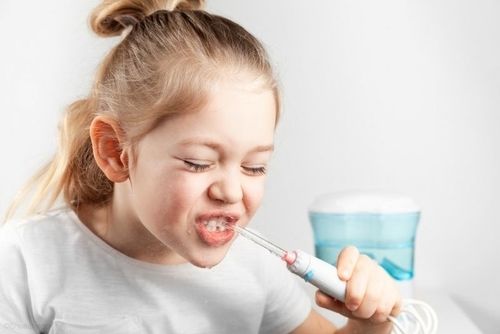
When you visit the dentist, we always know when you have not been flossing your teeth regularly, and the same goes for your child’s smile! It is because when your child neglects their daily oral care, harmful oral bacteria builds up around the gum line and adding insult to injury by hardening (mineralizing) into tartar or calculus, making them vulnerable to gum disease. A great way to avoid cavities and gum disease is by flossing, and nothing is easier than using a water flosser that does most of the work for you!
Water Flossers for the Win!
The great thing about water flossers is that they are a point-and-shoot super soaker instead of trying to maneuver dental floss, string, or tape around the teeth and gumline. Instead, flossers squirt the water stream at the teeth and gum areas. This targeted stream of water gets into crevices to flush out plaque and oral debris left behind after brushing. It is easy and fun to use, and it doesn’t require manual dexterity or skill.
If you have a child who doesn’t like flossing and avoids doing it to the point that you are noticing bloody gums, arming them with a water flosser can save their smile. They will have no more excuses to floss! While not as powerful as flossing traditionally, they are definitely more effective than not flossing at all, which many parents face. By helping them find an effective tool, your child will more likely learn to practice this daily habit. It sets the foundation for a lifetime of healthier teeth and gums.
Bonus Round – Why You Should Get Your Child a Water Flosser?
- Water flossers are inherently easy to maneuver: All they need to do is put the flossing tip in-between their teeth and press a button, and the cleaning will commence!
- Water flossers can be part of their bathing routine: Portable flossers do fine when your child flosses in the bath or shower, so it fits right into their nightly bedtime routine.
- Fun for the kids: Your child would not be the first to see it as a smaller super soaker for their mouth! The water stream is fun to apply and usually feels good in their mouth. Just make sure they don’t use it to target their younger siblings!
- Water flossers are easy to use: Fill up the reservoir with some warm water, have your child pick the tip of their choice, and set the water pressure to a comfortable setting. Show your child how to point the tip between their teeth and how to move along the gum line at a 90-degree angle. Show them a few times how to work it then they will easily be able to take over for themselves.
- Water flossers are perfect for braces: Food tends to get stuck in your child’s braces, and it is hard to remove trapped food particles and dental plaque, leading to tooth decay and gum disease. The water flosser is great for cleaning around each braces bracket, especially using the appropriate tip designed to clean around them. Flushing out any leftover bits of food will effectively remove harmful plaque. Water flossing also works for kids with sensitive teeth.
Bottom Line
Teach your child that flossing with any tool is only half of the job. Brushing is their first line of defense against cavities and gum disease, supported by twice-yearly visits to the dentist for professional cleanings and checkups. We have often stressed that your child should visit the dentist once their first tooth erupts so we can keep an eye on their development and keep track of unique dental needs. A confident smile starts with a healthy one that will set the foundation for a lifetime of smiles!
What Can You Do if Your Child Has an Ongoing Thumb, Finger, or Pacifier Habit?

Your child’s developing smile depends on a variety of things: their diet, oral health habits and even their family tree. Their day-to-day habits can impact their smile if they develop problems because of thumb, finger, pacifier or lip sucking. This sucking is a natural reflex for babies as it helps them feel comfortable and secure and begins before your child is finally born.
As your child grows, prolonged thumb sucking or pacifier use can lead to your child developing “buck teeth” where the front teeth tend to stick out. It can make it difficult for them to close their mouth and lips together, arresting proper speech development. If this effect on their teeth and jaw becomes noticeable, it can also affect their social growth and make them feel shy about speaking.
Sense of Security
Your child’s sucking on their thumb, finger, or pacifier is a common and ordinary way for them to feel secure from the time they are in the womb. It is normal behavior as they grow, and most children do stop on their own between two and four years of age. However, when they don’t stop, this can lead to dental problems (such as protruding front teeth, an open bite, or a crossbite). Their upper front teeth may lean toward the lip or not properly come in at all. It can affect their bite and how their jaws and bones grow, which support their tiny chompers.
Pediatric Observation
Our pediatric dentist can observe your child’s developing smile to keep an eye on how their teeth are erupting and how their jaws are growing. Your child might need help stopping their oral sucking habits, whether from you or our pediatric dental team. When they are old enough to understand, we can explain what can happen to their growing teeth and jaws if your child continues their now unhealthy sucking habit. Your ongoing gentle reminders at home can also help increase their awareness. Sometimes it might be necessary for your child to wear an oral appliance that gets in the way of their habitual sucking patterns.
While normal thumb sucking and pacifier dependence are soothing when your child is an infant, it is a good idea to help them discontinue this habit as they grow to avoid the long-term effects on their growing teeth and jaws. If your child is still in the habit of sucking their thumb finger or pacifier, we welcome you to see our dentist for help.
Our goal is to treat problems early to correct the problem and prevent further issues in your child’s facial development. Guiding the jaw growth helps them better develop their growing smile to avert dental problems by correcting harmful oral habits that can prevent trauma to their front teeth later. Ultimately, you want your child’s teeth to come in straight – not slanted – and their teeth-supporting bone and jaw to be correctly aligned.
Please Call Today!
Our pediatric dentist is happy to keep a watchful eye on your child’s smile development and may recommend intervention when needed. Our dental team will work with your child to understand why they need to give up their sucking habits if they become destructive. We gladly support your efforts to help your child stop sucking their thumb, fingers and pacifier.
If your child is struggling to overcome this bad habit, we welcome you to give us a call today. We offer tips or can schedule a visit where we can meet with your child and check out any problems that could be developing. We are here to help your child have healthy developing teeth and gums for a confident smile!
Celebrate National Children’s Dental Health Month Promoting Water as Nature’s Drink!

When it comes to your children’s smile, there are many things you can do to help them develop healthier teeth and gums. We support the American Dental Association’s (ADA) slogan for 2021’s National Children’s Dental Health Month this February. The slogan is “Water, Nature’s Drink” and encourages all to make water your first drink of choice!
Water is crucial for your child’s body, brain development, and dental health, especially when trying to keep cavities away. Cavities form when your child consumes sugary drinks that allow the oral bacteria to turn the sugar into acid, which weakens their teeth and leads to white spots that can also turn into cavities and serious infections from the decay.
But healthy habits taught and ingrained when a child is young can serve them with a healthier smile spanning their lifetime. And a lifetime habit of turning to water with meals or in between meals can help keep their teeth healthier and brighter as they reach adulthood!
As your child’s smile grows, you want to make sure they brush their teeth at least twice a day using toothpaste. Be sure they floss between their teeth once a day to clear away the oral debris their toothbrush cannot reach. Do not forget to provide them with nutritious food that limits their sweet drinks and snack intake. This daily care, combined with their routine dental checkups, can help your child have a healthier mouth and body.
Why Drink Water?
Your child’s body is made of 60% water. Hydrating with this clear beverage removes waste while distributing nutrients via the bloodstream, regulating their body temperature and helping keep their muscles moving. Water, especially fluoridated water, can help your child’s teeth remain strong. When they drink water, you are giving them nature’s “cavity fighter.” Unlike juices, sodas, and sports drinks, water leaves no unhealthy residue behind that can feed the cavity-causing bacteria in their mouth that wears down tooth enamel.
Clean Their Mouth With Every Sip
In contrast, plain water will help clean their teeth and gums every time they take a sip while diluting harmful acids created by oral bacteria. Water is also your children’s best proponent of saliva production. Saliva acts as their first line of defense against cavities by protecting their smile by fighting dry mouth. Saliva allows them to normally swallow while bathing their chompers in enamel-strengthening proteins and minerals like calcium and phosphate. It also helps balance the Ph level of the mouth. Unlike sweetened drinks that often lead to tooth decay, water protects your children’s growing smile!
If your child likes drinking juice, remember that juices are not always healthy. They are filled with concentrated levels of sugar, providing little in the realm of nutrients. Instead, why not give your child the fruit itself, like apples, pears, grapes, or oranges, so they can get those nutrients along with a healthy dose of fiber. They are especially healthy when combined with tooth-friendly cheeses and fresh vegetables. Every time your child drinks water, it helps remove those stray bits of food particles and oral bacteria that otherwise thrive in the mouth when sugar is consumed. Drinking water is a great way for your child to rinse their mouth between normal daily brushing and flossing.
Join us in celebrating National Children’s Dental Health Month with this year’s slogan, “Water, Nature’s Drink!” to support and promote better oral healthcare. As part of this month’s national health observance, we unite with all professionals, healthcare providers, and educators for your child’s best oral health. Please give us a call if you have any questions or concerns about your child’s developing smile. We look forward to helping create healthy habits for a lifetime of healthier smiles!
Just For Fun: Download the ADA’s 2021’s National Children’s Dental Health Month Activity Sheets for Kids “Water, Nature’s Drink!”
When Was Your Child’s Last Dental Exam? Start the Year off Right by Scheduling Their Next Visit!
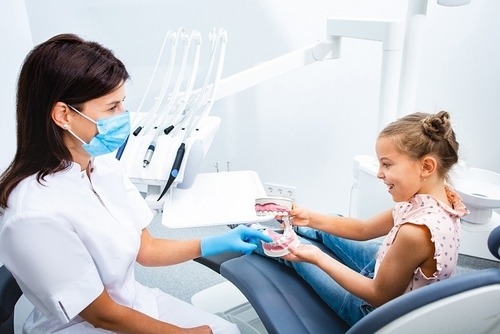
Did you know that the earlier your child has regular dental checkups, the healthier their mouths will be as they grow? Just like you, they need routine dental checkups and cleanings to protect their developing smile from cavities and tooth decay.
Not just for adults
Even your child’s baby teeth are important since they are the placeholders for the permanent teeth coming in behind them. Lack of preventative oral care early on can result in painful teeth, having trouble focusing, chewing, and even talking clearly as your child’s speech develops. Tooth decay in children can lead to a variety of problems, including:
- Dental emergencies
- Missed classes in school
- Lower self-esteem
- Unhealthy tooth development
- Dental anxiety from getting dental fillings
- Poor sleep quality from tooth pain
- Difficulty eating and speaking properly
How often should your child see the dentist?
Once your child’s first tooth erupts, they should be seen by our dentist. Believe it or not, it does not take long for tooth decay to set in, especially if their mouth is not cleaned properly every day. It is important for their teeth to be monitored as they grow to make sure any oral health issues are promptly addressed and corrected. The best way to ensure this is to bring them in every six months for their dental exam.
Avoiding tooth decay in your child’s growing smile can be accomplished by regular dental visits, brushing and the right toothbrush. A good toothbrush fits their mouth perfectly for ease of cleaning and limiting their consumption of sugary or acidic beverages and snacks. The following ages are a general guideline for your child to have their dental exams:
Ages 6 months to 1 year:
Your baby should see the dentist after their first tooth comes in and no later than their first birthday. At their visit, their teeth and gums will be checked, any oral health issues addressed, and their daily oral hygiene routine assessed and updated.
Toddlers, children and teens:
A good rule of thumb means seeing the dentist every six months unless otherwise indicated. Our pediatric dentist is trained and experienced in oral care for children, no matter their age! Our skilled team and our office are geared specifically towards children to help them have the most positive experiences during their time with us, setting the foundation for a lifetime of healthy smiles.
If needed, dental X-rays or other diagnostics may be taken before reviewing your child’s oral hygiene habits, their general health, what they consume on a daily basis, and their current risk of cavities.
We will also make sure to get rid of unsightly stains or plaque deposits. We might show you (or your child) how best to clean their teeth and gums. Fluoride and dental sealants might be recommended to protect their teeth, and their mouth will be checked for sores or bumps. If needed, cavities will be recommended to be fixed, tooth defects addressed, and their upper and lower bite patterns evaluated. As needed, wearing an oral device or having orthodontic treatment may be recommended to correct teeth or bite problems.
As your child enters their teen years, their still-developing smile needs consistent care. Along with maintaining healthy brushing and flossing habits, good dietary habits, the prevention of other oral habits that can harm their dental health may also be addressed. It might include discussing the dangers of smoking or tobacco chewing, oral piercings, eating disorders that destroy tooth enamel, etc. Having their wisdom teeth removed may also be recommended when your teen is 16 or older.
Schedule their next exam today!
As you can see, your child’s dental exams are crucial to a healthy smile as they continue to age. If your child has not been to the dentist in the last six months, now is the perfect time to have them come in and start their year off right! We are happy to schedule their next appointment for you!
You Can Help Your Child Enjoy Healthier Sweets During the Festive Holiday Season!

With the holidays in full swing, many of us are making the season more festive for our children this year by indulging their sweet tooth in treats like mouth-watering pies, home-baked cookies, and decorated cupcakes!
The problem is what our children eat will affect their oral health. A good rule of thumb is to monitor and limit their intake of sugar throughout the year as their smiles continue to grow and develop.
Your child’s smile is vulnerable to sugary treats as their oral bacteria break down sugar, releasing a by-product of acids that wears down tooth enamel until decay and cavities take over, not to mention gingivitis! Thankfully, you can remove excess sugar from your child’s diet even during the holidays to keep tooth decay and gum disease from taking over their smile.
Pro Dental Tip: instead of giving your child hard candies like a candy cane to snack on, offer them a chocolate bar instead that dissolves quickly without keeping their teeth bathed in sugar as long as a sticky treat. You can also serve chocolate-covered strawberries for vitamin C and lower the sugar content by substituting milk chocolate with dark chocolate.
Fortunately, many popular holiday treats can be made healthier by tweaking the ingredients or making less sugary substitutions. One easy tip is to switch from refined white sugar to fruit and nuts that are nutritional and less acidic than sugar! If your kids love hot chocolate, try using semi-sweet or dark hot chocolate with peppermint extract to lessen the amount of sugar.
Healthier Holiday Cookies and Pies
- Gingerbread cookies: Gingerbread cookies taste delicious with half the amount of sugar that sugar cookies are laden with, and adding pumpkin puree to the mix boosts the fiber content and benefits teeth!
- Oatmeal cookies: Adding oatmeal to sugar cookies while substituting applesauce for refined white sugar is scrumptiously healthy for their smile!
- Almond cookies: Almonds are naturally full of protein as well as healthy fats. Just add almond slivers as a topping to boost nutritional intake.
- Pumpkin pie: Pumpkin pies add healthy fiber to every slice! Just halve the amount of sugar and stick to sugar-free whipped topping.
- Nut-based pies: Adding Macadamia nuts, almonds or pecans is great for your child’s smile!
Fruit to the Rescue
Fruits are a healthy substitution when your child is craving sweets, especially vitamin or antioxidant-rich choices like oranges, strawberries, melons, berries, and pears. And even though dried fruit is high in sugar, dried cranberries and oranges make a tasty alternative to candied treats when eaten in moderation.
Dairy Choices
You can soften the sugary effects when your child indulges in sweets by pairing them with soft cheeses or milk. It creates a buffer against the acids released by harmful oral bacteria when consuming sugar. Cheese has less sugar, while dairy can neutralize bacterial acid in the mouth that can weaken precious tooth enamel. Cheese also stimulates saliva flow to wash away food particles, and you can serve it with whole-grain crackers or crisp vegetables.
Stocking Stuffers
You can even treat your child to non-sugary options when it comes to gifts and stocking stuffers. Fun toothbrushes, puzzles, games, small toys, colorful crayons or pencils, books, and stickers are great ways to take your child’s focus off of sugar!
Start the New Year off Right
Limiting your child’s sugar consumption can mean allowing sweet treats after they’ve eaten a meal, followed by brushing and flossing. If they can’t brush and floss right away, rinsing their mouth or drinking water helps neutralize oral acids. During the indulgent holiday season, you can up your child’s oral hygiene game by having them brush three times a day instead of two. The goal is to enjoy this festive season while keeping their smiles healthy and strong for the year to come!
How Can Extracting Your Child’s Impacted Wisdom Teeth Improve Their Teeth and Gums?

As your child’s smile develops, the last adult teeth to show up are the molars in the back of the mouth, aka the wisdom teeth. These teeth may erupt on the top and bottom of their mouth on both sides. They typically come in anytime between ages 17 and 21. While it’s always nice to have enough molars to chew food, sometimes there isn’t enough room in their jaws for their wisdom teeth to stay. They may have jawbone or soft tissue impeding the tooth’s emergence, or their presence can crowd the rest of the teeth and alter their overall bite. Neither are good for their oral health.
Impacted Wisdom Teeth
When your child’s wisdom teeth impact their smile, we will generally recommend taking them out with oral surgery. Rest assured, wisdom tooth removal is a common treatment, and after your child recovers, they will be glad they are removed. Impaction happens when they haven’t erupted yet from their gums, so you can’t see them. Unfortunately, impacted wisdom teeth can cause problems.
- Overcrowding: We mentioned this already, but this can leave your child’s teeth crooked and change their bite pattern. It can eventually lead to cavities, damage their teeth, and even cause bruxism or TMJ issues.
- Pericoronitis: This is an infection in their gums from not being able to clean the partially erupted wisdom tooth. The combination of harmful oral bacteria, bits of food and dental plaque building up around the tooth can leave them with localized infection.
- Cyst development: Impaction and infection can result in a growing fluid-filled sac if left untreated. Over time, the cyst can start destroying the necessary jawbone and require a surgical bone graft to fix.
- Damaging nearby teeth: During a wisdom tooth’s eruption, if your child’s teeth are coming in angling sideways, it can damage their adjacent teeth as they push at those teeth, leaving them with problems taking place below the gum line.
Best Age for Wisdom Tooth Removal
We recommend removing your child’s impacted wisdom teeth at a young age when possible. It can help ensure that their mouth and bite stays healthy. Sometimes baby teeth may loosen and tighten up again, blocking the emergence of the adult tooth behind it, so removing it makes space for that tooth to come in all the way. When primary teeth are not taken out, the chances of wisdom teeth coming through above the primary teeth increase. Orthodontic care may be needed to correct alignment.
Removing a baby tooth begins with taking X-rays of your child’s smile to see the roots and bone structure around the wisdom tooth. Then we can plan their extraction. Your child will be made comfortable with the help of local anesthesia during the removal process. We can administer a sedative. Call us to discuss our sedative options. Then the tooth is removed using tiny instruments, making sure the surrounding bone stays intact. Stitches usually are used to close the area.
Post-Surgery
Keeping your child comfortable after their wisdom tooth removal may be done using anti-inflammatory pain relievers. Ibuprofen, along with antibiotics, may be needed. You can use ice packs to manage inflammation on the outside of the affected area. It will be important for your child to stay well hydrated and stick to eating soft foods like smoothies, soup, cottage cheese, applesauce, and mashed potatoes (and occasionally ice cream). These are easy on the surgical site. Avoid hot foods as well as seeds and nuts. Do not let them use straws or spit harshly to protect the blood clot over the extraction site.
If you have any questions about your child’s wisdom teeth, please reach out to our team today!
Healthy Dental Tips For the Spooky Season!

Halloween is lurking around the corner, but so is the coronavirus, making traditional Halloween parties trickier. This year, big parties and parades, creepy haunted houses, and gathering in crowds to trick-or-treat are off the table for many, or at the very least, downsized and held outdoors while social distancing. While the traditional ways of celebrating Halloween may look different this year, your family can still stock up on Halloween candy and dress up for some squeamishly spooky fun.
Treat Your Teeth
The problem with sweets is that all that sugary goodness can wreak havoc on teeth and gums. When you snack on sugary treats, be sure to rinse your mouth well with water afterward or brush your teeth if possible. Avoid hard, chewy, or extra sticky candies like the plague to avoid damaging dental plaque!
Eerie Count Chocula
Chocolate is a better choice when getting your sweets on, as it melts quickly and doesn’t stress the chompers like taffy, caramel, or other hard, sticky candies typically do. It’s easier to clean chocolate off the teeth unless they are filled with caramel or nougat fillings. Candy season can also be made more tooth-friendly by drinking plenty of water to keep saliva levels optimal. Saliva helps wash away oral debris to reduce harmful plaque. Supply your child with mini water bottles and sugar-free gum when brushing their teeth is not possible. Help your family stick to a healthy diet in general, so teeth and gums stay strong during the treat-laden holiday season for the next three months.
Frightful Family Fun
To protect your child’s wickedly cute smile during this pumpkin season, you can do what some parents do and limit daily candy consumption! Some spread out a trick-or-treating haul throughout the month and make sure they clean their teeth after eating sugary goodies. Others limit treats to a few days around Halloween itself. Having your family eat their candy right after a meal can help minimize plaque and tartar. Whatever works best for you and your family’s traditions, remember to instill in them the lifelong habit of cleaning their teeth after enjoying sweet treats.
Creating Safe Halloween Smiles
Here are some spooktacular ideas to enjoy scaring your loved ones with some wicked good fun!
Tip: If a costume comes with a mask, consider wearing a safety mask under it. Double the mask, double the protection!
- Go all out this year by making or buying fun costumes for your family and taking lots of pictures to share on social media, send to extended family, or display in an album or on the wall!
- Join friends and extended family in a “virtual costume contest” and award prizes and treats that can be dropped off or delivered by your favorite delivery company (Instacart, Walmart or Amazon).
- Host a cool Zoom Halloween party, complete with scary music, games, or dance party for older kids.
- Buy your child’s favorite Halloween candy, plastic spiders and bats, spooky stickers, Halloween-themed pencils, and mini tubes of toothpaste and flosses and let them trick-or-treat door-to-door INSIDE your house!
- Check out your neighbors’ Halloween decorations while driving around, or masking up and walking around to wave at them from the sidewalk. If the neighbors are game, you can use Facebook or NextDoor to vote on the best decorations.
- Paint scary pumpkins and place them around the house or by your doorstep. For extra spooky fun, paint teeth on them and practice “brushing” with your little ones armed with a new superhero or other character-inspired children’s toothbrush just for them.
- Have a Rotten Witch Teeth guessing contest! Fill a clear jar with candy corn and have your kids guess how many wicked witch “rotten teeth” there are!
- Take your family to a drive-thru Halloween haunt! Instead of Christmas lights, you’re getting spooked from frightful Halloween decorations.
- Have a haunted skull glow-in-the-dark scavenger hunt! Fill plastic skulls with mini dental floss and toothpaste, sugar-free candy or gum, glow sticks, bracelets or necklaces, vampire teeth, or plastic spider rings to hunt for in the yard. If you can’t find skulls, mini plastic pumpkins or mummies are also fun!
- Decorate a Halloween candy tree (artificial or real) with creepy lights and treats, including travel-sized dental floss, glow sticks, toothpaste, and more (see ideas above), so kids can grab their own goodies from your porch or yard.
- Parade your child through the neighborhood to show off their cool costume and wave at your neighbors. When you come home, treat your child to a Halloween toy or goody bag instead of trick-or-treating.
- Have some scary family movie nights or a Halloween night macabre marathon with healthy treats. Spooky apple smiles (cored and quartered apples decorated with blanched slivered almond “teeth”), Clementine pumpkins (peeled and topped with a celery stick stalk), and banana ghosts (peeled bananas with chocolate chips for eyes and mouth) are a fun way to enjoy sweet treats safely!
- Anonymously drop off a Halloween goodie bag or decorated pumpkin on the doorsteps of a few friends, family or neighbors to spread some spooky cheer, contact-free! After dark, tip-toe silently to the front door, ring the doorbell, and then “ghost” them by dropping off a ghoulish goodie and hiding or running away.
Harrowing Halloween Fun for Families
Download one of these fun pumpkin carving stencils like Billy the Bicuspid, Count Bicuspid, Frankentooth’s molar, and more as well as Activity Sheets or Coloring Sheets:
https://www.mouthhealthy.org/en/resources/activity-sheets/halloween
From our dental family to yours, no matter how you celebrate Halloween this year, make it safe, healthy, and fun for all!
Ready Your Child for the New School Year With a Back-To-School Oral Toolkit

With the summer of 2020 coming to a close, families have had to adapt to the coronavirus pandemic and conform with state and county regulations. Schooling has been one area where hard decisions have been made with new rules to keep others safe. Whether your child is attending classes in school or online, keeping their smile healthy is paramount no matter what else is going on around them.
Healthy Teeth, Healthy Smiles
School pictures are just one of the reasons why a great smile matters. You don’t want your child grimacing in photos because their teeth hurt! Likewise, if they feel good about their teeth, they will feel more confident to show it off.
Social distancing, wearing face masks, and frequent hand washing will likely keep your child focused and busy on top of their usual day-to-day school activities. Participation in sports, chorus or band practice, extracurricular activities, and social distancing with friends will also be a new arrangement for your children.
Keeping your child’s smile healthy will protect them from missing school from toothaches or other oral issues. If they haven’t already seen our dentist for their back-to-school dental cleanings and exams, now’s the time to catch them up. Addressing tooth problems early will lessen their discomfort, minimize treatment measures and cost less to treat.
Establishing a regular dental routine, no matter what their age, is necessary to keep out tooth decay and gum disease that could cause your child to miss school. Older kids will benefit from having a smile toolkit they can keep in their backpack, and younger kids will enjoy having easy rewards like a sticker chart near their toolkit to track and mark off daily. Preschoolers will also enjoy stepped up oral hygiene by singing two-minute songs with you as they brush. These daily dental habits can reward your children with healthier, happier smiles.
Back-To-School Toolkit
Don’t just fill their backpack with the normal school supplies like paper, notebooks, pens, and pencils; equip them with a smile toolkit for their dental health!
- Always start with products carrying the American Dental Association (ADA) Seal of Acceptance to ensure the product has been tested and is deemed both safe and effective.
- The new school year is a great time to replace their old toothbrush! Keep it gentle on their tooth enamel (and gums!) by making sure it has soft bristles, and the head is compact enough to maneuver in their mouth easily and comfortably. If your child hates brushing their teeth, consider getting an electric toothbrush that makes the job easy and effective.
- Make sure they also have a dental flossing tool that they like using to clean those areas that a toothbrush might miss. Dental floss often comes in fun flavors appealing to children’s taste buds, and oral irrigators can help older children enjoy flossing more, especially if they are also wearing braces!
- Supplying a fluoride toothpaste helps keep tooth enamel strong, and if your child is cavity-prone or has a hard time cleaning their teeth, adding a mouthwash can help remove some of the bad oral bacteria.
- Don’t forget snacks! Replace sugary foods and drinks with more tooth-friendly options. Chopped crisp apples, raw carrots and celery can all help scrub plaque off their teeth. Even sugarless gum and mints can freshen breath while stimulating healthy saliva production.
- If your child is active in sports, don’t forget to add a protective mouth guard to their toolkit. A well-fitting, customized sports guard can keep their teeth and gums safe from injury during physical activities.
Your child’s daily oral habits and routine dental cleanings and exams will go a long way to helping their mouth stay healthy and their smile more attractive. School pictures or not, a cavity-free, pain-free smile will keep your child focused on the tasks in front of them, including their schoolwork. Help them have the best school year yet by giving them the oral health tools their smile needs!
Why Your Child Might Need to Wear a Dental Crown on a Primary Tooth

Your child’s baby teeth usually and gradually fall out as their adult teeth come in. There are times when a baby tooth is so damaged that our dentist may recommend placing a dental crown (a protective cover) over the tooth to save and protect it. Our team would much rather do this than pulling the tooth and leaving it under your child’s pillow for the tooth fairy to add to her collection earlier than needed. You may then wonder why your child would need a dental crown to “cap” a baby tooth?
Why Cap a Baby Tooth With a Dental Crown
The biggest reason is to protect your child’s future oral development. As their jaws develop, spaces from teeth that were extracted prematurely can cause issues when their adult teeth eventually come in and require braces and other costly treatments later.
Cavities are common in children because of tooth decay, and a large cavity that can’t hold a filling can still support a dental crown placed over the damaged tooth. Saving a primary tooth now (even if it has severe decay that a dental filling can’t support) is still worth placing a dental crown. Crowns can protect teeth that may be broken or badly chipped from injury from a hard fall or from playing high impact sports. Having a root canal can also save a primary tooth, as can placing a bridge with a crown over a prematurely missing tooth. A dental crown looks and functions like the rest of their teeth, strengthening and restoring the damaged tooth’s function.
A Dental Crown Effectively…
- Holds space for the incoming adult teeth and guides the adult tooth that will be moving down into its place.
- Helps your child chew the healthy foods their growing body needs.
- Helps your child to speak properly to prevent developmental speech problems.
Protecting Your Child’s Baby Teeth
Just like with permanent teeth, primary teeth need proper daily care. It means establishing healthy dental habits while they are young to set the foundation for a lifetime of healthy smiles! Daily brushing and flossing is the easiest way to avoid cavities in children, along with routine dental cleanings and checkups.
Make sure they know not to chew hard food, including munching on ice or hard candies. When your child is participating in impact sports or recreational activities, make sure they have all the proper safety equipment, including a sports guard. It can help pave the way for your child to have healthy permanent teeth.
Placing a crown on damaged teeth can help your child’s oral development properly proceed. So what kinds of crowns are available for primary teeth? While there are a variety of materials used to create children’s crowns, the location of the damaged tooth typically determines the crown materials that will need to be used.
Common Crown Materials
Stainless Steel Crowns:
- These are strong and long-lasting, making them ideal for the molars in the back of the mouth that must handle the bulk of chewing their food. They also do not corrode and are economical choices.
Alloy Dental Crowns: These are also strong and durable, making them perfect for replacing molars in the back of the mouth. They may be made from gold, nickel, chromium and palladium.
Ceramic Dental Crowns: These are made to match the surrounding teeth, making them ideal for covering teeth in the front.
Porcelain Fused to Metal Dental Crowns: Strong and beautiful crowns made from porcelain fused to metal, these are perfect for both the front and back teeth.
If your child has a damaged tooth that isn’t quite ready yet for the Tooth Fairy, our pediatric dentist is happy to restore its form and function with the help of a dental crown to protect their developing smile. It can save you time, energy and money later to correct dental issues. We welcome you to call our caring team today to schedule a visit and learn more!
Six Smile Safety Tips For Healthy Teeth and Gums This Summer

With summer in full swing, your family is likely busy with a new routine involving cookouts, sleepovers, camping, vacationing abroad, or even just hanging around the house and a staycation. What you’re likely not doing is getting the kids up for school and keeping to an established oral hygiene routine. No matter what your family is doing to enjoy the summer months, the more relaxed schedule shouldn’t apply to your child’s smile habits, at least if you want them to avoid tooth decay and gum disease! Here are six easy tips for keeping your child’s smile healthier this summer.
#1 No Vacation from Good Oral Hygiene
Don’t let your child take a break from their regular school year brushing and flossing routine just because it’s summer. They still need to brush twice a day for two minutes and floss between teeth once daily. No matter what time they wake up during the summer months, make sure they take time to brush in the morning and before bedtime. Set an alarm for them to brush in the morning and at night. Healthy habits followed daily can help keep away cavities and gum disease. You can make this fun by downloading a cool app on your phone or having them watch kids videos about oral health on a phone, tablet, computer, or smart TV.
#2 Summer Traveling Tips
Pack all of your oral healthcare essentials when heading out of town with your children. Tuck in the basics to make sure they are all set: a toothbrush, toothpaste, dental floss, mouthwash, and orthodontic cleaning tools to keep braces, retainers, or mouth guards clean. Don’t forget an emergency kit stocked with orthodontic wax or tool to fix a broken braces wire and an emergency phone number in the area you will be visiting. When jumping timezones, make sure their morning and bedtime teeth cleaning routines are practiced!
#3 Summertime Safety Goals
If your child frequents pools to keep cool during these warmer days, remind them never to run around pool areas, jump into shallow water, or bump into pool edges (especially if they wear braces). Equip them with a sports mouthguard and helmet when engaging in sports or recreational activities. Being reminded about safety can help your child avoid injury to the mouth, chipping a tooth or even having a tooth knocked out. Emergency dental care is something you don’t want to show up on their bucket list!
#4 Summer-Healthy Foods
Being outdoors in the summer is a great way to get some Vitamin D to help your child’s growing body absorb and hold on to minerals that build the bones (like calcium and phosphorus). Vitamin C helps promote healthy gums, so be sure to include orange juice along with their milk, cereal, and yogurt for a healthier mouth. What you don’t want them overindulging in is sugary treats and drinks. A steady diet of lemonade, soda, and ice cream only increases plaque buildup and cavities. Keep healthier snacks in the fridge or a bowl on the countertop when they wander through the kitchen, looking for easy-to-grab snacks.
Summertime Snacks:
- Cheese, Greek yogurt
- Meat and cheese roll-ups
- Carrots, celery, peppers, broccoli
- Apples, pears, oranges, watermelon
#5 Cool Off With Water!
Water is the healthiest drink for your child’s overall and oral health. It keeps them well hydrated so their saliva levels can wash away bacteria hiding in the mouth. Tap water has the added benefit of fluoride, a mineral that strengthens tooth enamel. Minimize sugar exposure on their developing teeth such as soda, fruit juice and sports drinks. These are also acidic, which wears down tooth enamel, leaving them prone to cavities, tooth sensitivity (like popsicles), and even tooth stains.
#6 Summer Dental Cleanings & Checkups
Bringing in your child for their bi-annual checkup and cleaning couldn’t be easier than during the summer. You don’t have to worry about interfering with school or sports schedules. It is a good time to reinforce good dental hygiene habits with a visit to the dentist to take care of any problems before school starts up again. If you need to schedule your child’s next dental visit before the summer ends, give our team a call today!
Dental Healthy Snacks for Your Child This Summer!

Summer is a great time to encourage your child to eat better. Serving healthy meals and snacks provides needed nutrition while supporting healthy eating habits. Tooth-friendly snacks can help keep cavities, gum disease and other health conditions like obesity and diabetes from developing. Let’s dive into a healthy summertime “menu” to help your growing child’s smile thrive!
Most Important Meal of the Day
Healthy breakfasts are easy to make while delivering the energy boost they need to start their day. Enlist their help to make their food, so they learn good habits along the way! Fruit smoothies, fresh fruit and eggs are healthy alternatives to store-bought sugar-laden cereals. Whole-grain pancakes, waffles, or French toast are delicious and nutritious, especially when topped with fresh fruit and nuts instead of syrups. Nuts and seeds deliver healthy fats, vitamin D, calcium, fiber and folic acid to your child’s diet. Other breakfast favorites include:
- Scrambled eggs with spinach, wrapped into a breakfast burrito
- Whole-grain muffins with nuts and yogurt
- Yogurt with fresh fruit
- Cooked oats with fruit and nuts
Lunch and Dinner Is Served
Lunches can be quick to make and fun to eat. Tortillas filled with your usual sandwich favorites are a healthy and satisfying alternative. Brown rice, whole-grain pasta and salad are all nutritious summer choices. Don’t forget to fire up the grill for delicious meats and vegetables!
- Bell peppers: Take out the seeds and cut into quarters.
- Onions: Peel and quarter them.
- Yellow squash, zucchini, and eggplant: Cut lengthwise into rectangles.
- Portabella: Take off the stems and cut in half.
- Asparagus: Cut off the tough ends.
- Tomatoes: Small tomatoes still on the vine helps you pick them off the grill.
Throw them onto a skewer, and you will have a yummy kabob! Meat and fish provide phosphorus to keep your child’s growing teeth strong. Add grilled chicken or tuna to salads with beans or lentils as well as any vegetables in season.
Crunchy Snacks
Forgo potato chips and other carbohydrate-filled snacks that bathe your child’s teeth in bacterial acids leading to tooth decay. Crisp fruits such as apples and pears are loaded with vitamins, antioxidants and fiber your child will enjoy. Keep containers of cut-up vegetables in the fridge for your child to grab when they’re hungry in between meals. Crunchy vegetables like carrots, cucumbers, celery, green peppers and broccoli are nature’s toothbrushes since chewing them scrubs the teeth and stimulates healthy saliva production to wash away sticky plaque. They are also high in water, so they help rehydrate their growing bodies.
Got Milk?
Another great snack between meals is cheese, which provides calcium and phosphorus for their teeth. Diced cheese or cheese sticks can be kept within easy reach of your child to grab from the fridge, and it pairs easily with fruit and vegetable slices. Cheese, milk, and yogurt are low in sugar, so they protect tooth enamel and help prevent gum disease!
Milk gives your child’s smile the calcium and vitamin D their teeth need while water hydrates the muscles, organs, and mouth and boosts saliva production (this protects the enamel and fights tooth decay).
Tooth-Friendly Snacks
- Celery with flavored cream cheese
- Variety of fresh fruits such as berries, watermelon, bananas, oranges, peaches, and cherries
- Pair carrot sticks, cucumbers slices, celery sticks, broccoli florets, or cherry tomatoes with ranch dip, hummus, cottage cheese, or salsa
- Veggie pockets made from whole-wheat pitas cut in half and stuffed with veggies, hummus, bean dip, or dressing
- Tortilla wraps filled with cream cheese and sliced turkey or ham
- Yogurt (drinkable, regular or frozen) paired with fresh fruit
- Whole-grain crackers and cheese
What to Drink?
Limit their access to soda and sports drinks since they leave their teeth coated in sugar and acids. Instead, flavor their water by infusing it with berries, apples, pears, watermelon, or cucumber slices. Citrus fruits are tasty, but they should be limited as they weaken tooth enamel if regularly consumed. If they drink through a straw, remind them not to chew on it.
Invite your child to help you organize their snacks or craft them into fun and different shapes. Your child’s teeth can stay healthy and their tummies happy this summer by making their meals and snacks dental-friendly! Please call our office if you have any questions about your child’s oral health or to schedule their next appointment.
Don’t Let Your Baby Suffer the Effects of Baby Bottle Tooth Decay

Did you know that tooth decay can develop as soon as your baby’s first tooth comes in? Your baby’s tiny chompers are important to their oral development. Losing their teeth to decay prematurely can cause the rest of their teeth to shift out of place by taking up space needed by their adult teeth when they are pushing through the gums.
Tooth Decay in Infants?
Decaying baby teeth is actually the most prevalent infectious disease in childhood and is referred to as baby bottle tooth decay. Even though their teeth are tiny, tooth decay in babies can often be costly and painful and leave them vulnerable to serious infection. By practicing daily oral care early on, your child will have the best chance at a healthy smile. The American Academy of Pediatrics (AAP) encourages parents to know what causes infant tooth decay, watch out for telltale signs of decay and actively prevent these dental caries from developing.
Baby Bottle Tooth Decay
Baby teeth are vulnerable to sugar’s pitfalls from the drinks they constantly consume over time. If that sugary coating isn’t cleaned off of their tiny chompers daily, decay can set in. Think about the liquids your baby consumes daily, most likely milk, formula, fruit juice, soda and more via their bottle. As the liquids bathe their teeth and gums in sugar, the bad bacteria in the mouth feed on it, leaving a sticky film in their mouth called plaque.
Plaque can form around their tiny teeth even if they are breastfed if they drink for long periods of time without having their teeth cleaned during the day. And of course, you never want to dip their pacifier in any kind of honey, syrup or sugar for all the same reasons. So when your baby goes down for the night or long daytime naps, don’t settle them to sleep with a sugar-filled baby bottle marinating their teeth in sweetness.
Keeping Away Cavities
You can keep cavities from invading your infant’s smile by practicing the following:
- Don’t let your baby fall asleep with milk, formula, juice or other sweetened liquids in their bottle.
- To change their bedtime bottle ingredients, you want to slowly introduce the non-sweetened contents by diluting their drink with water. This can take anywhere from two to three weeks to make the switch. This will help them get used to it without making them fussy.
- Ultimately, the goal is to give your baby a bottle containing only water. You can also give them a clean pacifier.
- During the day, it is also a good idea to lessen their dependence on sweets, particularly if they are snacking between meals.
- Using a clean, moistened washcloth or gauze, wipe their gums once a day and gently massage them to help with teething.
- When your child’s first tooth comes in, you can brush the tooth with a soft toothbrush and a rice-sized amount of toothpaste. As your baby develops and is able to spit, you can use fluoride toothpaste.
- Bring your baby to our dentist for their first dental visit anywhere from 6 to 12 months, especially if a tooth has come in.
- When your baby is old enough to drink from a sippy cup, you can wean them completely off the bottle.
Sugar vs. Saliva
Baby bottle tooth decay can seriously impact your little one’s oral development. When they sleep, their saliva production slows down, so it isn’t as effectively washing away the sugary liquids that may be coating their teeth. If plaque is allowed to accumulate without being removed daily, decay can set in and cause them pain. If their teeth are severely decayed from a long-term lack of oral hygiene care, they will likely need to be extracted.
The best thing you can do for your baby’s developing smile is to help them establish lifelong daily oral hygiene habits. This can help them have the strong and healthy teeth they deserve!
Games and Tools You Can Use at Home to Motivate Your Kids to Clean Their Teeth Twice a Day, Every Day!

When it comes to your smile, no matter whether you are 5 or 55, you need to be brushing your teeth twice a day for two minutes at a time. Teaching your child the importance of cleaning their teeth daily for the rest of their lives will help them keep their pearly whites healthy for a lifetime.
Getting your child on board early on means making it a fun task for them instead of a chore. Incorporating simple ways to get your child to look forward to this time of day will help them brush twice a day for two minutes each time. You can enlist their cooperation with smiles, not scowls!
Make Daily Oral Hygiene a Blast
Let your little one pick their child-sized toothbrush at the store with their favorite character, hero or color. You can get a sticker kit so they can decorate their toothbrush, or get them a toothbrush that lights up and blinks while they clean, or one that plays music for two minutes to help them brush the right amount of time. Top this off with their favorite flavored toothpaste they pick out themselves, whether it’s bubble gum, fruity flavors, or fresh mint.
Let the Brushing Begin!
Set a funny egg timer to brush until the sand reaches the bottom. You can join them by brushing your teeth with them, play a song they like, or have them sing to their toothbrush “microphone” while brushing and make funny faces in the bathroom mirror. The idea is to show them that the important task of cleaning their teeth every day doesn’t have to be dull or boring!
Sing Some Tunes
Make songs together, like this one that you sing to the tune of the “Twinkle, Twinkle, Little Star” song:
Twinkle, twinkle, little tooth,
Brush your teeth and floss them, too,
Gently up and gently down,
Keep your teeth clean, no more frowns.
Twinkle, twinkle, little tooth,
Now your smile shines bright like you!
Other games include letting your child brush their doll (or stuffed animal’s) teeth while you brush their little chompers. Cheer as they clean their teeth when sections are done: “Yaaaay, the top row is sparkling!” or “Those bottom teeth are bright like the sun!” You can also reward their efforts by letting them pick a book to read after brushing. Make this fun so they feel good while spending this important time with you.
Download Apps:
– The free Brush DJ app plays songs for two minutes, exactly how long they should be brushing.
– The Heroes of Hygiene app turns cleaning into a game to keep your child’s attention for two minutes; they can even choose the character they like best as their partner-in-brushing.
– Oral-B Disney Magic Timer has 23 of your child’s favorite characters from Disney, Marvel or Star Wars. They can get a new digital sticker after their two minutes of brushing and keep track of their progress with stars and badges.
Make Flossing Fun
As soon as two teeth touch as your child’s teeth come in, they should be flossed to keep plaque away. Until their hand-eye coordination is developed, you’ll need to help or floss for them until they can do it. The good news is even flossing can be fun!
Egg Carton Mouth: Turn a plain egg carton into “teeth.” Gather an empty egg carton, white paint, play dough and dental floss. After painting the egg carton white, you can fold it in half so that it looks like a mouth with top and bottom rows of teeth. Next, stick some pieces of play dough randomly between the teeth. Challenge your child to use the dental floss to get the playdough out of the teeth.
Reinforcing How Brushing and Flossing Work
Play the Nutella and Rubber Gloves Plaque Game where you show your child how hard it is to get rid of plaque (hazelnut spread) on their teeth (a rubber glove). Hand them a toothbrush and flossing tool and let them clean it off. When they’re done, tell them this is exactly what they are doing every time they clean their teeth!
You might be surprised at how fun your child can be when practicing this life-changing habit. Together, you can help them fall in love with this daily oral hygiene care that will serve them for the rest of their lives. Please give us a call if you have any questions or concerns about your child’s smile!
Navigate the Teething Territory and Help Your Baby

When your baby’s first tooth starts to make its debut, you will likely know. This milestone can be simultaneously exciting and worrisome if your baby experiences discomfort as the tooth breaks through the gums. And when your baby is uncomfortable, chances are you will be, too!
If your baby is teething, you can feel swollen places on their gums when you run your finger along the gum line. Normally, the first teeth to show up are the lower front teeth, and then the ones right above them. By the time your little one turns three, they will likely have all 20 of their primary teeth. Other signs that herald this momentous event include:
Teething Signs
– Crying & fussiness
– Drooling excessively
– Biting or gnawing incessantly
– Running a low-grade fever
– Refusing to feed
– Rubbing their ears
– Breaking out in a rash on the chin
– Waking up during the night
Typical Teething Timeline
Primary (baby) teeth can emerge anywhere from six to nine months. For others, it can start as early as three months or as late as 12 months, and they tend to show up in stages. By the time they are 24 months, they should have all 20 primary teeth.
6-10 Months: Lower Front Incisors
8-12 Months: Upper Front Incisors
9-13 Months: Upper Incisors Flanking the Central Incisors
10-16 Months: Lower Incisors to Balance the Upper and Lower Incisors
13-19 Months: Upper Molars
14-18 Months: Lower Molars
16-22 Months: Upper Canines
17-23 Months: Lower Canines
23-31 Months: Lower Second Molars
25-33 Months: Upper Second Molars
Helping Your Baby Feel Better
These are all signs that your baby’s teeth are pushing through the gums, and there are measures you can take to make this process easier on them (and you).
– Providing a chilled washcloth, water-filled teething ring or pacifier can provide gum relief (keep these cooled, not frozen).
– Offering cooling foods like applesauce, peaches, or bananas or a bottle with chilled water.
– Occasionally apply infant analgesic gel on your baby’s gums.
– Administering baby Tylenol at bedtime can relieve fever and give them a better night’s rest.
– Keep their chin and mouth dry or dab on some lotion for a rash.
These symptoms can generally show up around four days before you can see the tooth coming through the gums and can linger for around three days after as it presses completely through the sensitive gum tissue.
When your child’s baby teeth come in, they will help them smile, chew, and develop their speech properly! Be sure to bring your child in for their first pediatric dental visit after their first tooth emerges, or by their first birthday. It will allow our dentist to make sure their mouth is developing as it should for a healthy smile. We are happy to help you take good care of your baby’s smile, and invite you to give us a call today to learn more!
Cavity-Fighting Dental Habits Can Save Your Child’s Smile

February traditionally rings in Valentine’s Day with hearts, chocolate, candy, flowers, and stuffed animals, but it is also National Children’s Dental Health Month (NCDHM)! Long after Valentine’s goodies are gone, your child’s healthy smile can last a lifetime.
NCDHM is sponsored by the American Dental Association, and each year the campaign targets a different dental health goal. February 2020’s theme is, “Fluoride in water prevents cavities; get it from the tap!”
You may not know it, but the most chronic childhood disease in the United States is tooth decay. NCDHM’s 2020 campaign brings dental health professionals around the country together in a common goal: encouraging caregivers, parents and teachers to provide children with the healthy start they need for healthy smiles.
Fluoride Helps Prevent Cavities
2020 is the 75th anniversary of adding fluoride to local water supplies around the country. Grand Rapids, Michigan, was actually the first city in the world to add fluoride to its drinking water, all the way back in 1945.
Additionally, the Centers for Disease Control and Prevention (CDC) confirms that adding fluoride to our tap water is one of the top 10 public health achievements of the 20th century! Thanks to this life-changing decision, you can follow this year’s NCDHM goal of having your child get fluoride from public tap water to prevent cavities.
Protecting Your Child’s Teeth
Protect Your Child’s Tooth Enamel: Tooth sensitivity because of worn or damaged enamel can expose the sensitive layer of dentin below, resulting in pain. Fluoride keeps oral acids from breaking down tooth enamel. Along with diligent daily brushing and flossing, this prevents de-mineralization of the tooth as well as decay.
Remineralize Teeth: Healthy teeth have protective minerals like calcium and phosphorus that fight off acid attacks, which is why our dentist may recommend fluoride treatments for your child. Fluoride helps protect precious enamel by adding those minerals needed for healthy teeth.
Prevents Cavities: Fluoride keeps your child’s teeth healthy and strong. Have your child drink more tap water, and if needed, ask our dentist if a fluoride treatment can help your child’s teeth win the war against cavities!
We support this goal, and we encourage brushing and flossing, providing healthy snacks for your child, and routine dental visits during the year. When it comes to teaching your little ones healthy oral hygiene habits, these can set the foundation for a lifetime of healthy grins.
6 Tips for Your Child’s Healthy Smile
- 1. Help your child brush twice a day using fluoride toothpaste.
- 2. Make sure your child cleans between their teeth every day.
- 3. Provide your child with a nutritious, balanced diet for healthy teeth and gums.
- 4. Offer healthy snacks like fresh fruits, vegetables, and water; limit sugar-laden sodas and juices that only feed oral bacteria.
- 5. Take your child to their first dental visit after the eruption of their first tooth.
- 6. Make sure your child sees our dentist every six months for routine checkups and treatment.
Your child’s teeth are vital for their dental health and emotional wellbeing, even those baby teeth that hold space for their permanent teeth. Pain from cavities can make it difficult for your child to chew, eat, and sleep, and even result in missed school days. Help prevent this from happening by encouraging your child to drink tap water with cavity-fighting fluoride to help them maintain a healthier, confident smile!
Discover the Importance of Dental Sealants for Your Child’s Healthy Teeth and Smile!

When your child’s permanent (adult) teeth begin emerging around the age of six, you can expect these teeth to last them for their lifetime. Protecting their adult teeth becomes a priority, and that’s why they need to be brushed and flossed as their teeth erupt so they don’t succumb to plaque, cavities or tooth decay with age.
Brushing and flossing thoroughly is harder to do on the chewing surfaces of your child’s back teeth. The good news is, you can supplement their daily hygiene care of removing plaque and food debris along with their biannual dental visits to remove remove tartar. Simply ask our dentist if you can have dental sealants applied to your child’s molars during their next checkup!
What Dental Sealants Are
Dental sealants are protective barriers made of a plastic material coating the chewing surfaces of your child’s permanent back teeth. These hard-to-reach (and-clean) teeth are responsible for the mouth’s major chewing activity as they chew and grind up food.
The molar’s top surfaces are grooved with crevices and pits — a prime hiding place for harmful bacteria and acids that cause tooth decay (or pit-and-fissure decay). For this reason, it’s typically the molars that are cavity-prone, and if you already use fluoride to protect against tooth decay, dental sealants can add an effective extra layer of protection.
How Sealants Work
When the molars trap food and oral debris in their grooves and pits and aren’t properly removed because of their location in the back of the mouth, dental sealants can provide protection for those teeth. The resulting smooth enamel effectively prevents bacteria from adhering to their surfaces.
Sealants are painless to apply and can last up to 10 years. This is a significant return on your investment in your child’s oral health. During their routine dental cleanings, we will check for any chips or worn areas of the sealants and fortify them with additional coverage if needed. By the time your child reaches adulthood they will have had time to establish healthy oral hygiene habits to help their teeth last for a lifetime of smiles!
Placing Your Child’s Sealants
The molar will be prepared by cleaning and polishing to clear out the surface fissures. Then the tooth will be isolated and dried, preparing for the etching, rinsing and drying of the tooth. Next comes the application of the dental sealant material with a brush, and then curing with light to bond the sealant to the tooth’s surface. Finally, the tooth will be checked to make sure the hardened sealant is completely applied.
Since your child gets their first set of molars around age six they should get dental sealants when they first come through. When their second set of molars (around age 12) erupt, those should also get dental sealants.
As your child grows, your ongoing efforts to protect their developing smile by preventing dental problems early can help their permanent teeth stay healthier, longer! If you would like to learn more about dental sealants for your child, we welcome you to speak with our dentist to determine if your child is a candidate for this treatment. Your child’s healthy, beautiful smile is worth it!
Start New Year’s Off by Teaching Brushing and Flossing

This time of year, your child is likely consuming lots of sugary treats like candy canes, cookies, cupcakes and more. While you know sugar is bad for your child’s smile, convincing them of that might be a little harder. Instead, focus on teaching them how taking good care of their teeth is good for them!
Teaching your child how to brush and floss daily will help them develop good habits that form the foundation of a healthy smile. Here are some ways you can help them make this daily habit more fun so they will look forward to it!
Brushing
Your child likely loves to copy what you do. Brush your teeth with them for two minutes every morning and night (set a timer or play their favorite song). This will keep them moving the brush over each of their teeth to make sure no tooth is missed. Have them hold the toothbrush at a 45-degree angle and press gently against the gum line, cleaning the bottom of the tooth all the way to the top and the back so all of the tooth surfaces are cleaned.
Tip: Give them soft-bristled child’s toothbrush with their favorite cartoon character or color and let them pick it out a kid-friendly toothpaste. Reward your child with a new toothbrush when they reach their goal of brushing every day for a set amount of days.
Flossing
You should begin flossing your child’s teeth when two teeth are too close for their toothbrush to fit. Floss once a day to get rid of stuck food particles between teeth. You can use dental floss between the teeth, sliding gently back and forth and curving around each tooth, and wiping up and down in a C-shape. Children’s plastic flossers are also great and are made just for their little mouths. For older children, there are floss sticks in a variety of flavors and colors.
Tip: Keep a chart of your child’s daily brushing and flossing record and when they reach their goal, reward them with a fun sticker or toy.
Try these brushing and flossing tips to get your child on the daily oral hygiene bus:
– Rinse with a child-approved mouthwash: Some can change the color of dental plaque so your child can see where they still need to brush better.
– Enlist an oral hygiene buddy: Appoint your child as the dental caregiver for their favorite toy (a much-loved doll or stuffed animal). Arm them with a small toothbrush so they can practice on their toy while learning how to take care of their own chompers.
– Have a suds-and-bubble-making contest: Squeeze some extra toothbrush onto your brushes and then see who made the most bubbles when the timer goes off!
– Story time role play: Plaque and bacteria are the bad guys, and your child is the hero who has to brush and floss thoroughly to save their teeth. Of course, this is a daily battle they choose to win!
– Sing and/or dance in a bathroom karaoke: This performance is done while brushing to rid your child of excess wiggles and giggles while polishing their tiny chompers.
We hope you are inspired to turn your child’s oral health care into a fun daily practice! You are teaching them how to care for their smiles to serve them for the rest of their lives. For more information about taking care of your child’s oral health, please reach out to our pediatric dental team today!
Set Up Your Child’s First Dental Visit Today
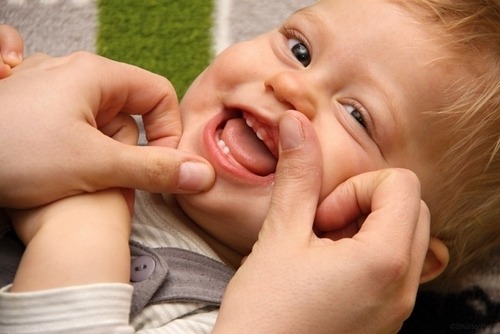
As a parent, it is an exciting time when your child’s first baby teeth erupt, signaling that their smiles are developing right on time. Even though these primary teeth will eventually fall out to make room for their permanent adult teeth, these baby teeth are important to your child’s dental development.
Baby’s First Dental Visit
A healthy oral environment is crucial for your child’s growing smile, and this means cleaning their tiny chompers when they first break through the gums. It is also the time to bring your child to their first dental checkup, or at the latest, by their first birthday. American parents tend to take their children to their first dental visit when they are toddlers between 2-3 years of age; this is actually late in the tooth development game because cavities can already be lurking in their mouths!
What Cavities?
Unfortunately, baby teeth are vulnerable to tooth decay, just like their adult counterparts. This is especially the case if your baby constantly has sugary foods and beverages that sit in the mouth without having it cleaned out. It often happens with bottled milk or juices that aren’t cleared off their gums every day. This sugary environment feeds the harmful oral bacteria in the mouth and will eventually wear down and weaken precious tooth enamel. Enamel erosion happens because of the acids that are released from thriving oral bacteria, which then attacks the teeth.
The American Academy of Pediatric Dentistry (AAPD) promotes bringing your baby in for their first dental checkup within six months of their first tooth erupting (somewhere between six to twelve months). Some parents don’t consider the need for protecting baby teeth because they will ultimately fall out, but these primary teeth actually play a vital role in their oral health.
Baby’s Primary Teeth
– These act as biting and chewing agents so that your baby can get the crucial nutrients their food provides.
– They assist your child as their speech develops.
– Your child’s primary teeth act as place holders for their adult teeth coming in behind the baby teeth.
– Another advantage of taking care of your child’s primary teeth is they assist their developing sense of self, so they can be confident as their teeth show up.
Ultimately, these primary teeth will complete their role as the adult teeth come in, and they fall out to make room for their secondary teeth. You can watch for this to happen around age six, and then let the teeth fall out on their own to minimize pain and bleeding. Teeth that are extracted or lost because of trauma can be painful and messy.
Baby’s Dental Health
Your baby’s developing oral health sets the foundation for their future dental health. A healthy smile is free of cavities at any age, and daily oral care is a habit that your baby needs to develop for the rest of their lives!
Seeing the dentist early will allow our team to check your baby’s smile to make sure it is developing correctly and take care of issues early when treatment is less invasive and most effective. We are happy to address any concerns you may have about your infant’s growing smile, and our team is happy to show you how to properly clean your baby’s teeth. To learn more, or schedule your child’s first dental visit, give us a call today!
Losing Baby Teeth: Make This Milestone in Your Child’s Life a Fun One!

Happy October, everyone! It’s one of the spookiest seasons of the year, and one of the scariest things we can think of is having problems with our teeth and gums. Since October is National Dental Hygiene Month, we want to promote a healthy mouth for everyone by acknowledging the importance of your daily hygiene efforts. Healthy teeth and gums are the foundation of a healthy, beautiful smile!
Plaque
The mouth is full of living bacteria, some of which feed and thrive on carbohydrates and sugary drinks. These can release acids mixed with saliva and food particles to create a sticky bacterial film (plaque). As plaque builds up, it attacks and weakens tooth enamel, working its way through the softer dentin and tooth pulp below it to create decay and cavities.
Teeth with extensive decay often require a root canal treatment to save the tooth from the severe infection that has taken root. A root canal removes the bad bacteria and dead tissue that might otherwise require extracting the tooth.
Signs You Might Need a Root Canal
– Tooth pain or pain when chewing
– Sensitivity to hot and cold food and drinks
– Sensitive gums
– Gum infection
– Darkened or chipped teeth
– Swollen lymph nodes
– Oral trauma
What You Can Do
Did you know that the first known bristle toothbrush was invented in China in 1948? Unlike the smooth nylon-bristled brushes we use today, the original toothbrush used boar hairs attached to bamboo or bone handles. We don’t know about you, but we’re grateful for today’s toothbrushes!
To prevent damaged teeth, you’ll want to start by protecting your mouth from plaque. For example, drinks like soda, fruit juices, sports drinks, carbonated water and other acidic and sweetened beverages are pretty much a lifeline for oral bacteria that attach your teeth. To lessen plaque, limit these beverages, and when you drink them, use a straw to reduce contact on tooth enamel. Better choices include water, milk, low-sugar vegetable juice, and unsweetened green and black tea.
This year’s National Dental Hygiene Awareness Month focuses on four habits you need to practice daily:
Brush
Brush your teeth twice a day for two minutes each session with a soft-bristled toothbrush (no boars hair!). You want to gently clean them without harming the enamel or soft gum tissues. Make sure the head and shape of the brush fit comfortable in your mouth so you can get to the back areas to remove bacteria and food particles. Hold your brush at a 45-degree angle to your gums. Using short strokes, move your toothbrush back and forth to clean all tooth surfaces – outside, inside and the top of the molars – where the food is chewed. Make sure to clean those grooves and crevices. Use up-and-down-strokes to clean the inside of your front teeth.
Tip: Don’t forget to brush your tongue to get rid of plaque and freshen your breath.
Floss
Clean between your teeth once a day using a flossing tool of choice (one that makes you want to floss every day) to get rid of dental plaque your toothbrush can’t reach. Plaque buildup will cause it to harden into tartar or calculus, which has to be removed by a dental hygienist using special tools.
Rinse
Some areas of the mouth can’t get rid of plaque by brushing and flossing alone. Rinsing with an antibacterial mouthwash daily destroys bacteria to prevent tooth decay and gum disease (infection of the oral tissue) from gaining hold. Your dentist can recommend a non-alcoholic antimicrobial rinse that is right for your needs.
Chew
Speaking of dry mouth, did you know that chewing sugarless gum for 20 minutes after you eat lessens the chances of tooth decay? That’s because chewing stimulates saliva glands to promote healthy saliva flow. Your saliva plays a vital role by rinsing away food particles and bacterial debris and neutralizes the acids from oral bacteria.
This month is a good time to toss out your old worn-out toothbrush and find a flossing method you will enjoy using every day. You’ll also want to thank your dental hygienist the next time you see them for all their efforts to make your smile the best it can be!
Losing Baby Teeth: Make This Milestone in Your Child’s Life a Fun One!
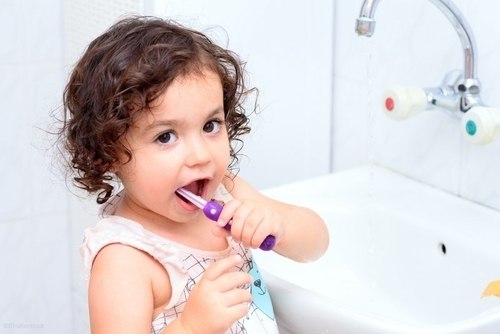
What do your child and a crocodile have in common? Both grow new teeth when the old ones fall out! Okay, your child’s permanent teeth come in when their baby teeth fall out, so technically they only grow new teeth once. And after their 20 baby teeth fall out, 32 adult teeth replace them (whereas a crocodile could replace 8,000 teeth in their lifetime).
Unlike a crocodile, your child will need to take good care of their teeth to prevent decay. Just because they will be replaced eventually, primary teeth still play an important role in your child’s oral development – how they chew their food, help maintain your child’s facial shape, assist in their speech and of course, make them look adorable.
When Does It Start?
You can expect your child’s baby teeth to loosen around age five or six as the tooth roots dissolve, but they can start to fall out when they are as young as four or old as eight. As long as it’s not from decay or injury, they should be fine, especially if it is one of the bottom front teeth.
When a baby tooth starts to loosen, it can take a few months for it to fall out. Don’t worry if it happens when they’re eating or sleeping, and gets swallowed, it won’t harm them. Conversely, a loose tooth could hang around by a thread for weeks. We recommend letting the tooth fall out on its own and letting your child wiggle it with their tongue if they can’t resist. Just don’t force the removal in case the tooth root is still connected, you don’t want it to break and get infected. Gently brush the loose tooth to keep it clean, and if the gums are tender, you can serve them soft foods (although crunchy food could help the tooth fall out faster!).
Making It Fun
Losing a tooth is an exciting milestone for your child, much like learning to read or ride a bike. Making it a fun experience will leave you both with happy memories, especially if your child is also nervous. Let them know that everyone loses their teeth and that their adult tooth is moving up the jaw and causing the baby tooth to fall out. Reassure them they will get replacement teeth located just underneath the gums and that the baby tooth served its purpose by guiding the adult tooth into place.
Most children in the U.S. look forward to the tooth fairy visiting while they are asleep and leaving a monetary gift like a gold coin under the pillow as payment. Some parents leave construction paper fairy footsteps near their child’s bedroom window, a trail of glitter “fairy dust” on the windowsill, a note with colorful stickers from the tooth fairy (encouraging good hygiene for future healthy specimens), or a little bag or tiny pillow for the next tooth that will fall out. If it’s their first lost tooth, a fun new toothbrush instead of money is a fun idea! Losing a tooth is a big deal for your child, and making it magical will make the event fun for everyone.
Protecting Your Children and Their Smiles

As your children and teenagers are headed back to school, you might be giving them a pep talk concerning the choices they make and avoiding influences like alcohol, drugs and tobacco. We all know there are multiple reasons why these items are not good for your children, but how does it affect their dental health?
Alcohol
Alcohol is also something many teens experiment with, which can contribute to mouth cancer as well as tooth enamel erosion and cavities when consumed often or in great amounts. It’s important to emphasize to them that there is a reason why there is a specific drinking age, so the teeth can more fully develop.
Drugs
When it comes to illicit drug use, if teens are using them regularly, they are subjecting their oral health to side effects such as dry mouth which causes halitosis, dental erosion, tooth decay and gum disease. Another side effect might be teeth grinding (bruxism), which can also lead to worn down enamel. Some drugs increase cravings for sweets and soda, which puts them at greater risk for dental cavities.
Tobacco
Teens who use tobacco or smoke can find themselves with chronic bad breath and stains on their teeth since both cigarettes and other forms of tobacco contain nicotine and tar. They can even invite more damaging results such as gum disease, tooth loss or cancer of the mouth.
Vaping
Similar to cigarettes, vaping or e-cigarettes are considered a “safer” option for some people since it’s a vaporized form of tobacco smoke. In reality, they are not any safer and can have just as many harmful effects. They can cause inflammation that could lead to gum disease and other teeth and mouth problems. Many people develop painful sores, lesions and sore throats from vaping.
What You Can Do
Many of these activities – if not all – can result in costly repairs and suffering for years to come. We want to help your teen prevent any long term effects by emphasizing the importance of avoiding alcohol, drug use and tobacco, at least until their teeth have fully developed. Some things you can do to protect your children and teens include the following:
– Discuss the risks of these kinds of choices
– Practice good oral hygiene (brushing twice a day, flossing once a day)
– Regularly visit their dentist
– Set a good example; avoid tobacco use or vaping (or even stop altogether for your own health benefits!)
To protect your child’s dental health, be sure to explain the disadvantages and how they can create a great smile to last for years. If they need more convincing, we’ll be happy to give you and your child more information on the effects of these products. Feel free to give us a call today to set up an appointment or ask us any questions. We are happy to help!
Does Your Child Need a Dental Crown?

If your child has a badly decayed primary or “baby” tooth that can’t be fixed using a dental filling, our pediatric dentist may recommend placing a dental crown. These are “caps” that are created to fit over the top of a tooth that has been damaged and will restore its function and appearance by strengthening the tooth.
Dental crowns are placed onto primary teeth when losing them might cause problems with speaking and eating properly, as well as maintaining space for the permanent teeth to grow into their correct position. Crowns also allow the proper development of your child’s jawbone and muscles to avoid expensive dental problems like spacing issues later.
Why Your Child Might Need a Dental Crown
– The cavity from decay is too large.
– The tooth has a fracture or injury that can be strengthened by placing a crown.
– Your child has had a root canal.
– Your child’s missing tooth requires a bridge between neighboring teeth to maintain the spacing.
Common Dental Crown Materials
The two most common types of crowns used to reinforce primary teeth are stainless steel and ceramic crowns. Stainless steel crowns are typically used for the molars in the back as they are strong, easy to work with and durable. They are also often used after having a pulpotomy (nerve treatment on the pulp of a baby tooth). Tooth-colored zirconia or ceramic dental crowns are often used to cap a damaged tooth in the front of the mouth since it can be matched to the color of the surrounding teeth.
When it is time to place your child’s dental crown, it can take one to two visits. The tooth will need to be prepared to receive the crown so our dentist will shape it down and get rid of any decayed material. Once the crown is placed, our dentist will make sure that it fits properly and functions as it should.
Prevent Needing a Dental Crown
To help your child prevent tooth decay that might require a crown to fix, you can help them by instilling and practicing good oral hygiene habits for their developing smile. Daily brushing and flossing, and paying extra attention to the back molars can help keep decay at bay.
Another strategy is to help them prevent injury to a tooth – especially if they are active in sports – by providing them with a protective mouthguard. Seeing our dental team twice a year will help us keep an eye out for developing cavities so they can be stopped from progressing far enough to need a dental crown.
We look forward to helping your child maintain a healthy, beautiful smile. If you would like to know if a crown is right for your child’s dental needs, please give us a call today to schedule a consultation with our pediatric dentist.
Teaching Your Child About Dental Health

Getting your child involved in his or her own dental health could be a challenge initially. You might struggle with getting them to understand the importance of brushing their teeth or even trying to make them care. Beginning your child’s dental health education early can help get them involved and may even make it more exciting and fun to your child.
Creating a Picture
One way your child could learn about his or her mouth is by creating a mouth self-portrait. You simply need a mirror, paper, crayons and a well-lit area. Your child can open his or her mouth and look in the mirror, while you discuss what you both see. You can talk about the gums, teeth, tongue, and bottom and roof of the mouth. Then we recommend that you challenge your son or daughter to draw and label each of those parts. Doing so can help them be familiar with these parts for their entire life.
To help teach your child the proper brushing techniques, you can use a hand-drawn sketch of a tooth on dark colored paper. After the sketch is completed, hand your son or daughter a toothbrush and some white paint, so they can practice their own “brushing” techniques and cover the entire tooth. When they are done with the paper, you can guide them over to the sink and, with a new toothbrush, you may supervise your child as they brush their teeth.
Teaching Healthy Foods
Another idea would be to take your son or daughter to your local grocery. While you are there, you and your child can make two lists: one labeled “Foods for Strong Teeth” and the other “Foods That Might Hurt My Teeth.” Together, you decide which list each food item would go. You might even make a third category labeled something like, “Once-in-a-While Treat.”
Speak to your child about their taste buds on their tongue and how they work. Tell them how your taste buds send messages to your brain so that it can identify what the body is eating. These taste buds are how your child can identify his or her favorite foods, as well as the ones they don’t like. Remind your child that even though something tastes good, it doesn’t mean that it’s healthy for you.
Educating on Cavities
A permanent marker, watercolor marker and a paper towel can actually help you explain to your child how cavities can spread. With a permanent marker, draw the shape of a tooth on the paper towel. Then with the watercolor marker, place a dot on the tooth. You can explain to your child that a cavity can be a small hole in the tooth, but that it can get bigger without proper dental care. Then, drip a little water onto your “cavity” and watch as it spreads.
If you would like more ideas on how to teach your child about their dental health, please give us a call. Your child’s smile is our top priority, so let us help you achieve your child’s best dental health today!
Enjoy Mother’s Day with a Healthy Smile

This is the month where we recognize our mothers for all their efforts and take the opportunity to thank them for all they have done, which may also include them teaching us how to brush and floss. As a mother, your oral health is important to both you and your family. When your teeth are strong and your gums healthy, you’ll feel better and be able to take care of your family. Mother’s Day is a reminder your smile is just as important, so now is the time to focus on your dental care needs.
Women face some unique oral health concerns that require routine oral care with the help of the dentist and at your own hand. Some of these circumstances include the following:
-Menstrual cycle: During the course of your menstrual cycle, your hormones can fluctuate and result in red, swollen and bleeding gums, as well as canker sores and cold sores.
-Hormonal birth control: If you use a pill, shot, UID or vaginal ring, your body may have increased levels of estrogen and progesterone, which can make your gums red and sensitive. Furthermore, changes in hormones can complicate tooth extraction by resulting in clotting failure. If you need to have a tooth removed, we encourage you to notify our dentist of your birth control method as well as any other medicine you take.
-Pregnancy gingivitis: Whether you are just starting a family or adding a wonderful little addition, pregnancy makes proper oral care more important than ever. During this time, many women develop pregnancy gingivitis, which can increase dental plaque due to hormonal changes as well as inflame and irritate the gums, even causing them to bleed.
-Menopause: Menopause causes estrogen levels to plummet, and this causes some women to experience a burning sensation in their mouths, a decreased saliva flow that causes dry mouth and an increased risk of osteoporosis that can lead to gum disease.
To prevent and manage these conditions so that you can have the healthy and beautiful smile you deserve, we encourage you to brush for two minutes twice a day as well as floss daily and reduce your intake of sugary snacks. It’s also important to visit your dentist every six months for dental checkups, or sooner if you feel something is not right in your mouth. If you are pregnant, we recommend getting a dental exam and cleaning more often.
Be sure to celebrate your mothers and grandmothers this month, and encourage them to take the time to attend to their own needs, especially their dental health. Our team welcomes the hardworking and loving mothers of our community to contact our dental office and schedule a consultation today!
Taking a Closer Look at Your Teen’s Dental Habits

Teens can often have poor oral hygiene or crowded/crooked teeth, leaving them more prone to cavities or other dental problems. There’s no doubt a lot is going on for teens, and sometimes their oral health is put on the back burner while they handle all of the other things going on in their lives. School, sports, part-time jobs, extracurricular activities, chores in the home and relationships with parents and siblings – not to mention their own physical, mental and emotional growth – might all take priority over the health of their teeth and gums.
Healthy Habits
It’s important to help them appreciate the value of a healthy smile in terms they can respect. Help them develop consistent daily habits like brushing twice a day and flossing at least once a day. A travel-size toothbrush in their backpack can help them remember to brush after meals or snacks on the run. Combined with a healthy diet and keeping regular dental cleanings, you can help them maintain an attractive appearance while fending off cavities, gingivitis and tooth loss.
Regularly seeing the dentist is more important than ever under these circumstances. It is normal to go in for a cleaning and exam every six months, but if they are wearing braces, have special needs or a family history of cavities, they may need to be seen more often.
Confidence
When it comes to dental health and teenagers, it helps to recognize their emotional and mental well-being. On the one hand, at this stage of development, they are hyper-aware of their appearance, so their self-image depends on how happy they are with the way they fit in with their peers. If they are plagued with poorly aligned teeth or jaws, this can also affect their self-confidence. On the other hand, they are busier than ever and distracted with a variety of daily concerns. So, it’s no wonder that for young people between five and seventeen years of age, tooth decay is the number one chronic disease, according to the Centers for Disease Control and Prevention (CDC).
Diet
Diet is particularly tricky when it comes to teens since sugary foods like candy and energy drinks are often popular and easy to access. They also tend to eat on the go, opting for fast food or nutrition bars high in refined carbohydrates. If they are grazing – eating throughout the day – their teeth may be exposed to sugar constantly. You want to encourage them to make healthier choices by providing easy access to tooth-friendly snacks such as cheese sticks, carrot sticks or apples they can eat anywhere. Limit their access to carbonated drinks, especially soda, and offer healthier alternatives like water, milk and juices instead. Their teeth will not only appreciate the healthy nutrients but their overall health as well.
Unhealthy Habits
In addition to dietary concerns, teens might also engage in unhealthy habits while they navigate the world around them. This may involve experimenting with tobacco or alcohol, or body or oral piercings. Inform your teens about the dangers of unhealthy habits so they can protect their smile.
If you would like more information on how to establish healthy dental habits with your teen, feel free to give us a call today! We’ll be happy to assist you and your children achieve great smiles for years to come.
A Pulpotomy Can Save Your Child’s Damaged Baby Tooth

Does your child need a root canal treatment, called a pulpotomy, to save a damaged primary tooth? Are you wondering why children even get root canals? The truth is root canals – which save teeth that have a bacterial infection or inflammation in the tooth pulp – prevent primary teeth from being lost prematurely.
The early loss of a baby tooth can cause issues with speech development, chewing and the alignment of the permanent teeth still developing. Primary teeth are essential space holders for the emerging adult teeth coming in. When a tooth is lost, the surrounding teeth will shift to fill in this space and cause problems with bite alignment.
Signs of Tooth Damage
If your child displays any of the following signs, they may need treatment:
- Sudden toothache
- Throbbing, constant or intermittent tooth pain
- Sensitivity to hot or cold liquids, or certain foods (sweet, tart, spicy, etc.)
- Pain when chewing or speaking
If a primary tooth has pulpal (nerve) damage or a newly erupted adult tooth has nerve damage, your child may require a root canal treatment (a pulpotomy). Whether the pulp has been damaged because of trauma or cavities, the tooth still needs to be addressed. Aside from being space holders that allow the emerging teeth to come in properly, a bad bite or malocclusion may arise since the teeth and jaw bone are still growing into place.
In-Office Pulpotomy
A pulpotomy works by removing only part of the nerve, unlike an adult root canal where all of the pulp tissue is taken out. The good news is when working with a baby tooth, the treatment is quicker and not as invasive as adult treatment. Only the diseased tissue is taken out, and the healthy tissue is protected. A baby crown will be placed afterward so the tooth can still hold space for the adult tooth.
Our endodontist will evaluate your child’s medical history and take dental X-rays to see the inside of the tooth so an accurate diagnosis can be made. After the area has been numbed using local anesthesia, miniature dental instruments will be used to remove the decayed tissue. To protect the healthy pulp tissue, antibacterial material will be applied and then sealed to prevent additional infection. A biocompatible medicated filling is applied to offer comfort and facilitate healing. The filling will be absorbed by the body (just like the roots of a primary tooth would do), so the adult tooth can take its place. Often a tiny stainless steel crown will be used to restore the tooth’s design.
Preparing Your Child
You can prepare your child before the appointment to ease them into the treatment. Remind them how much better they will feel once the tooth is taken care of and their pain is relieved! When talking to them about the pulpotomy, stay upbeat and use calming language. Focus on the benefits they will receive, reassuring they will comfortable throughout the treatment, and you will be by their side. With the help of in-office pain management and over-the-counter pain relievers, it will help soothe any soreness afterward.
If your child has tooth pain or needs a pulpotomy for an infected tooth, please reach out to our team for an evaluation. We can help your child relieve their pain and make sure they keep their baby teeth until their adult teeth are ready to come in!
National Children’s Dental Health Month is Here!

February brings National Children’s Dental Health Month! This is brought to you by the American Dental Association to create child awareness of the benefits of good oral health. This year’s month-long campaign is, “Brush and clean in between to build a healthy smile.”
First Dental Visit
Around their first birthday, or within six months after their first tooth emerges, visit our dentist to make sure your child’s teeth are developing properly. According to the American Academy of Pediatric Dentistry, over 50 percent of children will have some kind of tooth decay before they turn five, so it’s important for your child to attend early dental visits. We can address any oral hygiene questions you have and let you know when it is time to start using a toothbrush.
Let them see you brushing and flossing, and help them brush and floss their teeth. By following the 2-2-2 Rule (seeing the dentist twice a year and brushing and flossing twice a day for two minutes), you’ll develop healthy oral hygiene habits.
Brushing Technique
-Hold the toothbrush at a 45° angle and brush along the gum line.
-Brush each tooth in a back and forth, up and down motion.
-Clean the inside, outside, back and top surfaces of each tooth.
-Gently wipe the tongue to remove bacteria.
Brush twice a day for two minutes each, giving the molars some extra attention. If your little one wants to help, you can take turns brushing or let them start and you finish. Don’t let them share their toothbrush, and replace it when the bristles start to fray.
Flossing
When your child’s teeth touch, it is time to start flossing the areas that the toothbrush can’t clean. Whether it’s dental floss, floss sticks/picks or oral irrigators, find a flossing tool that works best and use it!
Flossing Technique
-Using about 18 inches of floss, you can wrap an end around each of your middle fingers.
-Slide the floss between two teeth gently
-At the gum line, create a C-shape around each tooth
-Pull the floss tight to scrape against each tooth and repeat until all have been cleaned.
When your child’s manual dexterity and coordination is developed around six or seven years old, you can let them start brushing on their own. At this time, our dentist can also speak with you about fluoride and dental sealants to prevent cavities. Your child can usually floss by themselves by the time they are nine or ten.
Teen Care
High schoolers are often busy with school, sports and extracurricular activities, work and socializing, so you want to help them stick to their daily oral hygiene habits. They may be wearing braces, having wisdom teeth removed and feeling self-conscious about their smile (and their breath), so good oral hygiene habits can support their goals.
-Encourage them to use a timer, listen to their favorite song while brushing and flossing for two minutes, or switch to an electric toothbrush with a timer.
-Keep plenty of dental hygiene supplies in stock such as soft toothbrushes, flavored flosses, toothpaste and a toothbrush for their backpack when they are on the go.
-Keep fruits and vegetables handy instead of junk food for healthier snacking.
-If they are active in sports, supply them with an athletic guard to protect teeth from being chipped, cracked or lost.
-Talk to your teen about peer-pressure activities that can damage his or her smile like smoking, drinking or getting an oral piercing.
Your teens want to look and feel their best, so support their efforts for maintaining those oral habits instilled in their childhood. This month is a good time to reinforce good habits and provide your children and teens with the tools and support they need for a lifetime of healthy smiles!
Should You Be Worried About Your Child’s Thumb, Finger or Pacifier Habit?

Babies sucking their thumb, finger, or pacifier is a natural reflex that helps them feel secure and happy. This is often used to help them relax and fall asleep, and they even do this in the womb! If your child is still doing this, the hope is they lose interest and stop this behavior between the ages of 2 to 4 (according to the American Academy of Pediatric Dentistry®), or when their front permanent teeth are ready to come in. You don’t have much to worry about before this occurs.
However, once your child’s adult teeth erupt, the sucking action can cause issues with the healthy growth of the mouth and alignment of the teeth. So, if your child continues to suck on their thumb, finger or a pacifier to soothe themselves after the age of 4, you may need to help them stop this habit. At this stage, constant and intense sucking can lead to dental issues. This may include interfering with the upper front teeth coming in properly, how the jaws and teeth-supporting bone are developing and aligning, and even a narrowing of the roof of the mouth. However, passive finger sucking is not the same as aggressive thumb sucking, which can cause issues with your child’s primary teeth.
During following checkups, our pediatric dentist will keep an eye out on how your child’s teeth are coming in and how their jaws are developing. If your child is older, their jaw may require orthodontic treatment to fix because of an open bite or crossbite. We want to make sure your child’s teeth align properly, so they can eat and speak effectively. Helping your child overcome this habit can prevent bite misalignment, saving them from needing orthodontic treatment or oral surgery down the road.
It’s easy to help your child wean off of their pacifier habit, so you can easily dispose of it. It helps to do this when they are still a baby versus when they become a toddler. Other strategies include placing a bad tasting object/paste that is safe for them, trading it in for something else or giving it to the Binky Fairy (same idea as the Tooth Fairy).
Thumb and finger sucking is a little trickier. For those children who are still dependent on their sucking habits, you can remove their thumb or finger from their mouth after they fall asleep. Another hopeful idea is when your child is of school age, and their peers will pressure them to stop. There are also dental appliances that can help remind your child not to suck their thumbs or fingers.
The most effective ways to help your child wean off of this habit is to offer positive reinforcement in the form of praise or a reward when they don’t suck on their thumb or fingers. Another option is to distract them and redirect their focus to something else.
If your child is sucking because of insecurity, you might focus your efforts on addressing the reason for the anxiety, so you can give your child the comfort they need. You can also place a bandage over the thumb or finger or a sock over their hand while they sleep. Our pediatric dental team is also happy to help you prevent this habit for your child. If you would like help or to schedule a visit, please give our team a call today!
Include the Tooth Fairy as One of Santa’s Helpers

Santa and his elves aren’t the only ones giving gifts to children to reward good behavior throughout the year. The Tooth Fairy is another children’s favorite as she bestows gifts in exchange for their lost teeth year-round. Considering they can lose up to 20 baby teeth, children can get to know the Tooth Fairy very well in your journey to help them develop dental awareness!
Motivating your children to brush and floss their teeth takes daily effort, and you can enlist not only our dentist and dental team to help but the Tooth Fairy as well to make your job easier. Even though your child won’t start losing their chompers until five or six, you can talk about the Tooth Fairy much earlier. We encourage using the idea of the Tooth Fairy to help your child learn about their oral health and develop good oral hygiene habits along the way. You can enlist this character’s help in reinforcing good oral health practices by letting them know she places a higher premium on a healthy tooth over a decaying one. In fact, she uses the nice teeth for her special projects!
Reinforce Good Oral Health Habits With These Gifts
And while an older child, say eight or nine, appreciates a monetary gift in exchange for their tooth, a younger child may be more responsive with a special treat:
- Children’s book or movie about Tooth Fairy adventures or an adventure to the dentist’s office
- A small toy that is dental health-related, like a tooth-shaped pencil box or plushie
- Tooth-friendly snack packet or gum
- Light up or musical toothbrush or even one with their favorite superhero
- Cute kid’s floss dispenser
- Fun-flavored toothpaste
Just remember, your gift for the first lost tooth will set your child’s expectations for the ones to come, so you might want to plan ahead as to how you want to encourage and reward your child.
Tooth Fairy as a Dental Health Teaching Tool
Encourage your child to learn and practice good oral health habits by having the Tooth Fairy leave personalized notes that reinforce healthy habits. She can encourage brushing twice every day, flossing once a day, eating more vegetables, and going on regular trips to our dentist and Tooth Fairy “assistants.”
Along with oral health tips, Tooth Fairy notes can reinforce good habits like how well your child is doing with their oral hygiene practices, or that they need to brush a little longer or focus on the back teeth more. Notes can be printed using online sources with cute artwork or handwritten and sprinkled with glittery fairy dust. Use Tooth Fairy notes to encourage your child’s good habits and to motivate them to keep up their good work. Reinforcing good behavior is an excellent motivational tool and can even be used it to set new oral health goals!
If your child is old enough, you can enlist the help of a mobile app to create enthusiasm, such as Tiny Dentist or Brusheez Tooth Brushing Timer. Thinking that the tooth fairy might be watching can help your child get excited about spending time caring for their chompers every day. To start the new year with your child well on their way to good oral health, be sure to include our dental team in your Tooth Fairy game and get them excited about their healthy smile!
Everything You Want to Know About Your Child’s Primary Teeth

Do you have questions about your child’s developing smile? If so, today we’re going to talk about their teeth. Your infant’s primary teeth can appear as early as five months, and by the time they are one year old, they usually have sprouted six baby teeth (typically the top four teeth in the front and the bottom two). Their first teeth are mostly used for biting food and not for actual chewing, that is, until the molars show up, often during their second year. By the time your little one is three, all 20 of their baby teeth (10 on top and 10 on bottom) erupt in pairs – one on each side of the jaws – and stay put until your child turns six or seven.
When their teeth start to erupt, you can help soothe sore gums by rubbing gently with a cool, moist cloth or gauze, or have them bite on a cooled teething ring. If you are concerned about your child sucking their thumb or pacifier, just be sure they stop by the time they are two (or even earlier) as this can affect their bite by altering the position of the front teeth.
It’s important to remember that though they are temporary teeth, primary teeth are still essential for your child’s dental health as they are living tissues. Like their later permanent teeth to come, baby teeth have enamel, dentin, dental pulp with nerves and blood vessels, and tooth roots which anchor the tooth in the bone.
This means that primary teeth aren’t just temporary space holders for their permanent teeth, they actually play a crucial role in the development of your child’s smile. Losing baby teeth too soon can allow the surrounding teeth to shift and interfere with adult teeth trying to erupt. Primary teeth also help your child develop proper speech as their tongue and lips touch the teeth to enable them to pronounce words clearly. Primary teeth also allow good nutrition as they chew food and break it down for proper digestion.
You can take good care of their primary teeth to prevent decay by doing the following:
- Brush or clean teeth daily. The American Academy of Pediatrics recommends cleaning your child’s teeth with a rice-sized amount of fluoride toothpaste to protect erupting teeth.
- Provide a nutritious diet for developing teeth and limit sugary foods and beverages.
- Take your baby to the dentist by the time they are one. Brush your child’s teeth until they are between six and eight years old as then they will have developed the manual dexterity necessary to brush teeth correctly. You can teach them healthy habits by letting them start the brushing process and you finish it.
Primary teeth start to fall out around the age of six as permanent molars erupt in the back of the mouth. By the time they are eight, your child’s permanent teeth may erupt in the front and by the time they are 13 their remaining adult teeth come in, the last being their third molars or wisdom teeth.
If you have any questions about your child’s developing oral health or want to make an appointment for them with our caring dentist, please give our friendly team a call. We look forward to helping you build a healthy foundation for your child’s smile!
Monsters Need Dental Care, Too!

Are you having a hard time getting your child to take care of their smile? With the holidays fast approaching, you want them to take even better care of their pearly whites with so many sweets and treats coming at them. We want your children to have great dental care, and some great ways to help your child in their dental care include:
- Showing them how to brush and floss
- Being a good example by brushing and flossing with them.
- Practice going to the dentist office. Use a popsicle stick and light to play “pretend dentist” so they get used to having an object in their mouth.
- Set goals and reward them with a small toy or fun new toothbrush. You can set up a calendar with fun stickers so they can see their progression.
- Read a fun story (like the one below!) to get them excited to brush and floss.
Monsters Need Dental Care, Too!
Wesley the Werewolf woke up one morning with a toothache, thinking to himself, “I don’t want my tooth to break!” So he hurried and made a dental appointment, hoping for a cure or some type of ointment.
He knew Halloween was fast approaching with all kinds of tricks and monsters, sweets and treats. Wesley was determined to be prepared for all kinds of scares out there on the streets.
Dr. Vernon the Vampire greeted him with a hello and smile, explaining everything and making jokes all the while. All of a sudden with a twist and a flick, Dr. Vernon pulled out an old toothpick.
“There’s your toothache problem! A toothpick where it shouldn’t have been! The rest of your smile looks healthy, here’s your gold star. Now go enjoy your Halloween!”
With a thank you and a toothy grin, Wesley went on his wolfy way, determined to enjoy the best day of the year and to not let another toothpick stray.
Wesley met with his monster friends, Gina the Goblin and Frankenstein’s son, Frankie. Gina looked excited to greet the night, but Frankie had a scowl and seemed a bit cranky.
Gina asked, “Frankie, why the long face? It’s the best scary day of the year!”
He sadly replied, “I think I’m losing a tooth, that is what I fear!”
“Not to worry!” said Wesley with a grin. “Dr. Vernon will take you in!”
With some extra courage, they rushed over to Dr. Vernon’s cave. He pulled the tooth with ease, telling Frankie, “You were very brave!”
Dr. Vernon gave Frankie a pat on the head and told him while putting his tooth in a jar, “Put this under your pillow for Harry the Tooth Fairy, he’s the best fairy by far.”
With a reminder to brush and floss each day, the monsters went on their happy, frightful way. Ready for Halloween with their best smile in place, they disappeared into the night without a trace.
Our team will be happy to set up an appointment for your child’s biannual exam and cleaning. Feel free to give us a call today, and we’ll do everything we can to help your child with their smile as well as help them feel comfortable in our office.
What Should and Shouldn’t Go in Your Teen’s Smile

With so many concerns surrounding your teen’s healthy development, one important factor to manage is their oral health. During this time in their life, they are exposed to new situations and fads with their peers. You can help them navigate this stage to build healthy habits for a lifetime of healthy smiles. So, let’s take a look at what’s in your teen’s mouth.
Oral Piercings
Increasingly popular, mouth jewelry increases susceptibility to infection. Not only does the mouth already harbor bacteria, but when they are combined with oral piercings, it can result in infections and swelling of the tongue. This can interfere with breathing not to mention your overall oral health. If an infection arises from the use of unclean equipment by the person performing the piercing, your teen can contract a bloodborne form of hepatitis. Both tongue and mouth piercings can damage the teeth when they eat, talk, chew or sleep. It can also chip or fracture teeth, necessitating a dental filling. With extensive damage, damage can even require a root canal or tooth extraction.
Tobacco
Using tobacco in any form is bad for your teen’s health, especially their oral health. Along with bad breath, it can stain their teeth and tongue, and slow healing if a tooth is damaged, extracted or another oral treatment is done. Tobacco use leads to gum disease, tooth loss, and oral cancer. Helping your teen avoid tobacco products is the best way to prevent these problems, and if they already use, help them quit to prevent further or future harm (look at cessation programs for help).
Eating Disorders
Teens, particularly young women, are vulnerable to adopting an eating disorder like anorexia, bulimia and binge eating. These disorders are particularly harmful to the mouth because they cause poor nutrition which harms the gums and other soft oral tissues. If the salivary glands swell from a disorder, your teen could end up with a chronic dry mouth. If they are regularly throwing up, the stomach acids bathing the teeth erode precious tooth enamel and damage the teeth. Talk to your teen about eating disorders so they are aware of the damage and seek treatment for them if they do have a problem.
Wisdom Teeth
When your teen’s third molars come in, they don’t always have sufficient space to erupt straight up from the root. If the teeth become impacted, it can harm abutting teeth and even cause infection. Regular dental visits can help determine if your teen needs to have a wisdom tooth extracted. Along with infection, signs that a wisdom tooth might need extracting include pain, a cyst, a tumor, gum disease or tooth decay. A wisdom tooth may also need to be extracted if your teen is going to wear braces.
Teen Oral Health Tips
Brush twice a day, floss at least once daily and use an antibacterial mouthwash if needed. Carrying a travel size toothbrush, bottled water and even sugarless gum in a backpack can help them stay on top of oral hygiene on the go.
Maintain routine six-month dental visits to look for problems, remove tartar, polish their pearly whites and answer any questions or concerns about their oral health.
Eat a healthy diet. Tempting as it is to eat on the run or skip meals to get to school, attend extracurricular activities, or work part-time jobs, it will eventually take a toll on their oral health. Make sure they have access to balanced meals and healthy snacks like apples, carrot sticks and cheese, water and low-sugar drinks.
If your teen engages in sports or high impact recreational activities, they are at increased risk for oral injury. Equipping them with a mouthguard is their best bet for protecting their mouth from harm.
We are happy to meet with your teen and explain how their habits can affect their oral health now and in the future. If you have further questions about helping your teen protect their smile, please give us a call. We are happy to help you and your child achieve a healthy, happy smile!
Caring for Your Child’s Smile

As their primary caregiver, one of the most important aspects of bringing your child in for their first dental visit is learning how best to care for their teeth. We are happy to show you how to clean their mouth daily and answer any questions or concerns you may have about their oral hygiene. We can also spot check for potential issues early on to make sure that your child’s oral development is on track for a healthier smile.
This is important because as your child develops good oral habits in caring for their baby teeth, they will more likely maintain those habits as they grow older and care for their adult teeth. Their permanent teeth come in from the ages of 6 to 11, so this is the time they need to be brushing well. You really want them to realize the importance of practicing healthy habits for long-term oral health. This ongoing daily care helps maintain their teeth while helping them develop a confident smile and their burgeoning self-image.
By now you have probably already noticed that children are good at observation. They watch what others do, and then copy them, this is how they learn. So if they see you taking good care of your teeth, they will likely be motivated to do the same themselves. When it comes to children’s behavior, the imitation game is something most parents are definitely familiar with!
How to model healthy dental habits
Brushing your own teeth with your child can make hygiene more interesting for them. Besides setting the dental hygiene example for your child, you can make it even more interesting by giving them fun tools they can use. Having access to toothbrushes, toothpaste and dental floss in different colors and various flavors can make cleaning their teeth more of a treat rather than being a chore. If you can take them with you when you replenish these items, so much the better. If they can help pick out something they like, they are more likely to look forward to using it.
While brushing with your child, you can also keep showing them the proper way to do it and remind them to brush gently so they don’t saw at their teeth. This will help them learn how to clean their teeth and gums without wearing them down.
Other fun aspects of teaching children good oral habits is giving them challenges to reach and rewarding them for doing a great job, such as consistently brushing their teeth. You can even use colorful charts with stickers they can add when they are first learning and practicing good habits.
If you would like to know more about how to care for your child’s teeth and teaching them along the way, feel free to give us a call. We are always happy to help your child have the best dental care!
Why Your Dentist Recommends Brushing Your Teeth at School

If you want a strong and healthy smile, then you need to clean and care for your teeth and gums often. Now, you probably already know to clean your smile every morning and night by brushing and flossing, but did you know you could also brush your teeth at school? Well, it’s true. In fact, brushing at school can help you and your oral health in many ways! It can keep your smile clean, help you prevent cavities and help you avoid embarrassing food-stuck-in-the-smile moments. So, our dentist, Dr. Skanchy, recommends brushing your teeth at school after lunch if possible. To make the task easier, we recommend doing the following things:
-Pack your toothbrush and toothpaste in your backpack each morning when you leave for school. When you have these tools with you, you can brush whenever you want! To make this even easier, you can buy a separate toothbrush and toothpaste and just keep them in your bag or locker. That way you won’t accidentally forget your oral hygiene tools in the morning when you’re running out the door.
-Remind yourself to brush. You can do so by setting an alarm on your phone, writing on a sticky note and sticking it to the book you use for class, or even asking a friend to remind you. As long as you remember to brush, your smile is in good hands!
Do you have any questions about brushing in Riverton, UT? If so, please contact our dental team at South Hills Dental Specialists by dialing 385-210-0000. We are here to help you in any way we can, so please don’t hesitate to reach out to us!
How to Protect Your Child’s Smile

If you want to protect your child’s smile from dental issues, oral injury and more, then our dentist, Dr. Tony Skanchy, is more than happy to help you. The healthier and stronger your child’s smile is, the better! Fortunately, there are many things you can do to help your child’s smile remain in tip-top shape. Those things are:
– Help them clean their smile: This means you should help them brush their teeth twice a day. To do so, use a child-sized toothbrush and the appropriate children’s toothpaste. If your child has all of their little chompers, then it’s also important to floss their teeth daily. To make oral hygiene fun, make it a game or a family activity!
– Consider dental sealants: Dental sealants are thin, clear coatings that are painted onto the chewing surfaces of the back teeth and hardened. These coatings protect the teeth from bacteria and acid and help prevent cavities and enamel erosion. Check to see if your child is a candidate for dental sealants today by scheduling an appointment!
– Encourage the use of a mouthguard: A mouthguard can protect your child’s smile when they participate in high-contact sports and activities. In fact, it can help prevent knocked-out and broken teeth when your child gets hit in the mouth.
Do you have any questions about how to protect your child’s smile in Riverton, UT? If so, please contact South Hills Dental Specialists when you have the opportunity. Our dental team will be more than happy to give you the answers and information you’re looking for, so don’t be afraid to call 385-210-0000 now!
Dental Restorations: Pregnancy and Dental Health

Improving your oral health includes always being ready for any curveballs that may be thrown your way. Life is not always simple, and in several instances, you may be faced with additional mountains to climb. If you find yourself pregnant, your teeth will be at an increased susceptibility to dental damage, so it is important to not only care for your growing infant but your oral health as well.
A drop in oral hygiene can cause several health risks while you’re pregnant. This can lead to preeclampsia, gestational diabetes and premature delivery. This is important to understand because individuals may often neglect their oral health while they are pregnant. Do not do this. Instead, visit your dentist regularly for the necessary treatments and techniques to continue to ensure your oral health continues as expected. As long as you continue to clean your mouth out by brushing and flossing every single day and practicing effective oral health care, you have a chance of your pregnancy continuing smoothly without damaging your teeth and gums.
When visiting your dentist, let them know of your current conditions and any prenatal vitamins or medications that you may be taking. Also, let them know of your diet and issues that you may have with symptoms associated with poor oral hygiene. They will be able to determine if any damage is occurring and what you can do to improve your smile. Furthermore, make sure you’re eating a healthy diet that has well-balanced meals that are free of sugar. This is important not only for your own safety but for the health of the baby as well. Even after delivering your baby, it is important to continue to avoid sugars as much as possible.
South Hills Dental Specialists wants to help provide you with better dental care while pregnant. To schedule an appointment at our office in Riverton, UT, please call us at 385-210-0000. Drs. Sloan and Aste and our team invite you to stop by for your oral health care treatments and get advice on how you can prepare for your child’s future dental care.
Oral Health Care Plans: Pediatric Dentistry

Have you ever thought about bringing your child in to see a pediatric dentist? Before your child is 1 years old, it is important to make sure they visit their pediatric dentist for a comprehensive examination of their oral health to determine everything is functioning as intended. A pediatric dentist will be able to assess your child’s oral health care and provide any additional recommendations or treatments to ensure their mouth is continually cleaned as needed.
Here are a few more helpful tips and information about pediatric dentistry:
- Pediatric dentists are well-trained in a variety of treatments for a child’s oral health care to continue the development of their teeth and gums. They will also be able to assist with making sure they’re smile is well taken care of as well as all aspects of their oral health care.
- Pediatric dentists typically receive 2-3 years of advanced dental training so they can accomplish treatments and procedures designed for children. Furthermore, they can even provide adult treatments such as x-rays, fluoride treatments, dental sealants and orthodontic care for children.
- Through the use of pediatric dentistry, individuals who require additional attention can be properly monitored. This includes infants, children, and special needs patients.
- Many oral health issues in children require the specific expertise of a pediatric dentist. This includes teething, baby bottle tooth decay and thumb sucking issues.
If you would like to learn more about pediatric dentistry, book an appointment for your child or loved one with South Hills Dental Specialists, by contacting us at our office in Riverton, Utah. Our number is 385-210-0000. Our entire team is here to meet your pediatric dentistry needs!
Tips to Help Improve Your Kid’s Oral Hygiene

If you want your kid to have a strong and healthy smile, then our dentist, Dr. Tony Skanchy, is more than happy to help you. Our dental team wants the same for your kid! We understand that oral hygiene for a child can be quite difficult. So, to help you make sure you’re cleaning and caring for their teeth and gums, we encourage you to do the following things:
-Clean their smile regularly. To do so, it’s best to use a child-sized toothbrush and the appropriate toothpaste to clean their smile every morning and night. If your child is under three years old, it’s best to avoid letting your child use fluoride toothpaste. When it comes to flossing, ask our dental team about the best time to start.
-Don’t let your child go to bed with a bottle or sippy cup of milk. This is because giving your child a sugary beverage in bed can promote baby bottle tooth decay, which is a fancy name for child cavities. These cavities can cause severe discomfort and can affect your child’s oral health. It’s best to keep baby bottle tooth decay at bay.
-Bring them into our office for their checkups. It’s recommended to give them a professional dental cleaning and exam every six months (their first appointment should be around their first birthday). These appointments will ensure that your child has the top-notch oral health they deserve.
Do you have any questions or would you like to schedule an appointment for your child? If so, please contact South Hills Dental Specialists today. Our dental team will be more than happy to teach you all about oral hygiene in Riverton, Utah, if you dial 385-210-0000!
This Holiday Season Give Your Child the Gift of a Healthy Smile

When it comes to pediatric dentistry and oral developmental milestones, our South Hills Dental Specialists team is pleased to address the emergence of your child’s wisdom teeth. When these third molars appear in teens and young adults, many of them just don’t have room in their dental arches for these erupting teeth.
To help with this dental issue, our team is pleased to offer oral surgery. While we work to give your child the most conservative and least invasive treatment necessary, oral surgery may be needed to maintain their healthy smile and well-being. Wisdom tooth extraction removes those chompers which have become impacted or which are growing in at such an angle that it will be detrimental to the surrounding teeth because of the way the molar is coming in.
When one of our skilled dentists removes a wisdom tooth removed, they will make a tiny incision that opens the gum tissue located over the wisdom tooth. Then, any bone material covering the tooth will be removed. The tooth is then rocked gently with a dental instrument to loosen the tooth. If needed, the tooth may be removed in small pieces. After the tooth has been successfully removed, stitches may be applied.
Along with in-office oral surgery, we help your child receive the care they need by working with specialists and other oral surgeons if necessary. Our qualified dental specialists will work with you to make sure your child’s surgical treatment is as comfortable as possible to help them have a positive experience.
If your child’s wisdom teeth are coming in and you would like them to see Dr. Tony Skanchy, please call 385-210-0000 to schedule an appointment. Our entire team in Riverton, Utah is happy to help your child receive the care they deserve!
Dental Sealants Can Help Your Child’s Oral Health and Smile

Dental sealants are wafer-thin barriers that cover the teeth and protect them. They create a shield that keeps tooth decay, enamel erosion, and other dental issues at bay. If you want your child to have a top-notch oral health and smile, then you need to consider protecting their chompers with dental sealants.
Most of the time, dental sealants are applied right after the permanent teeth grow into place and after a dental cleaning. That way we know the teeth are spotless. The treatment is simple, easy, and painless. It can be done in one short appointment and it doesn’t even require an anesthetic. The best part about dental sealants is that they can protect the teeth for many years. They can handle the regular wear and tear of chewing with little to no care.
Fortunately, adults can benefit from dental sealants as well, as long as you have strong, healthy teeth that don’t suffer dental issues and don’t have dental fillings. Your dentist will determine if this is the right choice for you.
To learn more about dental sealants in Riverton, Utah, please reach out to South Hills Dental Specialists at 385-210-0000 when you have the chance. Our dental team is here to help you in any way we can, and we are excited to give you the information you need!
The Tips You Need to Keep Your Child’s Smile in Tip-Top Shape

Our dentist, Dr. Tony Skanchy, wants your child to have a strong and healthy smile, as we’re sure you do too. This is why our dental team encourages you to clean and care for your child’s teeth and gums on a regular basis. That way they can achieve the top-notch oral health they deserve. To help you, we have some handy tips to share.
First, start scrubbing your child’s little chompers when their first tooth appears. As you brush, use a child-sized toothbrush that has soft bristles. This brush can gently and painlessly clean your child’s teeth. You can use a small amount of toothpaste to clean your child’s smile, but make sure it doesn’t have fluoride and it’s safe to swallow. If you can’t find this type of paste, just use water.
Second, introduce your child to fluoride toothpaste when they are 2 years old. At this point, your child’s little teeth should be able to handle the fluoride. Also, your child should know not to swallow the paste by now, so the paste won’t give your child a tummy ache because they won’t swallow it.
Third, let your child watch you brush your teeth. This will help them learn how to properly care for their smile. It will also help them understand that oral hygiene is important for everyone.
Call South Hills Dental Specialists today at 385-210-0000 if you have any questions or if you would like to know more about children’s oral hygiene in Riverton, Utah. Our dental team is happy to help you in any way we can, and we look forward to your phone call!
“Caring for Your Baby’s Growing Teeth”

Do you have a child who is just beginning to show their little pearly-whites? We have some information that may help you.
The first baby tooth usually erupts from above the gum line when a child is about 6 months old. However, every child is different, and that’s ok. It’s possible that a child may not get his or her teeth until age one and a half. The other teeth gradually grow into place and your child typically has a full smile by the time he or she is three years old.
You’ll need to care for your little one’s teeth and gums regularly. Using a baby toothbrush and water, brush those little teeth once or twice a day. Then rub the gums clean with a wet washcloth. Once your child turns two or three, you can start adding toothpaste to their brushing routine. And the minute they have two teeth next to each other, you’ll want to start flossing. When they turn about five, they may be ready to start brushing on their own.
Once their first tooth peaks above the gums, or around their first birthday, you can bring your child into South Hills Dental Specialists to meet with Dr. Tony Skanchy. This will not only help them build a strong and healthy set of teeth, but to feel comfortable at the dentist’s office.
Do you have more questions on your child’s dental health and care? Please call our office in Riverton, Utah at 385-210-0000 and talk to a member of our dental team. We’d be more than happy to help!
“THE ANSWERS TO YOUR PEDIATRIC DENTAL CARE QUESTIONS”

Do you ever feel overwhelmed when taking care of your child’s smile? If so, Dr. Tony Skanchy is more than happy to help you. Typically, the overwhelming feeling is related to having questions and not knowing the answers. So, to help you, he is happy to give you answers to frequently asked questions about pediatric dental care.
Question No. 1: When should I take my child into the dental office for the first time?
You should bring your child into South Hills Dental Specialists six months after their first tooth grows into place or around their first birthday. This will allow our dental team to examine your child’s smile, ensure that their teeth are on the right track, and build a strong relationship with your child.
Question No. 2: How should I prepare my child for their first visit?
The first thing you should do is use positive language and positive tones. If your child is old enough to understand what you are saying, it’s important to help make the appointment sound fun and exciting. You can do this by saying the appointment is a sign that they are growing up. Whatever you do, don’t use negative words or phrases.
Question No. 3: When should my child use “real” toothpaste?
You should give your child toothpaste when they are about 3 years old. When you let them brush with it, make sure you only put a pea-sized amount on the brush. Also, make sure they do not swallow the paste. Swallowing it can upset their stomach.
If you have additional questions that weren’t included in this blog, please remember that you can always reach out to our dental team at South Hills Dental Specialists by dialing 385-210-0000. We are here to help you in any way we can, so please don’t hesitate to reach out to us!
“ORAL HEALTH CARE FOR TWEENS AND TEENS”
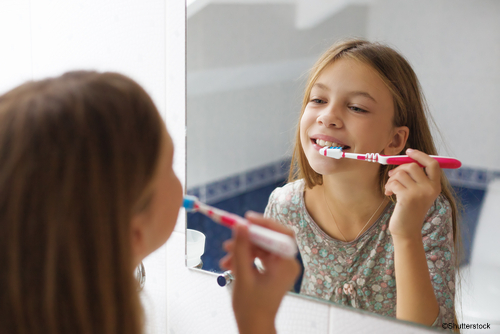
It’s very important for tweens and teens to take good care of their smile. This is because their teeth and gums are more vulnerable to dental issues now more than ever. So, to help you help your tween and teen keep their oral health in tip-top shape, Drs. Sloan, Aste, Skanchy Sr., and Skanchy Jr. have some helpful oral health tips.
First, make sure your tween or teen keeps up on oral hygiene. This means they need to use a soft-bristled toothbrush, fluoride toothpaste, an easy-to-use flossing product, and antibacterial mouthwash to brush twice a day and floss and rinse daily. The oral hygiene tools they use should have the American Dental Association Seal of Approval.
Second, make sure they drink plenty of water throughout the day and limit between-meal snacking. It’s also best to encourage them to reduce their sugar consumption as much as possible. These things are recommended because drinking water can wash harmful bacteria away, limiting between-meal snacking can make the teeth less vulnerable, and reducing sugar can reduce the chances of cavity development.
Third, make sure they visit our dentists every six months for a routine dental cleaning and exam. This is important because the treatment provided can deeply clean your tween or teen’s smile and help them avoid tooth decay and gum disease. It can also help our team monitor their oral health and perform additional treatments if necessary, like a fluoride treatment or dental sealant placement.
If you have any questions about dental health for teens in Riverton, Utah, please don’t hesitate to reach out to South Hills Dental Specialists. Our dental team is here to help you in any way we can, and we look forward to teaching you how to help your child take care of their smile!
“WHAT IS SPACE MAINTENANCE?”

One of the primary purposes of the primary teeth is to hold space for the developing permanent teeth. If a primary tooth is lost prematurely either due to infection, trauma, or ectopic eruption of other permanent teeth a space maintainer is recommended. It is much easier to MAINTAIN space than it is to REGAIN space through orthodontics. Typically, orthodontics is complicated if space regaining is needed and it increases treatment time and cost.
A space maintainer is placed to prevent drifting or tipping of the teeth further back in the mouth into the space of the lost tooth. The timing of space maintenance is critical as delayed space maintenance often results in significant loss of space within just days to weeks of loss of the tooth. Therefore, a space maintainer should be placed at the time of extraction if possible. These are called ‘Direct Space Maintainers”. (see image below). In some instances a prefabricated spacer can’t be placed at the time of extraction and a custom space maintainer is necessary. These are called “Indirect Space Maintainers”. (see image below).

DIRECT SPACE MAINTAINERS:
There are two types of direct space maintainers: Distal Shoe Spacers and Band and Loop Spacers. They share a purpose in maintaining space but one, the distal shoe, is necessary to guide the developing permanent 6-year molar that hasn’t come into the mouth yet, into proper position. This type of spacer has a metal plate that is imbedded at the extraction site and gives a guiding plane for the molar to erupt against mimicking the distal root of the primary tooth if it were still present.
Both distal shoes and band and loops can be made with either a crown attachment or a band attachment. Direct space maintainers are usually kept in place a short time. Often they’re replaced with an indirect space maintainer once the permanent molars are in enough to use as an abutment.


INDIRECT SPACE MAINTAINERS:
The two indirect space maintainers depend on whether it’s the lower or the upper arch that is affected. These are made by fitting metal bands on the permanent molars and taking an impression of the teeth. The model is then used to fabricate an appliance that is cemented on the permanent teeth and used either the lower front teeth or the palatal arch as anchorage. These spacers are more permanent and are not removed until the premolars are in ideal postion/occlusion.
Thanks for reading. I hope this was helpful. Feel free to call if you have any questions. 385-210-0000.
“IS DEEP SEDATION SAFE FOR MY CHILD?”

Many parents wonder if deep sedation is right for their child. Typically this stems from a fear that deep sedation, a drug-induced depression of consciousness, is unsafe. The short answer is:
The long answer is that the level of safety depends on the experience and protocol followed by the dentist and the auxilliary team used. At South Hills Pediatric Dentistry your child’s safety is our #1 priority! Therefore, our practice philosophy is that we do everything in our power to ensure that potential complications are minimized.
When there are complications during a deep sedation it almost always is associated with respiration. (i.e. aspiration or respiratory depression) Because of this ALL children treated at South Hills are cared for by a certified Dental Anesthesiologist and EVERY child is treated with a nasotracheal tube that ensures that your child’s airway is protected. This means that parents need not worry if their child’s respiration is depressed, the machine will automatically assist until the child can breath on their own. Many dental offices don’t place this nasotracheal tube as a standard of care. That doesn’t mean that your child isn’t recieving good care, it just means they are at increased risk for complications.
If your child has any complex medical conditions they may not qualify for treatment in-office but we would gladly schedule them at the hospital. This is because some medical conditions increase risk and therefore require monitoring post-treatment, sometimes over night. Healthy children can be treated for much cheaper in-office and can be discharged to home within minutes of treatment completion.
Sedation Benefits:
• Predictable Outcomes: Treating a potentially uncooperative child while asleep ensures that the quality of care is the absolute best it can be.
• Atraumatic Experience: Treating an anxious or young child while asleep will ensure that your child won’t have heightened dental anxiety for future appointments because there is no memory of the procedure and recovery is much easier.
• Quick Recovery: Many kids tolerate treatment well but struggle for the post treatment period due to the extended numbness. When a child is treated while sedated there are no injections or post operative numbness. Kids wake up happy and cavity free w/ little to no post operative pain.
• Relatively Inexpensive: To take a child to the hospital operating room it can cost thousands of dollars. In-office it costs a fraction of that amount ($365 for the first hour).
If you child has dental work that needs to be completed but you want to ensure that your child is treated safely while preventing dental post-traumatic-stress disorder, give us a call. We can help! 🙂
(For more information on other sedation options, read more HERE.)
Thanks for reading. I hope this was helpful. Feel free to call if you have any questions. 385-210-0000.
“ALL I WANT FOR CHRISTMAS…”

As a dentist, naturally, one of my favorite Christmas songs is “ALL I WANT FOR CHRISTMAS IS MY TWO FRONT TEETH”. This song was written in the 1940s by a 2nd grade teacher who realized that almost all of the children in his class were missing one or both of their front upper teeth. So, to keep with the season I thought I’d write a special blog post about timing of tooth loss explaining why 2nd graders tend to be the ones wanting their two front teeth from our favorite North Pole Hermit. 🙂
PHASES:
Children typically undergo two phases of tooth loss.
PHASE I: Phase I consists of transition of the front 8 teeth (4 upper, 4 lower). This phase typically starts around 6 years of age and ends by age 8 or 9. Hence, 2nd and 3rd grade being the typical ‘Toothless’ years.
PHASE II: Phase II consists of losing 12 teeth (4 canines, 8 primary molars). This phase can start as early as 9 years of age and finishes around 12 years of age but could last until age 14.
There is a wide range of variation from child to child even within the same family. A few general rules are:
1. If your child was delayed getting their baby teeth they will generally be delayed in transitioning to their permanent teeth.
2. Typically the transitioning teeth go from front to back with the exception of the upper canines, they tend to be the last tooth to transition.
3. Being dentally delayed is not a bad thing. I like seeing children delayed in getting their permanent teeth because it means more time with the ‘practice set’. 🙂
In the words of Dr. Seuss:
“And when you get your second set, that’s all the teeth you’ll ever get! So, don’t chew down trees like beavers do. If you do you’ll lose set number two. Don’t gobble junk like Billy Billings! They say his teeth have 50 fillings!”
Thanks for reading. I hope this was helpful. Feel free to call if you have any questions. 385-210-0000.
WITH GREAT POWER…

Children are capable of amazing things! Throughout my years treating children I’ve been amazed at what young children can accomplish. I’ve seen 3 year olds cooperate through procedures that adults would find difficult. I’m reminded of a quote that I love:
“With great power comes great responsibility!” Uncle Ben- Spiderman
While this statement is true and our children, undoubtedly, as I mentioned above, have great power, it is important for us as parents and dental providers to recognize our children’s limits. While children are capable of hard things, I caution parents that this great power should NOT require FULL responsibility when it comes to oral hygiene (i.e. brushing and flossing).
There are many studies that show that dexterity and perceptual ability, both crucial requirements for good oral hygiene, are not developed until children are AT LEAST 7-8 years of age. For this reason, along with lack of motivation, it is recommended that parents, not children, be responsible for at-home brushing and flossing until age 7 or 8. Putting oral hygiene responsibility on a 3 or 4 year old is bound to result in improper daily cleaning and will therefore result in early childhood tooth decay.
RECOMMENDATIONS:
• BRUSHING: Most kids go through phases where they refuse to cooperate or they want to do it by themselves. Children want to be indepedent. No matter how much your child fights it, complete brushing and flossing even if it means gently restraining them. Giving in to a child’s tantrum will only teach them that “If I scream loud or long enough I can get out of brushing”
• AGE: Most kids should be able to brush and floss independently by age 7 or 8. This is the EARLIEST that your child could take on the responsibility of home care. KEEP IN MIND, MOST 7-8 YEAR OLDS, THOUGH CAPABLE, ARE FORGETFUL AND UNMOTIVATED. So, I recommend parental supervision even into the teen years.
Thanks for reading. I hope this was helpful. Feel free to call if you have any questions. 385-210-0000.
CAN I GIVE MY BABY A BOTTLE TO SLEEP?

If there is ONE message I want ALL new parents to hear it is this:
NEVER LET YOUR CHILD FALL ASLEEP WITH A BOTTLE OR SIPP-CUP!!!
The biggest risk factor for developing ‘cavities’ in a young child is taking a bottle, with a sugar containing substance (i.e. milk, juice, soda, Kool-Aid, etc.), to bed. Prior to tooth eruption these sugars are relatively harmless but upon emergence into the oral cavity the teeth are exposed to the sugars, which are then converted to acid, which leach minerals from the newly erupted teeth causing cavitation and tooth decay. When a child falls asleep with a bottle or sippy-cup with milk or juice in it the sugary substance can pool in the child’s mouth or at the very least form a film on the tooth surface. Some parents will leave the bottle in the crib giving the child constant access to the liquid if they awake in the middle of the night. Because the design of the bottle/sippy-cup deposits the liquid directly behind the upper front teeth, most of the time these cavities can go unnoticed for a VERY long time and often result in early tooth loss, infection, and/or pain. It is because of this that ALL Pediatric Dentists and Dentists alike adamantly oppose giving children a bottle or sippy-cup at bedtime.
WHY DO PEOPLE DO IT?
• IGNORANCE: Parents are unaware of the risks and complications
• EXHAUSTION: Sleep is in short supply in any household with an infant. If a bottle helps the child sleep through the night that means more sleep for baby AND for mommy.
• HABIT: Many infants fall asleep with a bottle or with breastfeeding from birth. This habit is very hard to break upon eruption of the first tooth. (It’s like taking away your husband’s TV remote….)
RECOMMENDATIONS:
• DON’T START: The best way to break a bad habit is to never develop one. It may sound easier said than done when you’re trying to put your screaming child to bed without success but your child will develop a nighttime routine eventually with or without the bottle.
• QUIT NOW
• COLD TURKEY: I recommend stopping the bottle habit at bedtime immediately. Undoubtedly this will result in a couple hard nights as the child will likely not sleep well but they will eventually adapt.
• SUBSTITUTION: Try putting water in your baby’s bottle at bedtime. If your child is used to falling asleep with milk, gradually dilute the milk over a short period until eventually it’s 100% water (i.e. Night 1 = 90% Milk + 10% Water; Night 2 = 80% Milk + 20% Water, etc.). NOTE: EVENTUALLY YOUR CHILD WILL LIKELY REALIZE THAT IT’S MORE WATER THAN MILK AND WILL HAVE A ROUGH NIGHT. Despite this, stick with it!!!
• BRUSH: If a parent is unwilling to give up the bottle at bedtime, at the very least, the parent should brush the child’s teeth afterward w/ a fluoride toothpaste. Many parents don’t like this idea because they worry that it will wake the child up and put them back at square one. That may be true unfortunately, but the alternative is putting your baby at risk for severe tooth decay before they can even walk.
Thanks for reading. I hope this was helpful. Feel free to call if you have any questions. 385-210-0000.
HOW TO PREPARE YOUR CHILD FOR A DENTAL VISIT

Children and grown-ups alike are typically scared of the unknown or anxious to new things. Since the dental office is unfamiliar to most children it is not unusual for children to be hesitant, nervous, or even scared to come in. The good news is, since anxiety in the dental setting is as expected as tummy aches after halloween, pediatric dentists are specialized in reducing anxiety and in ensuring a positive experience for your child. Not surprisingly, a lot can be done at home to help reduce your child’s hesitation in coming to the dentist. Here are a few things that YOU, as a parent, can do to help your child prepare for his or her dental appointment:
WHAT YOU CAN DO:
BE POSITIVE: Children mimic or shadow parents unease or anxiety. If mom is nervous for their child’s dental appointment then the child will sense that hesitation and imagine the worst. If mom or dad is relaxed then the child will assume that there is nothing to worry about. REMEMBER, DENTISTS ARE HERE TO HELP, NOT TO HURT!
TALK POSITIVELY: Children are listening even when we think they are not. If a mother tells her child, “Junior, you are going to the dentist tomorrow.” and then overhears mom or dad talk about how awful their last root canal was, the child will unsurprisingly become fearful. Conversely if a child only hears the exciting aspects of the dental office, like, “I love going to see Dr. Bart and Dr. Matt. They’re nice, they sings fun songs, and even gives prizes to big helpers.” then the child will be excited to meet Dr. Bart and Dr. Matt and will want to be brave in order to get a prize.
PLAY PRETEND: Children love to role play. Whether it’s having a tea party, putting on a ballet recital, or being the ‘nurse’ when mommy is ‘sick’, kids’ imaginations are amazing. By role playing ‘Dentist’ with your child they will associate the idea of going to the dentist with FUN. Some household items can mimic dental equipment: A Recliner = The Dental Chair; A Spoon = The Mirror; A Straw = The Suction; A Flashlight = The Dental Light; A Popsicle Stick = The Tooth Counter/Explorer; be creative. Let your child pretend to be the dentist and let THEM brush YOUR teeth, floss, and then switch places.
ESTABLISH RULES: Children are great at exceeding our expectations as long as they know what our expectations are. Going to the dentist can be fun but just like going to school it’s important to follow the rules. For example: We don’t say “No” to Dr. Bart or Dr. Matt. We always sit still and keep our hands on our tummies. If we have a question we need to raise our hands while Dr. Bart or Dr. Matt is looking in our mouth.
READ BOOKS: There are lots of books about going to the dentist. Many of them are very good. As most dental anxiety comes from the unknown it is good to expose children to the things they’ll see while at the dentist. Because of this, I even wrote and illustrated my own book about going to the dentist called THE TOOTH FIXER. (You can read the entire book HERE). It’s a book that compares things done and seen at the dentist with things that they are familiar with. Here is an example of one of the pages:

BE OPEN & HONEST: Don’t try to hide things from your child. Children will ask questions like, “Will it hurt?” or “Am I gonna get a shot”. If a parent or the dentist is dishonest with the child in answering these questions it breaks their trust in us. When a child asks if a filling is going to hurt, I explain to them that fillings don’t hurt because I make sure the tooth is sleeping before I start fixing it. In response to whether or not they will be geting a shot, the answer is “The dentist doesn’t give the same kind of shots as the doctor. When he puts your tooth to sleep you’ll feel a pinch in your gums but the pinch will go away in a matter of seconds.” You can demonstrate a small pinch on the back of their hand and explain that the dentist rubs jelly on the gums first in order to make the pinch hardly even noticeable. Don’t go into more detail than is necessary and always present things in a positive way.
As always, thanks for reading. We want all patients to be confident and comfortable in our office. Let us know how we can help you. 385-210-0000.
AT WHAT AGE SHOULD MY CHILD FIRST SEE THE DENTIST?

In the past it has been believed that going to the dentist is not necessary until your child is 5-6 years old, unless the parent has a dental concern. The reality is that children should be seen much earlier than that for a variety of reasons. Early dental visits are critical in establishing good oral habits, maintaining a healthy smile, and monitoring your child’s growth and development. The AMERICAN ACADEMY OF PEDIATRIC DENTISTRY has released a GUIDELINE stating, “Parents should establish a dental home for infants by 12 months of age.” At South Hills Pediatric Dentistry, we couldn’t agree more. Here are the primary reasons for doing so:
PREVENTION
EDUCATION: The first dental visit is as much for the parent as it is for the child. Not only will the dentist perform an oral exam on your child but a good portion of the first appointment will be spent educating parents on how to maintain a healthy smile throughout childhood. This information is usually very specific to your child as we base the information on your child’s individual risk factors. Topics discussed typically involve: cavity development, disease transmission, habits, trauma, tooth eruption sequences, teething, diet review, growth patterns, fluoride recommendations, genetics, etc.
RISK ASSESSMENT: For each new patient it’s important to determine their individual risk for oral disease. This assessment helps to develop an individual prevention plan that is specific to your child. Risk assessment usually involves assessing the child’s: fluoride exposure, home care, parental involvement, cavity status, plaque level, dietary habits, food preferences, medical complexity, and family history.
ANTICIPATORY GUIDANCE: Anticipatory guidance is aimed at anticipating future oral problems and taking steps to avoid them. For example, steps can be taken at a young age to reduce the need for early phase orthodontics or the dentist may anticipate fall related or sport related injury and advise on how to prevent it or manage it if it does occur.
ORAL HYGIENE INSTRUCTION: Oral hygiene instruction (instruction on proper brushing and flossing technique) is good to receive when your child’s teeth first come in. Many parents have a difficult time brushing and flossing their uncooperative or precooperative child’s teeth but regardless of cooperation level oral hygiene is indispensable. The dentist can give invaluable instruction on how to brush the most obstreperous child’s teeth.
EARLY INTERVENTION
ORAL CANCER SCREENING: Every child should have an early cancer screening with every exam. While rare in children, early diagnosis and intervention are critical in the treatment of these children.
DIAGNOSIS/COLABORATION: Early diagnosis is important for many reasons (See below) but did you know that many systemic concerns have oral manifestations and often pediatric dentists are the first to recognize signs of GERD, Crohns Disease, or Osteogenesis Imperfecta? Pediatric dentists and pediatricians can work together to ensure early diagnosis of many conditions.
TREATMENT PLANNING: Dental decay can occur as soon as the first tooth comes into the mouth. Treatment while the lesion is small can halt the progression of the decay before pain, infection, or loss of teeth occurs. Many parents are anxious because they don’t know how dental work can be completed without traumatizing their young one. Many treatment options are available and have far fewer risks than progression of dental infection.
PERSONALIZED PREVENTION PLAN: Once a risk assessment, screening, and treatment plan are completed/formulated it’s possible to determine the best course of action to keep your child healthy. Some children require more frequent dental visits for monitoring, some may benefit from more regular fluoride application, while some children are determined to be at very low risk for dental infection and their growth and development is such that less frequent visits are needed. Every child is different so every child’s plan can vary.
So, to sum up this entire blog post. At what age should your child first see the dentist?
AGE 1
Thanks for reading!!!
For more information, don’t hesitate to contact our office. 385.210.1000
ARE CAVITIES GENETIC?

Frequently I hear parents say things like, “He gets his bad teeth from his dad.” or “I’ve got bad teeth. Dad has bad teeth. Junior will undoubtedly have bad teeth too.” So, is there no hope for Junior? All of us know someone who NEVER brushes or flosses who seems to never get cavities. Conversely, we all know someone who brushes and flosses religiously who has a mouth-full of fillings. Is decay genetic, or is there more to it?
The simple answer is, there is no simple answer. There are some genetic components that influence a child’s susceptibility/likelihood of developing tooth decay but susceptibility does NOT doom Junior to a lifetime of oral disease. For this week’s blogpost I’d like to clarify what aspects of oral health are genetic and what aspect of oral health is behavioral and preventable. By recognizing what aspects we have control over we can take action to prevent cavities.
OUT OF OUR CONTROL: (GENETIC/INHERITED/AQUIRED)
ENAMEL QUALITY: Enamel is the outer coating of the teeth. It is the HARDEST substance in the human body. Harder even than bone. Under the enamel is a layer called dentin. Dentin is quite soft. Enamel is a natural barrier to infection and decay. One component to tooth decay is poor enamel quality. Enamel can be thin, brittle, or low in mineral content. This can be genetic or the enamel quality can be affected during development. Typically, enamel is resistant to cavitation as long as the oral pH is above 5.5. If enamel quality is poor cavitation occurs easier.
SALIVARY QUALITY/QUANTITY: Saliva is good for more than shooting spit-wads. Saliva has components that not only assist with digestion but buffer acids. Cavities form because the sugars we consume are converted to acid by the bacteria that live in our mouths. These acids burn holes in our teeth by leaching the minerals from the teeth. Good quality saliva can buffer these acids quickly and within 30 minutes our oral acid level is normal. If individuals have poor salivary production, low buffering capacity, or take medications that inhibit salivary production they will be at higher risk of getting cavities despite their best efforts because the mouth can’t resist those acids as well.
GASTRICK REFLUX: Individuals with frequent gastric reflux will develop erosion of their tooth structure. This erosion thins the enamel and makes the individual more prone to getting cavities.
TRANSMISSION/BACTERIAL COLONIZATION: THIS MAY BE THE MOST IMPORTANT FACTOR that determines why people who have bad teeth tend to have children with bad teeth. In order to get cavities, you must have three things. Teeth, Bacteria, and Sugar. Believe it or not, EVERYONE has bacteria that live in their mouth. These bacteria are not present in the womb but shortly after we are born varying bacterial types take up residence in our mouths. So, how do we get these bacteria? Just like any disease, bacteria are transmitted from person to person or from object to person. Children are constantly putting things in their mouths but babies are also constantly getting kisses from Mom, Dad, brothers, sisters, neighbors, Aunt Betty, etc. Also, parents often clean dropped pacifiers by licking/sucking them clean and then putting the pacifier back into the child’s mouth. If siblings or children share utensils or cups they’re also sharing their cavity bugs with one another. Now, not all bacteria are bad. Many bacteria in our digestive systems are vital to acquiring adequate nutrition from the foods we eat. Some bacteria though ARE bad. These bad bacteria are NOT present in everyone’s mouth or if they are present they’re present in varying levels. If mom or dad have bad teeth, it’s because they happen to have the ‘bad’ bacterial strain that causes cavities and if mom and dad have those bacteria studies show that 87% of children have the same bacteria as their parents. This likelihood is even greater if the parent does not take care of their own teeth and has active decay. Unfortunately, once the cavity forming bacteria take up residence during childhood there’s little to do to evict them.
WITHIN OUR CONTROL: (BEHAVIORAL/HABITUAL)
DIET: As I mentioned above, cavities form because the bacteria in our mouths convert the sugars that we eat or drink into acid. These acids make holes in our teeth. Sugar is in almost everything that we eat so we can’t realistically remove sugar completely from our diets. We CAN reduce the frequency of sugar intake. Sugary drinks should be limited to mealtime only. Candy and soda should be limited to special occasions only. By limiting sugar consumption to mealtime only we ensure that our mouths can recover between meals.
HYGIENE: We brush and floss in order to knock the bacteria (aka Sugar Bugs) off of our teeth. Unfortunately, children don’t have the dexterity or perceptual ability to brush by themselves until around age 7-8. If sugar-bugs aren’t knocked off effectively 1-2 times per day cavities are likely to develop.
INHERITED BEHAVIORS/HABITS: A key aspect to cavity development is behavior. Where do children get their eating habits and hygiene behaviors from? Parents of course. If mom and dad are candy junkies their kids are likely to pick up on those behaviors. If mom and dad are brushing and flossing daily, their children tend to have a heightened awareness to oral health as well.
FLUORIDE: Fluoride has been proven to reduce the prevalence of tooth decay. Fluoride is incorporated into developing teeth to make them more resistant to acid. Fluoride is so advantages that communities throughout the US put the fluoride into our water supplies. Besides water fluoride topical fluoride is very important. High concentrations are applied by your dentist but we recommend fluoride toothpaste for ALL AGES. If your little one can’t spit reliably though we recommend only a light smear.
So, are cavities genetic? In my humble opinion… minimally so. An individual with bad genetics is more PRONE to getting cavities due to susceptibility but there are many aspects of oral health that can be modified that can increase a child’s chances of staying healthy
RECOMMENDATIONS:
1. Have your child seen by the dentist by age 1 in order to determine your child’s personal prevention plan.
2. Establish good brushing habits AS SOON AS the first tooth comes in.
3. Parents, take care of your own teeth. By getting your cavities fixed the load of bacteria present in your mouth decreases making it less likely to transmit these bacteria to your kids.
4. Don’t share utensils, cups, etc.
5. Don’t clean pacifiers with your mouth.
6. Don’t give into the tantrums. If a child fights you every time you go to brush their teeth, never give in. They’ll eventually learn that it’s not worth struggling and they’ll submit. If you give in to the tantrums, they’ll just learn that they can get out of it by screaming harder.
7. Chew sugar-free gum after each meal.
8. If your child has acid reflux, get them evaluated by their pediatrician.
9. Make a family rule, “Water only between meals!”
10. Healthy snack options should be the only snacks available (e.g. fresh vegetables, fruits, string cheese)
11. Parents should brush FOR their children each morning and night.
Thanks for reading!!!
For more information, don’t hesitate to contact our office. 385.210.1000
WHY SAVE BABY TEETH?

Quite often I’m asked, “What’s the sense in fixing it, it’s just a baby tooth?”. It’s understandable that parents question the need to fix a tooth that will only be in the child’s mouth for a short time. Honestly, prior to my specialty training I thought the same way. It wasn’t until I saw the effects of primary tooth neglect that I realized the importance of the ‘baby teeth’ and their care.
Primary teeth have many important purposes:
1. Function
2. Speech
3. Cosmetics
4. ‘Space Holders’/Tooth Guidance
FUNCTION: It’s clear that without teeth children cannot effectively chew. What’s less clearly understood is that a tooth doesn’t have to be missing to be non-functional. Tooth pain is one of the leading causes for school absences in the United States. Tooth pain is very real and can prevent a child from being able to focus in school. Tooth pain or missing teeth can also affect nutrition. So, reason number 1 for maintaining and fixing baby teeth is to prevent early tooth loss and dental pain. By keeping your child’s teeth healthy we ensure that they can continue to function properly not only by allowing them to chew physically but healthy teeth keep your child intellectually and nutritionally ready to take on the world.
SPEECH: Children are very adaptable. If your child loses a baby tooth at an early age, your child will likely compensate for the tooth loss and adapt there speech so as to be understood. While this adaptability is great, some of these compensatory speech patterns can become permanent and will effect their speech throughout life. Maintaining the anterior teeth will minimize these compensatory speech changes and improve their communication skills at the most influential time in their lives for learning.
COSMETICS: Cosmetics are important to both the child and the parent. Early loss of a tooth, particularly in the front, can result in poor cosmetics. Often peers can be very cruel during the grade-school years, which means bullying and ridicule that can cause a child to loose self-confidence. While there are situations where medical necessity of extraction out weighs cosmetic concern it’s our goal to maintain esthetics in all situations possible.
SPACE HOLDERS/TOOTH GUIDANCE: One of the least recognized purposes of the primary teeth within the general public is the baby tooth’s role in maintaining space for the adult teeth to come in. When a baby tooth is lost prematurely the teeth posteriorly (ie further back in the mouth) will drift or tip forward into the space needed for the adult teeth that replace the baby teeth around the ages of 11-12. This drifting makes orthodontic correction much more difficult, more expensive, and it lengthens treatment time for the orthodontist. Restoring primary teeth to health while they are present ensures that decay and infection do not progress to the point where loss of space is possible. Note: This space loss doesn’t only occur in situations where a tooth is lost or removed. Space loss also occurs when decay between the teeth reaches a point where the tooth structure is compromised and the adjacent tooth will tip/drift into the space provided by the cavity.
The above mentioned purposes of primary teeth certainly justify fixing primary teeth whenever possible. Other reasons we don’t want to neglect tooth decay in the primary dentition is because we want to prevent progression of decay to the point where pain or infection present themselves. An abscess present on a baby tooth has the potential to spread into the soft tissues of the face, causing a facial cellulitis (ie swelling of the face) and in some cases can be life threatening. Abscess’ of the primary teeth can also alter the development of the permanent teeth as they develop in the bone beneath the baby tooth.
There ARE some situations where restoration of primary teeth is not indicated but those situations are case based and more infrequent than the indications for restoration. At South Hills Pediatric Dentistry we want your child to be as healthy and happy as possible and your child’s teeth play a huge role in their overall health and wellness.







